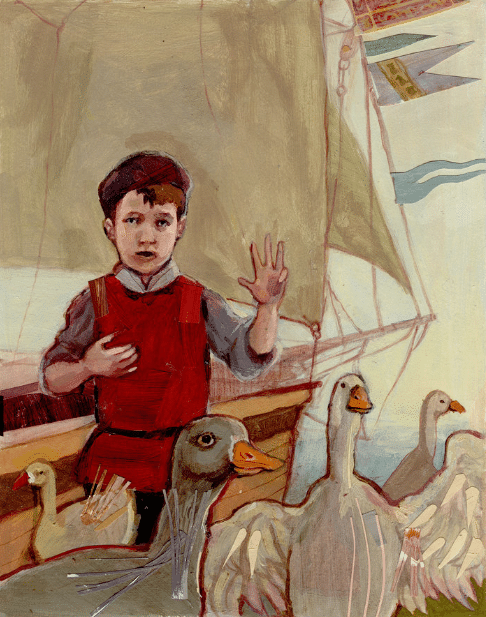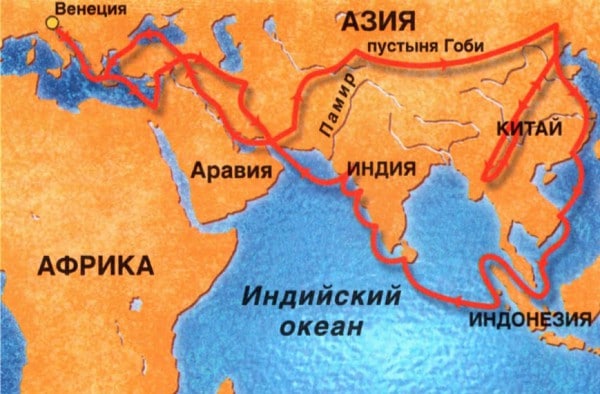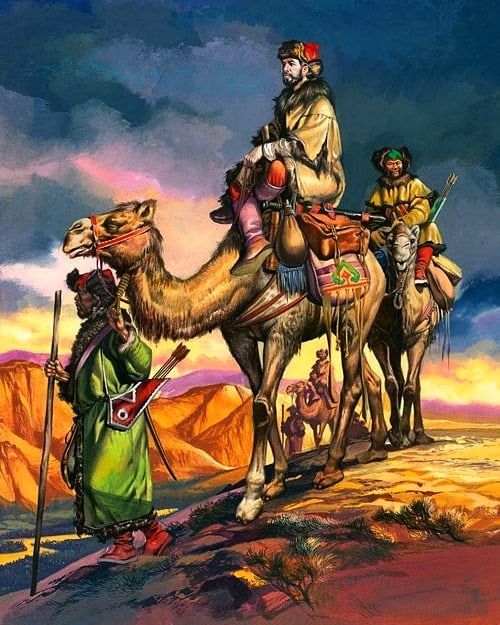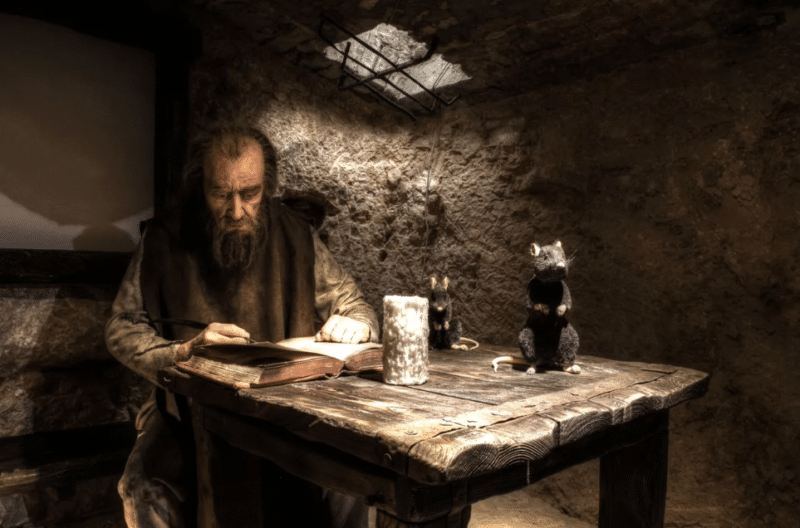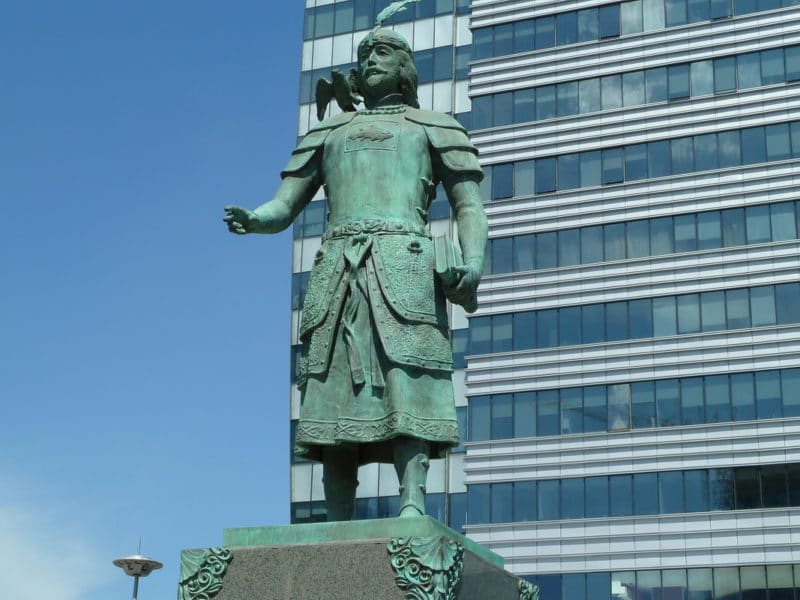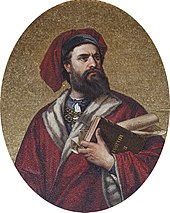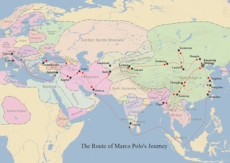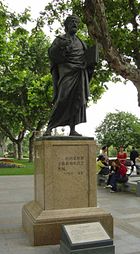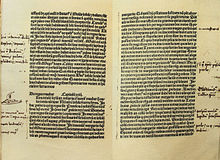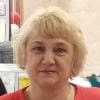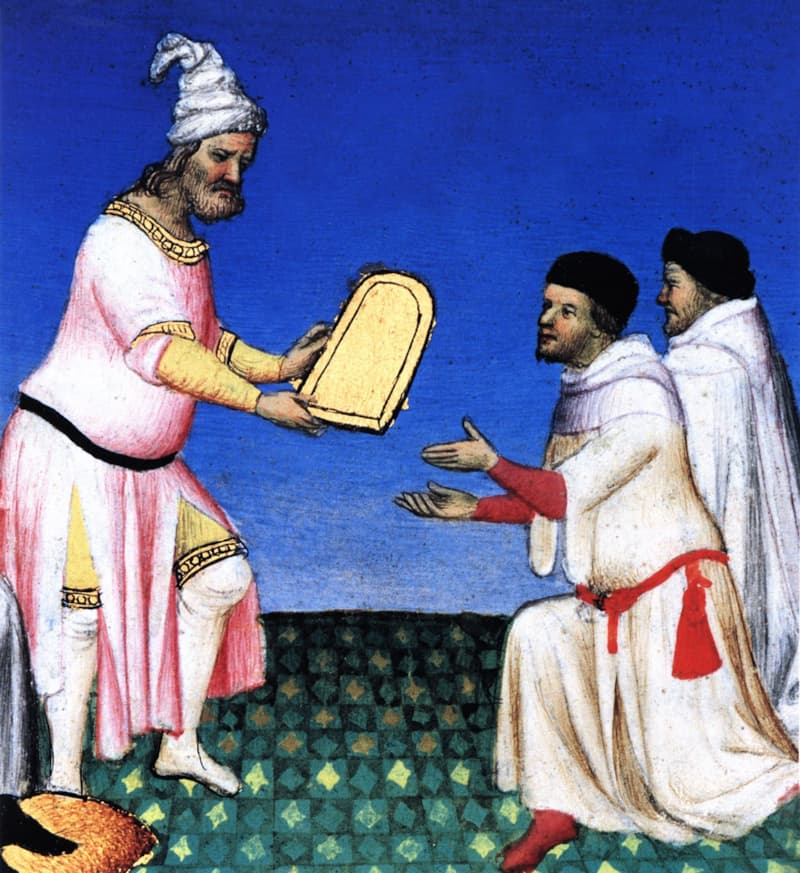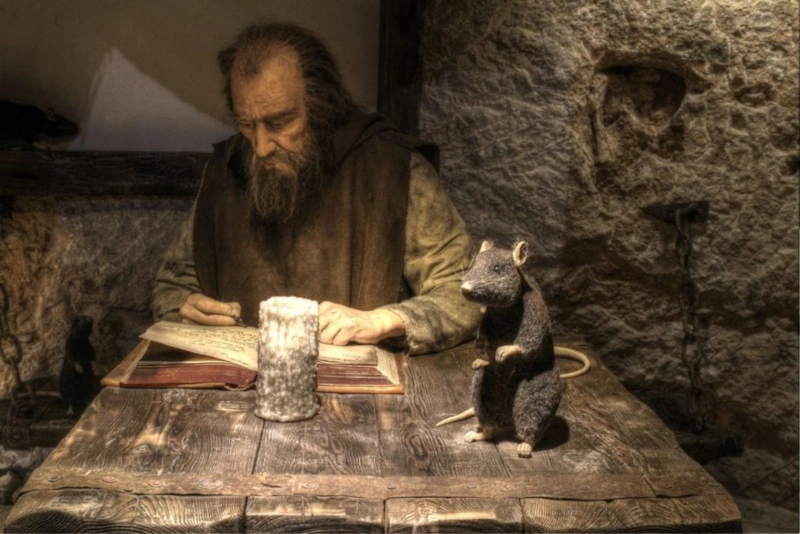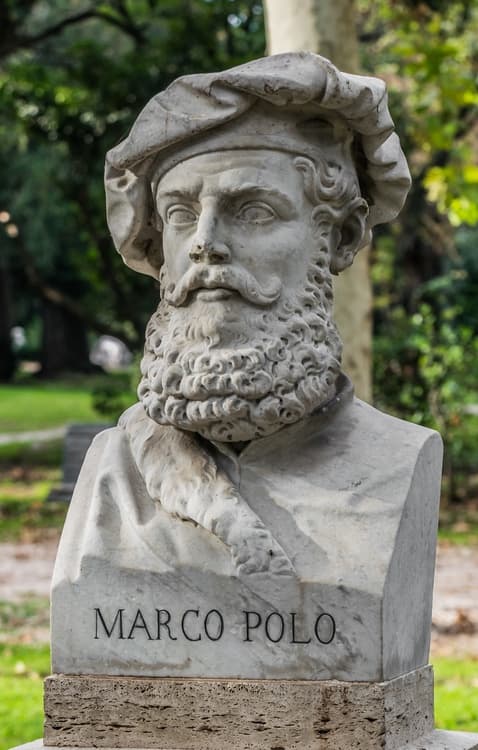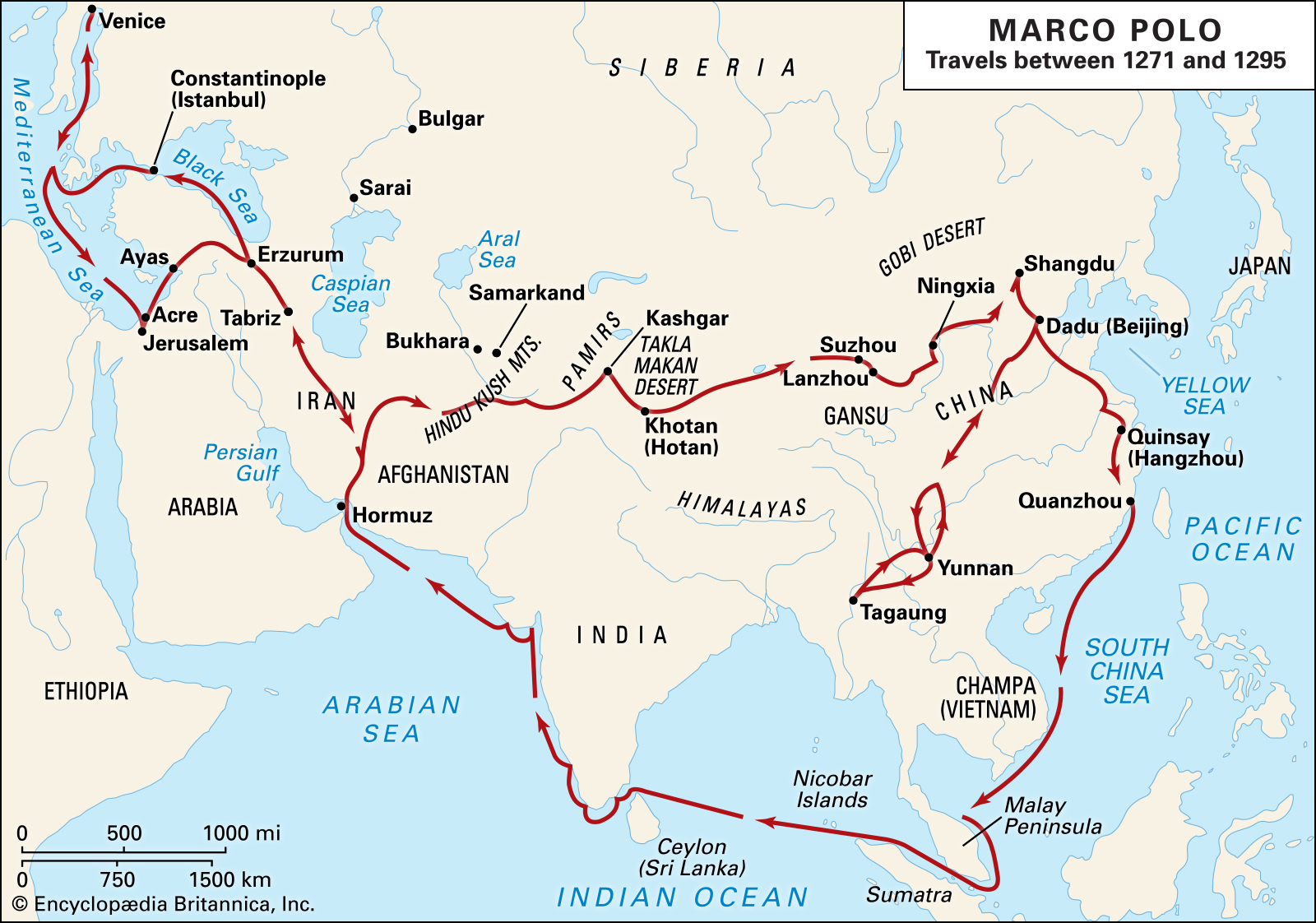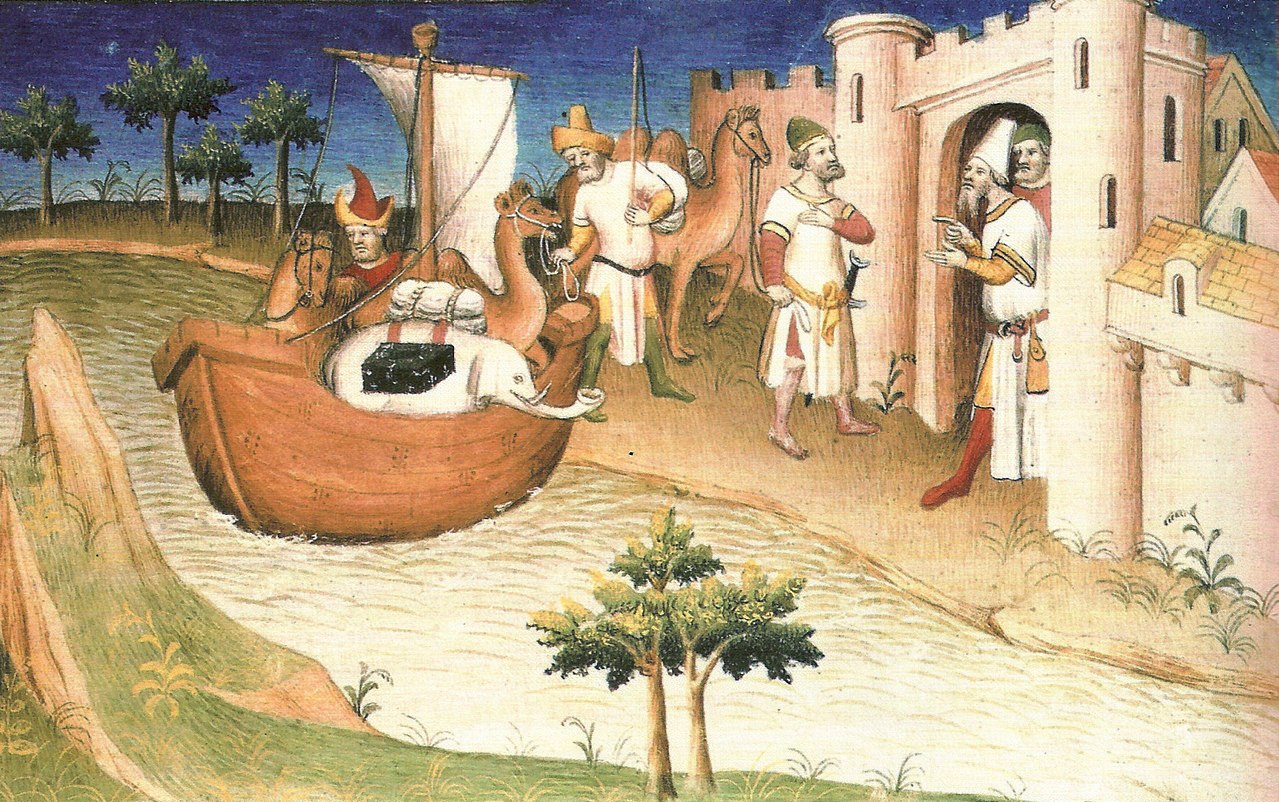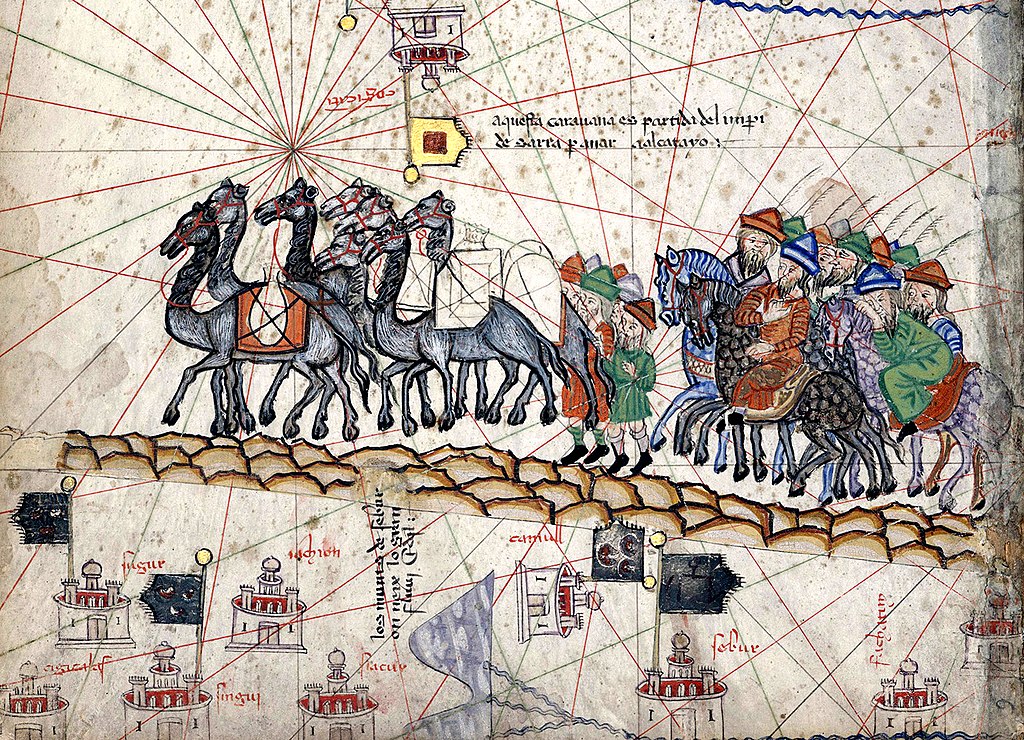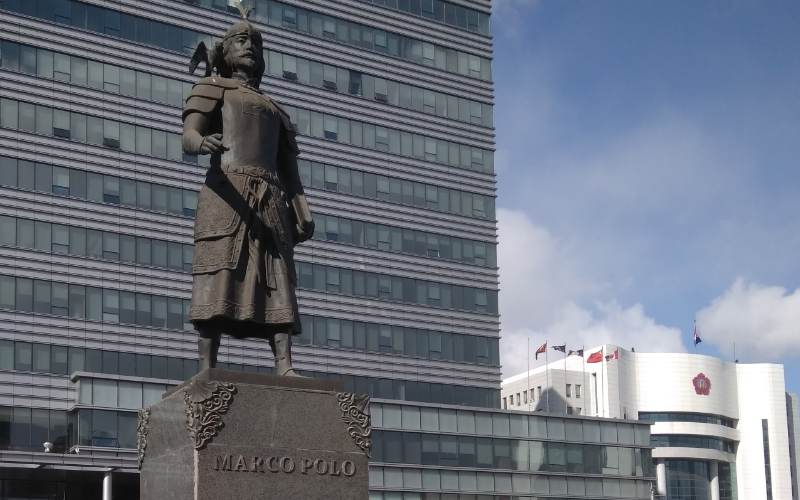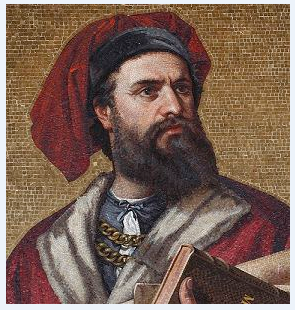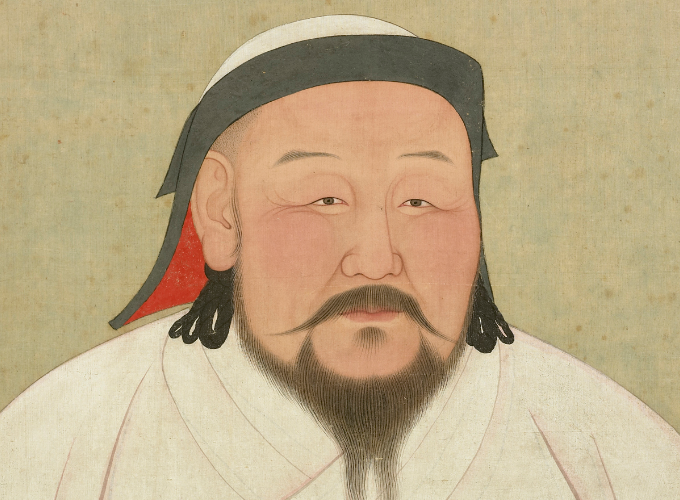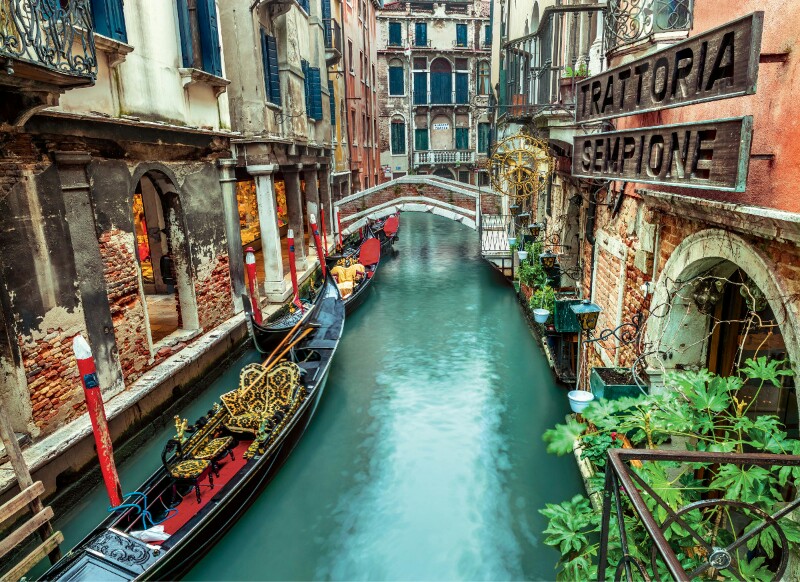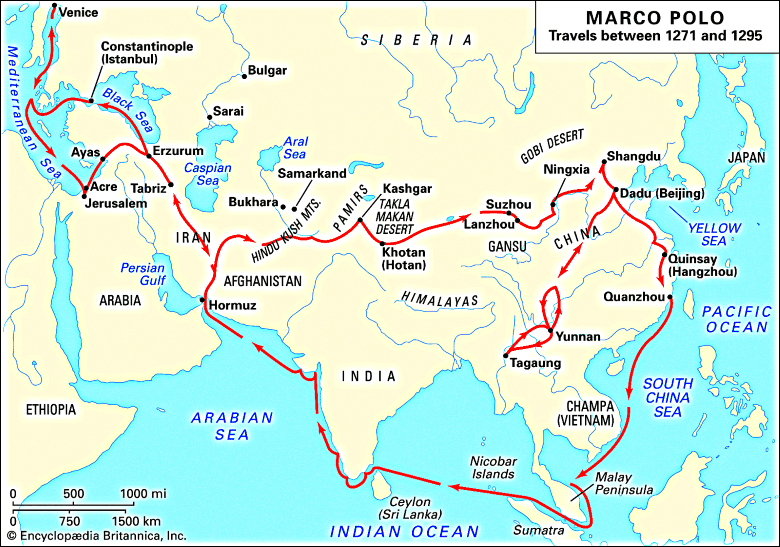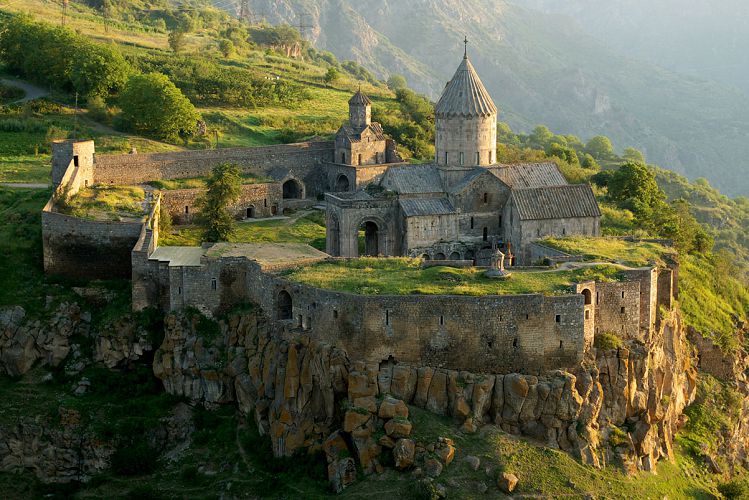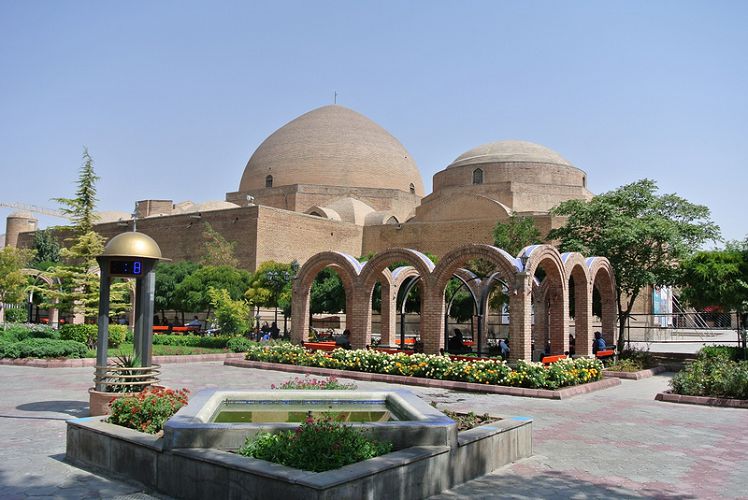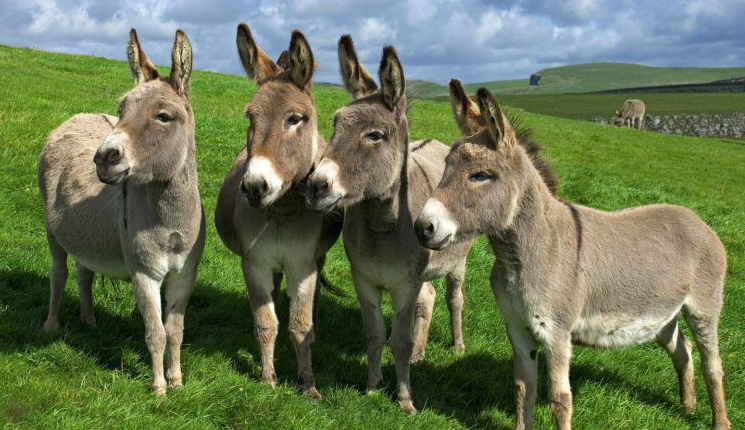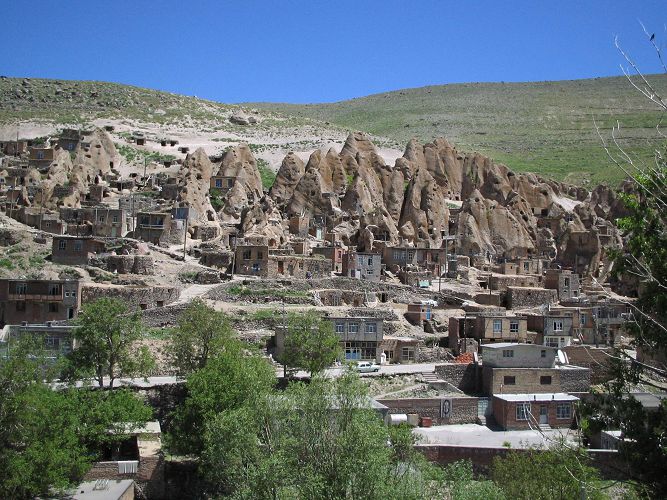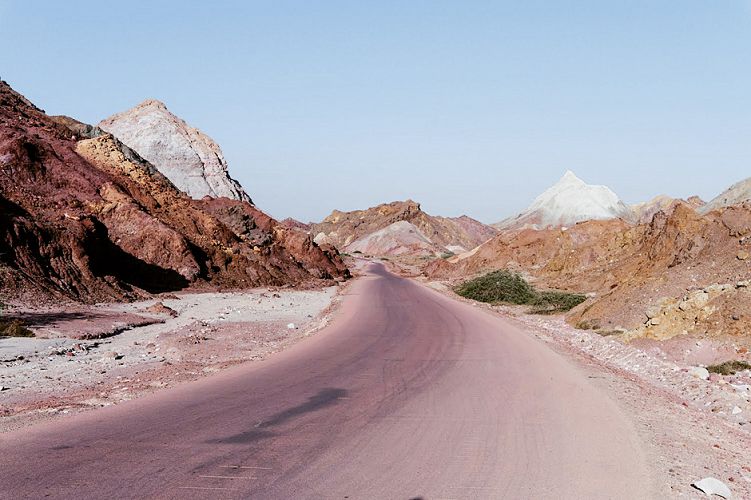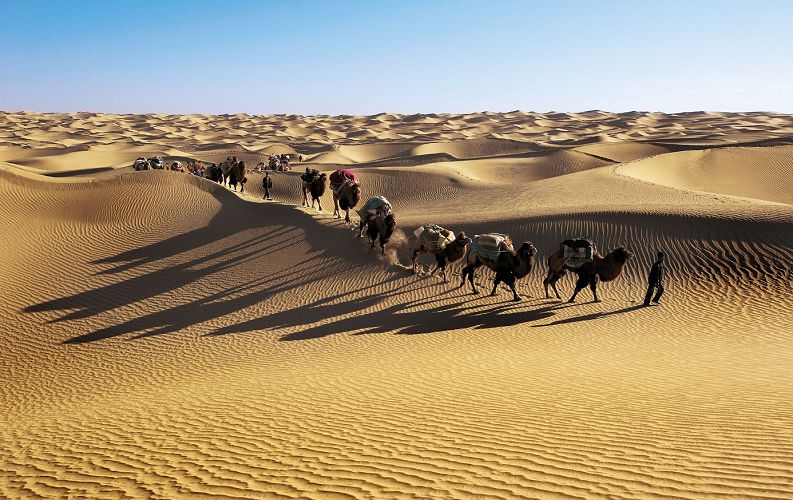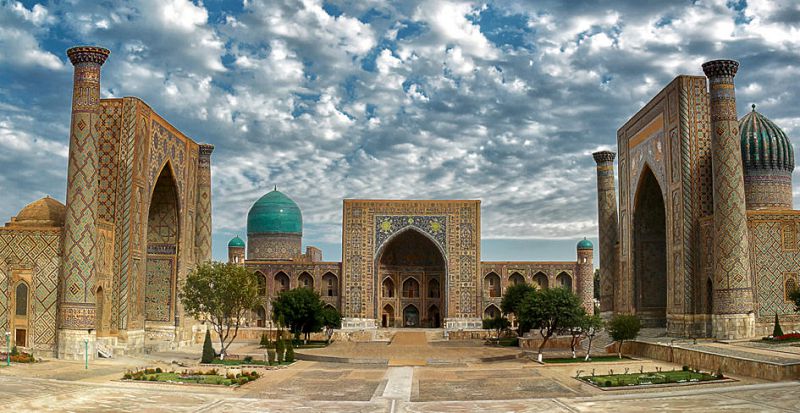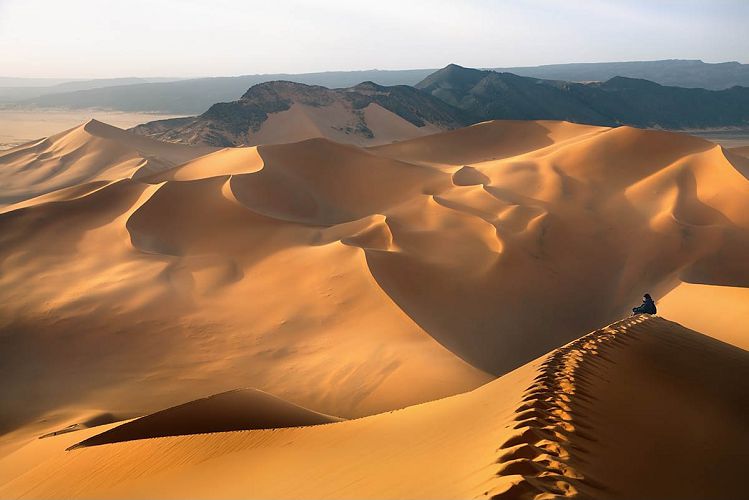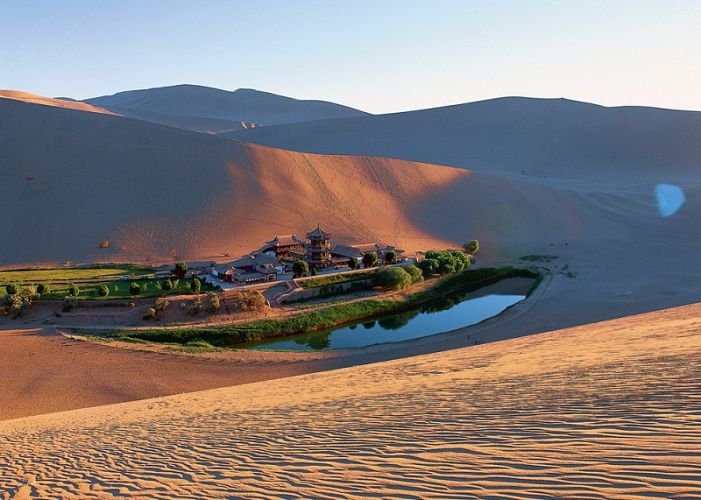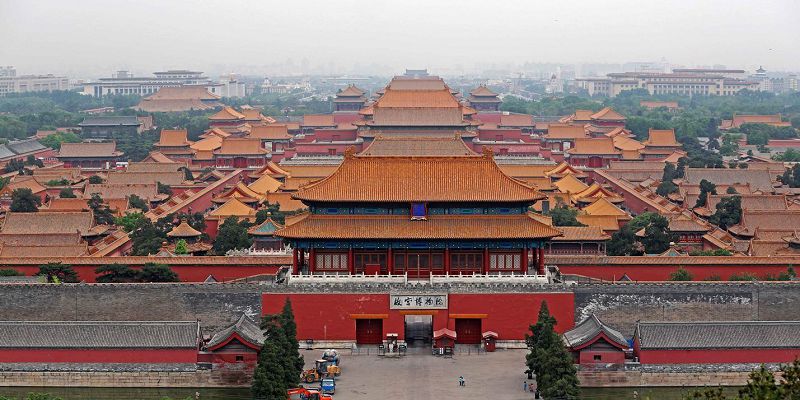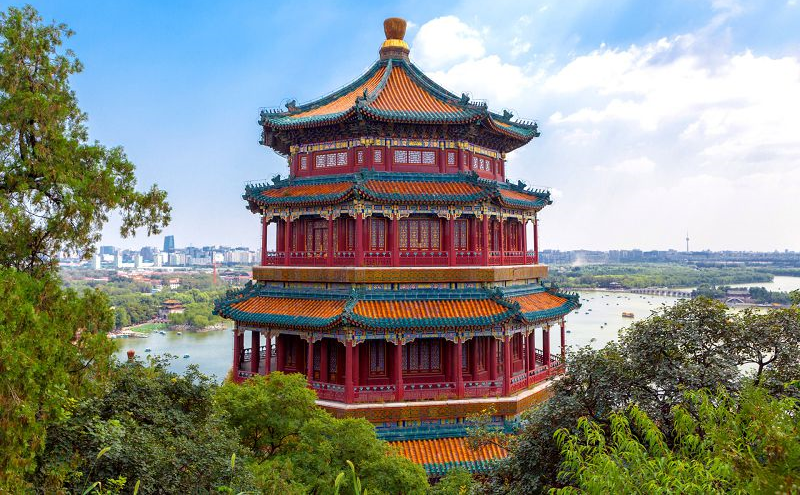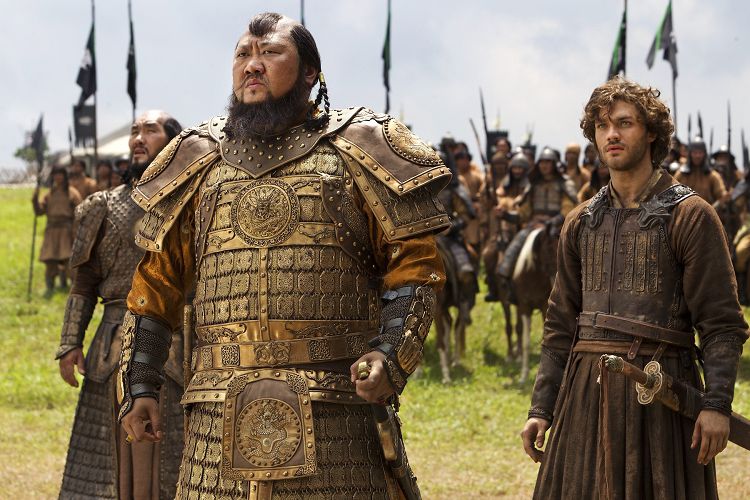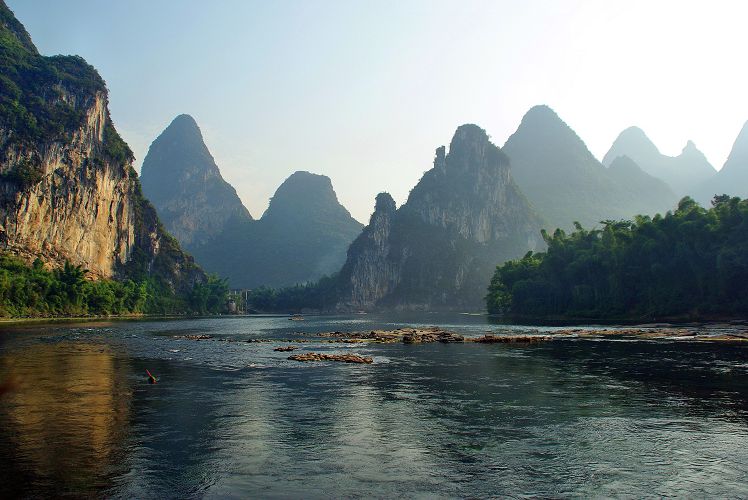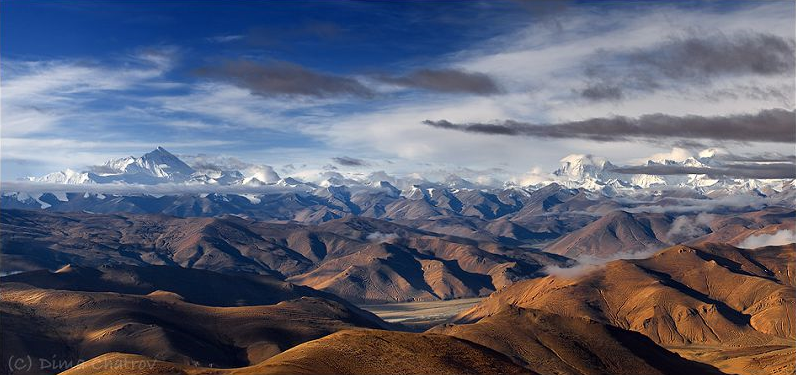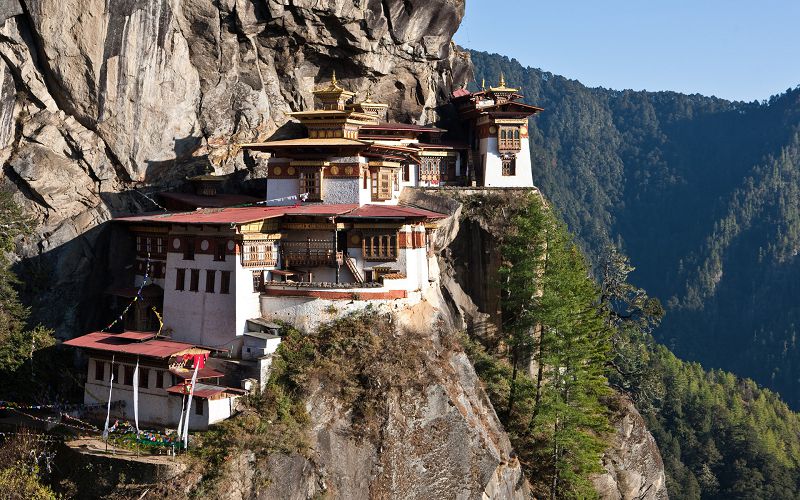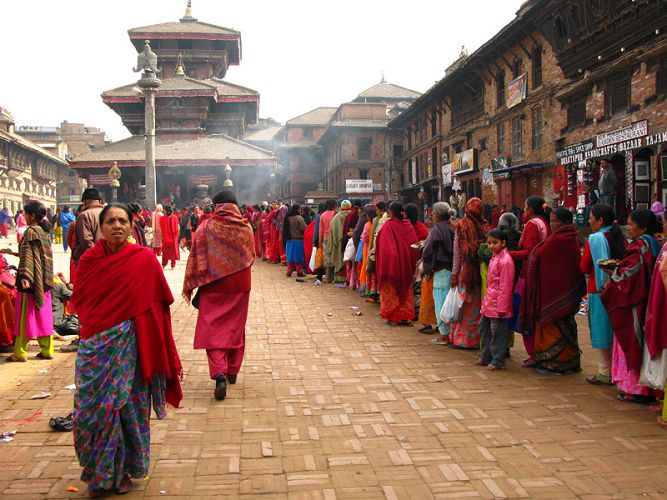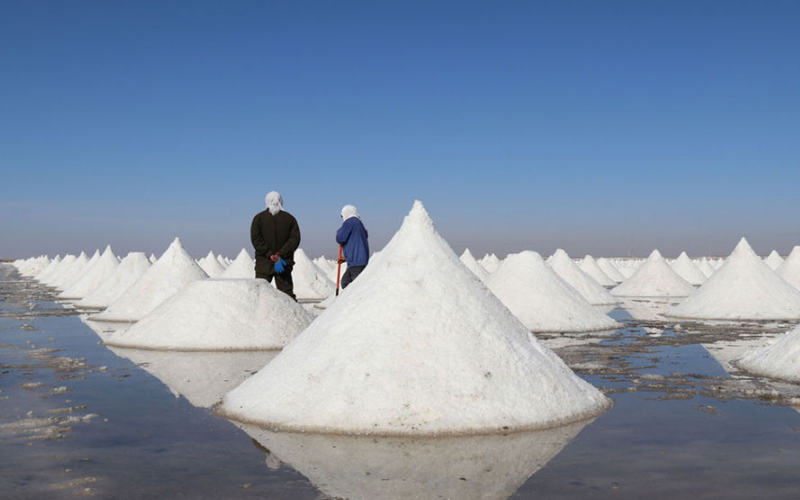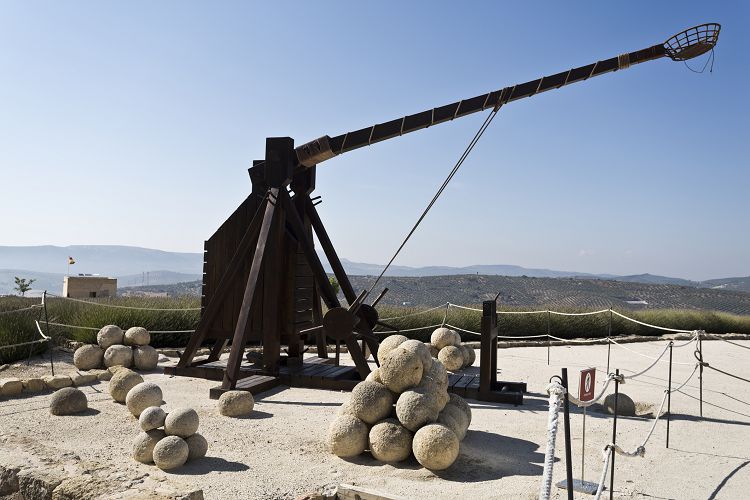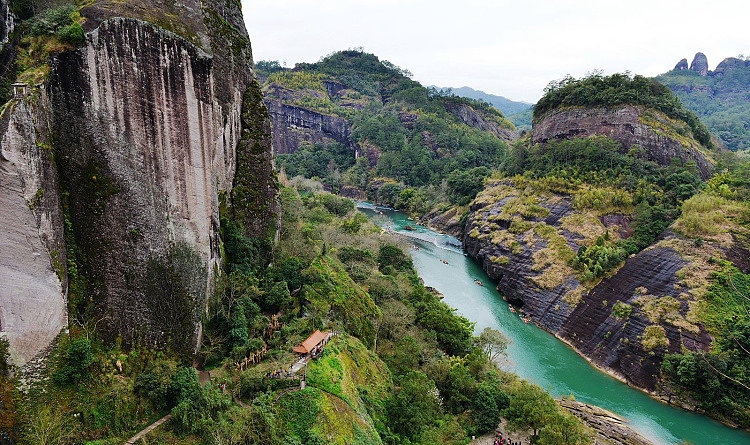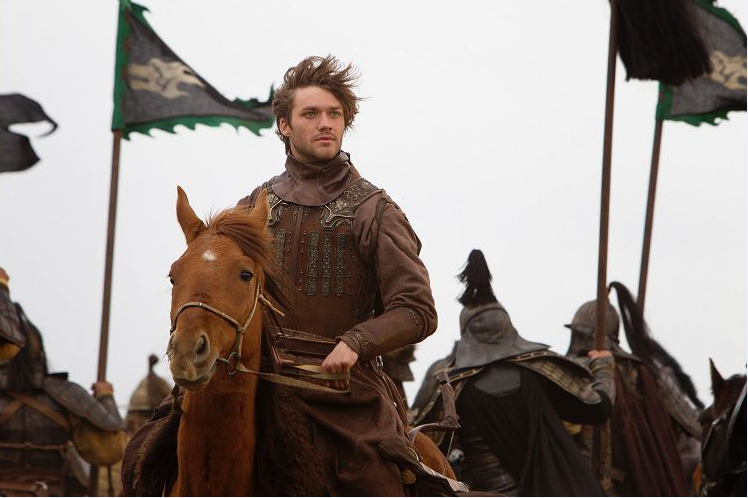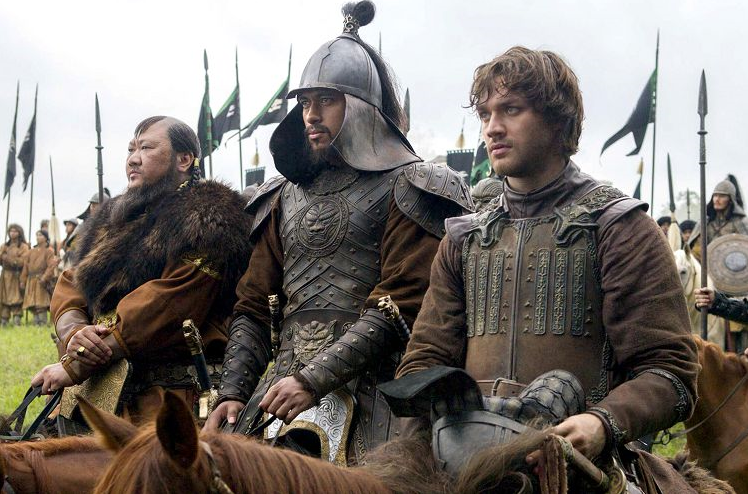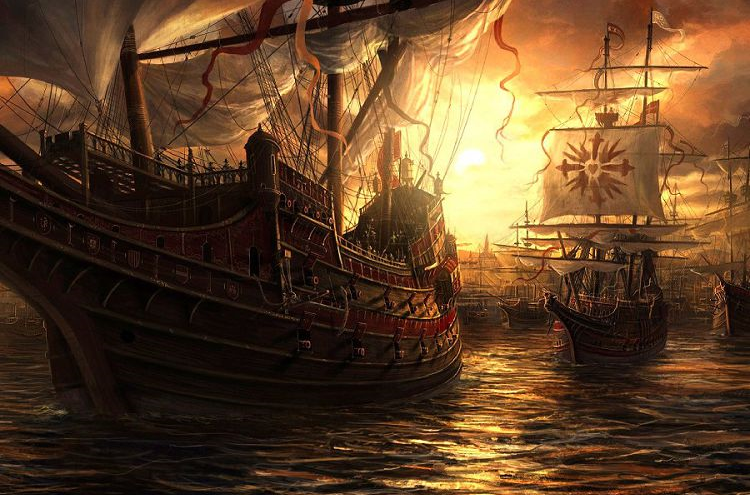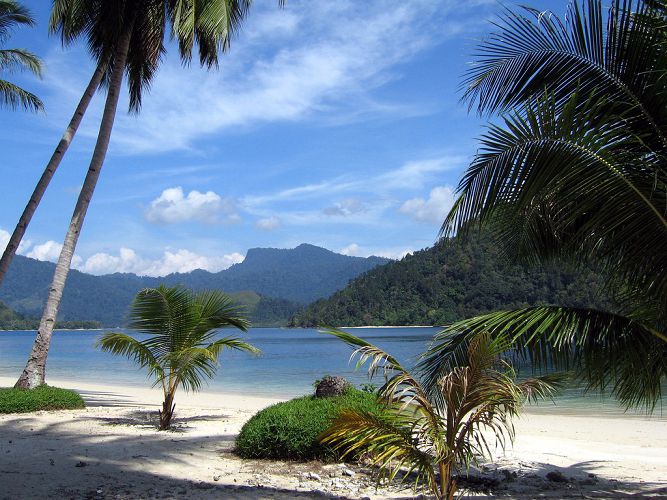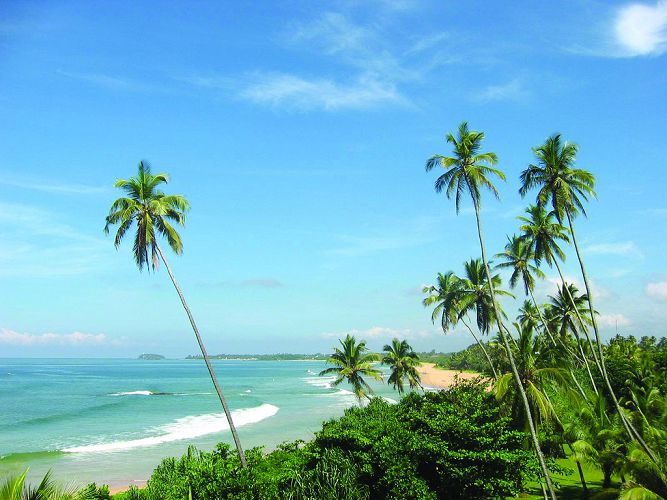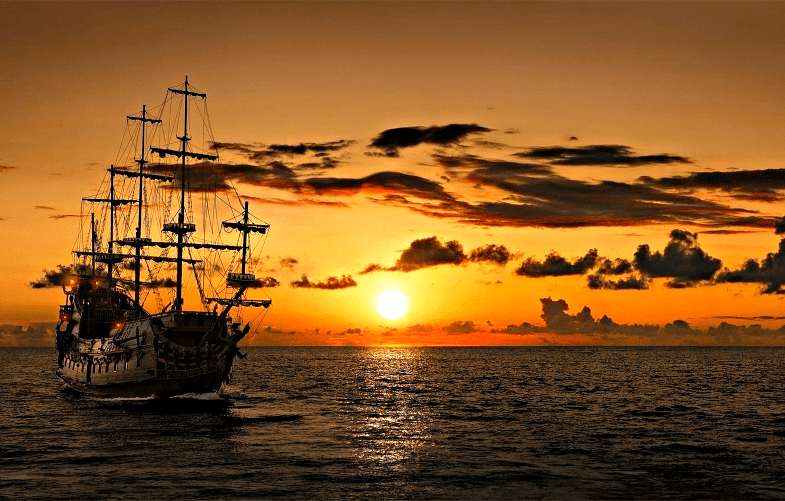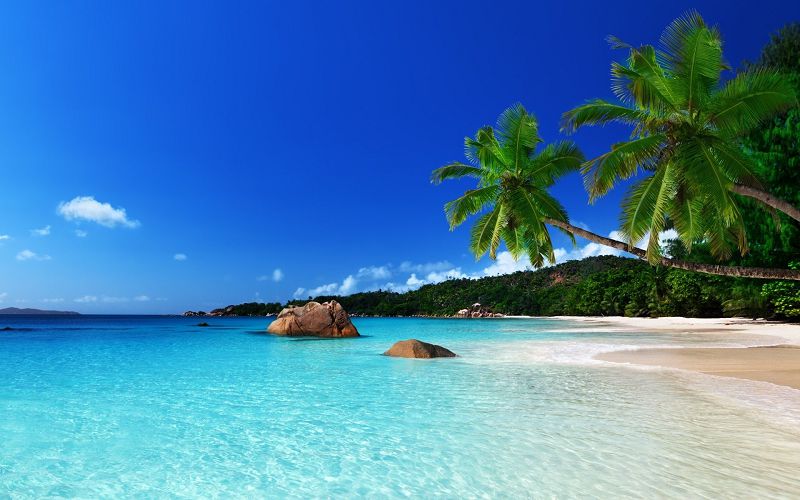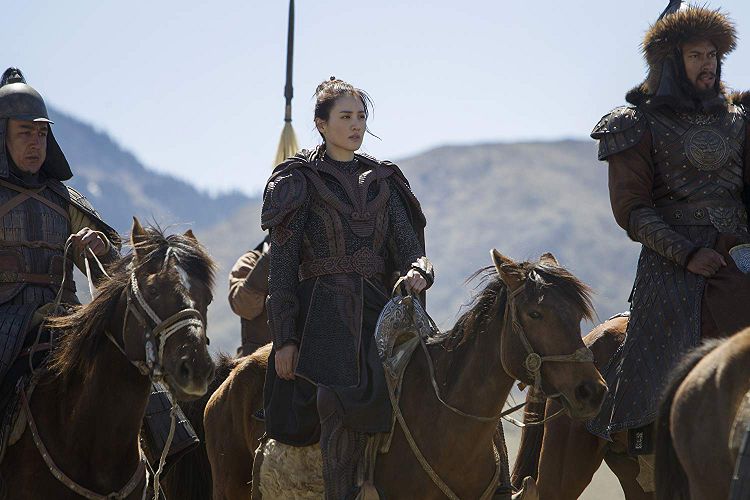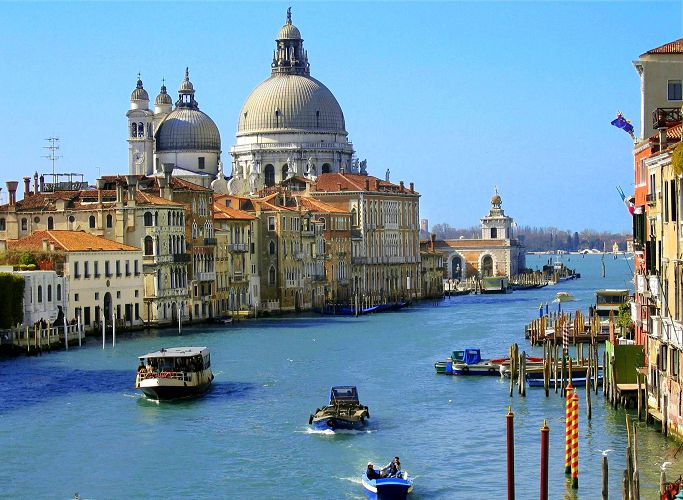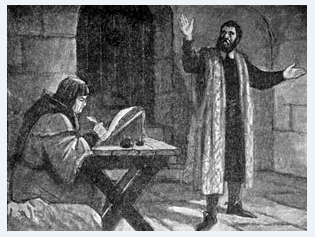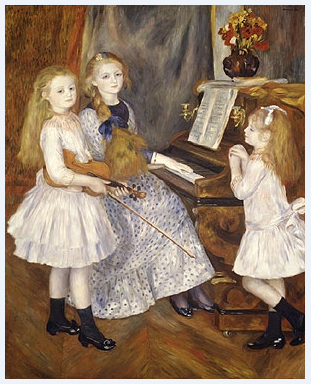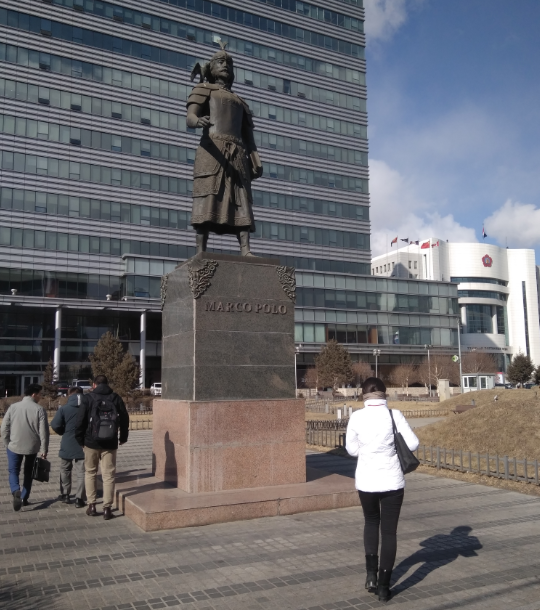Марко Поло — биография
У многих из нас мечты о путешествиях и далеких странах так и остаются мечтами, а некоторые не боятся оторваться от насиженного места и отправиться открывать неведомые страны. К последним точно относится Марко Поло, которого все знают не только как купца и путешественника, но и автора знаменитого произведения «Книга о разнообразии мира». О достоверности данных, изложенных в ней, спорят уже не одно столетие, но то, что она пригодилась в путешествиях многим людям, в том числе и прославленному Колумбу, сомнений не вызывает.
Детство
Точных подтверждений даты и места рождения Марко Поло нет, ими принято считать 15 сентября 1254 года в Венеции. Его отец Никколо Поло принадлежал к дворянскому сословию, был венецианским вельможей с собственным гербом. Он продавал ювелирные изделия и пряности. Марко совершенно не знал свою маму, она умерла во время родов. Поэтому воспитание мальчика легло на плечи отца и родной тети.
По поводу родины путешественника до сих пор ведутся ссоры между Польшей и Хорватией. Поляки уверены, что в пользу их версии указывает фамилия Поло, как сокращенная от слова поляк. Хорваты в свою очередь уверены, что располагают первыми свидетельствами того, что Марко родился на их земле.
Об образовании Марко так ничего и не удалось выяснить. Также неизвестно, обучен ли он был грамоте или нет, потому что свою знаменитую книгу он сумел написать с помощью сокамерника Рустичиано, которому диктовал ее от начала до конца во время пребывания в генуэзской тюрьме. Но, тем не менее, известно, что путешествуя по миру, Поло делал отметки собственной рукой в записной книжке, внимательно изучал все, что происходит вокруг и записывал все, что поразило его внимание. Во время путешествия он постепенно овладел несколькими языками.
Путешествия
По роду своих занятий, отцу Марко часто приходилось отправляться в путешествия. Он много ездил по всему миру, прокладывал торговые тропы. Благодаря отцу мальчик полюбил путешествия, потому что постоянно слушал рассказы о дальних странах и приключениях моряков. В 1271-м Марко первый раз оказался в путешествии, куда его взял с собой отец. По окончанию странствия, они должны были оказаться в Иерусалиме.
Тогда же прошли выборы нового папы Римского, который в свою очередь удостоил семью Поло честью представлять их интересы в Китае. В то время власть в этой стране принадлежала монгольскому хану. Они отправились по Средиземному морю, сделав первую остановку в порту Лаяс. Именно сюда доставлялись товары из азиатских стран, покупателями которых были генуэзские и венецианские купцы. Потом на очереди путешественников была Малая Азия, Армения, Междуречье. Марко с отцом побывали также в Багдаде и Мосуле.
Далее их путь лежит к персидскому Тебризу, славившемуся своим богатейшим рынком жемчуга. В Персии они подверглись нападению разбойников и потеряли часть сопровождающих.
Семейство Поло выжило только благодаря чуду. Им пришлось преодолевать знойную пустыню, они были сильно ослаблены жаждой. Едва живые, они наконец-то попали в афганский город Балху, и таким образом спаслись.
Дальнейший путь привел путешественников к восточным землям, где в изобилии были фрукты и дичь. Следующий регион на их пути – Бадахшан, поражал многочисленностью рабов, работающих на добыче драгоценных камней. Существует версия, что Марко в это время серьезно заболел, поэтому путешественники провели в этой местности целый год. Потом они переправились через Памир и устремились к Кашмиру. Поло никак не мог скрыть своего восторга от местных колдунов и изобилия красивых женщин.
И вот, наконец, их взору предстал Южный Тянь-Шань, где до этого не ступала нога ни одного европейца. Потом их караван устремился через пустыню Такла-Макан. Путешественники добрались до первого китайского города – Шанчжоу, потом посетили Гуанчжоу и Ланчжоу. Марко очень впечатлили местные обычаи и обряды, он любовался флорой и фауной этой неизвестной ему страны. В это время он сделал свои самые удивительные открытия, путешествовал по разным местам.
Семья Поло воспользовалась гостеприимностью хана Хубилая, и жила у него на протяжении пятнадцати лет. Хан полюбил Марко за его бесстрашие, независимость и отличную память. Правитель приблизил молодого человека к себе, позволял участвовать в жизни государства, набирать армию. Кроме этого Поло выступил с предложением об использовании военных катапульт, и это понравилось хану.
С важными дипломатическими заданиями Марко объездил множество китайских городов, в совершенстве овладел языком. Его удивляли и восторгали невероятные открытия и достижения, сделанные китайцами. Обо всем этом он подробно писал в своем труде. Перед самым возвращением на родину, хан назначил Марко управлять китайскими провинциями Цзяннань.
Хубилай не хотел, чтобы Марко уезжал, но в 1291-м семья Поло отправилась в качестве сопровождения для монгольской принцессы, ставшей женой правителя Персии. Путешественникам предстояло побывать на Цейлоне и Суматре. Спустя три года, когда они еще были в пути, до них дошло известие о смерти хана Хубилая.
Поло решили возвращаться на родину. Для этого им нужно было пересечь воды Индийского океана, а это удавалось далеко не каждому. Возвращение Марко домой состоялось зимой 1295-го, спустя 24 года после начала путешествия.
Могут быть знакомы
Дома
Спустя два года между Венецией и Генуей вспыхнула война, в которой Марко принимал непосредственное участие. Его взяли в плен, и на несколько месяцев заточили в тюрьму. Именно в этом месте он и написал свою знаменитую на весь мир книгу.
Произведение вышло в ста сорока вариантах, переведено на 12 языков. В книге есть место некоторым домыслам, но зато европейцы расширили свои познания. Они узнали, что существуют бумажные деньги, саговая пальма и каменный уголь, места выращивания пряностей и еще о многих вещах, о существовании которых они никогда не задумывались.
Личная жизнь
После возвращения на родину, отец Марко снова женился, и в этом браке родились три сына. Сам Марко тоже сумел устроить свою личную жизнь. Его женой стала знатная и достаточно богатая венецианка Доната, они приобрели дом и родили трех девочек. В те годы Поло называют господином Миллионом. Жители города видят в нем чудаковатого лжеца, его рассказы о дальних странах не вызывают у них доверия. В целом, жизнь Поло сложилась благополучно, но он очень скучал по Китаю.
Настоящее удовольствие Поло получал от венецианских карнавалов, которые тоже навевали мысли о Китае. После возвращения домой Марко занимался торговлей, и пожинал плоды славы от своей книги.
Марко Поло не стало в 1324 году. Он умер в Венеции, в возрасте 70-ти лет. Местом его упокоения стала церковь Сан Лоренцо, которую разрушили в 19-м веке. От роскошного дома тоже ничего не осталось, он сгорел в конце 16-го века. Биография Марко Поло нашла отражение в кинематографе, в разные годы на экраны выходили сериалы и полнометражные картины, рассказывающие о великом путешественнике.
Интересные факты
- Польша, Хорватия и Италия никак не прекратят борьбу за право называться родиной известного путешественника.
- Перед самой смертью отличался невероятной скупостью, Поло даже судился со своей семьей.
- Марко отпустил на волю одного своего раба и даже оставил ему по завещанию часть наследства. Такой экстравагантный поступок вызвал много предположений о том, чем вызвана такая щедрость.
- В 1888 году имя Марко Поло присвоили бабочке. Ее называют Желтушка Марко Поло
Ссылки
- Страница в Википедии
Для нас важна актуальность и достоверность информации. Если вы обнаружили ошибку или неточность, пожалуйста, сообщите нам. Выделите ошибку и нажмите сочетание клавиш Ctrl+Enter.
|
Marco Polo |
|
|---|---|

Polo wearing a Tartar outfit, print from the 18th century |
|
| Born | 1254
Venice, Republic of Venice |
| Died | 8 January 1324 (aged 69–70)
Venice, Republic of Venice |
| Resting place | Church of San Lorenzo 45°26′14″N 12°20′44″E / 45.4373°N 12.3455°E |
| Occupation(s) | Merchant, explorer, writer |
| Known for | The Travels of Marco Polo |
| Spouse |
Donata Badoer (m. 1300–1324) |
| Children | 3 |
| Parents |
|
Marco Polo (, Venetian: [ˈmaɾko ˈpolo], Italian: [ˈmarko ˈpɔːlo] (listen); c. 1254 – 8 January 1324)[1] was a Venetian merchant,[2][3] explorer and writer who travelled through Asia along the Silk Road between 1271 and 1295. His travels are recorded in The Travels of Marco Polo (also known as Book of the Marvels of the World and Il Milione, c. 1300), a book that described to Europeans the then mysterious culture and inner workings of the Eastern world, including the wealth and great size of the Mongol Empire and China in the Yuan Dynasty, giving their first comprehensive look into China, Persia, India, Japan and other Asian cities and countries.[4]
Born in Venice, Marco learned the mercantile trade from his father and his uncle, Niccolò and Maffeo, who travelled through Asia and met Kublai Khan. In 1269, they returned to Venice to meet Marco for the first time. The three of them embarked on an epic journey to Asia, exploring many places along the Silk Road until they reached Cathay (China). They were received by the royal court of Kublai Khan, who was impressed by Marco’s intelligence and humility. Marco was appointed to serve as Khan’s foreign emissary, and he was sent on many diplomatic missions throughout the empire and Southeast Asia, such as in present-day Burma, India, Indonesia, Sri Lanka and Vietnam.[5][6] As part of this appointment, Marco also travelled extensively inside China, living in the emperor’s lands for 17 years and seeing many things that had previously been unknown to Europeans.[7] Around 1291, the Polos also offered to accompany the Mongol princess Kököchin to Persia; they arrived around 1293. After leaving the princess, they travelled overland to Constantinople and then to Venice, returning home after 24 years.[7] At this time, Venice was at war with Genoa; Marco was captured and imprisoned by the Genoans after joining the war effort and dictated his stories to Rustichello da Pisa, a cellmate. He was released in 1299, became a wealthy merchant, married, and had three children. He died in 1324 and was buried in the church of San Lorenzo in Venice.
Though he was not the first European to reach China (see Europeans in Medieval China), Marco Polo was the first to leave a detailed chronicle of his experience. This account of the Orient provided the Europeans with a clear picture of the East’s geography and ethnic customs, and was the first Western record of porcelain, gunpowder, paper money, and some Asian plants and exotic animals.[8] His travel book inspired Christopher Columbus[9] and many other travellers. There is substantial literature based on Polo’s writings; he also influenced European cartography, leading to the introduction of the Fra Mauro map.
Life
Birthplace and family origin
16th-century portrait of Marco Polo
Marco Polo was born in 1254 in Venice, the capital of the Venetian Republic.[10][11] His father, Niccolò Polo, had his household in Venice and left Marco’s pregnant mother in order to travel to Asia with his brother Maffeo Polo. Their return to Italy in order to «go to Venice and visit their household» is described in The Travels of Marco Polo as follows: «…they departed from Acre and went to Negropont, and from Negropont they continued their voyage to Venice. On their arrival there, Messer Nicolas found that his wife was dead and that she had left behind her a son of fifteen years of age, whose name was Marco».[12]
His first known ancestor was a great uncle, Marco Polo (the older) from Venice, who lent some money and commanded a ship in Constantinople. Andrea, Marco’s grandfather, lived in Venice in «contrada San Felice», he had three sons: Marco «the older», Maffeo and Niccolò (Marco’s father).[13][14] Some old Venetian historical sources considered Polo’s ancestors to be of far Dalmatian origin.[15][16][17]
Nickname Milione
Corte Seconda del Milion, Venice is named after the nickname of Polo, Il Milione
Marco Polo is most often mentioned in the archives of the Republic of Venice as Marco Paulo de confinio Sancti Iohannis Grisostomi,[18] which means Marco Polo of the contrada of St John Chrysostom Church.
However, he was also nicknamed Milione during his lifetime (which in Italian literally means ‘Million’). In fact, the Italian title of his book was Il libro di Marco Polo detto il Milione, which means «The Book of Marco Polo, nicknamed ‘Milione‘«. According to the 15th-century humanist Giovanni Battista Ramusio, his fellow citizens awarded him this nickname when he came back to Venice because he kept on saying that Kublai Khan’s wealth was counted in millions. More precisely, he was nicknamed Messer Marco Milioni (Mr Marco Millions).[19]
However, since also his father Niccolò was nicknamed Milione,[20] 19th-century philologist Luigi Foscolo Benedetto was persuaded that Milione was a shortened version of Emilione, and that this nickname was used to distinguish Niccolò’s and Marco’s branch from other Polo families.[21][22]
Early life and Asian travel
Mosaic of Marco Polo displayed in the Palazzo Doria-Tursi, Genoa, Italy
In 1168, his great-uncle, Marco Polo, borrowed money and commanded a ship in Constantinople.[23][24] His grandfather, Andrea Polo of the parish of San Felice, had three sons, Maffeo, yet another Marco, and the traveller’s father Niccolò.[23] This genealogy, described by Ramusio, is not universally accepted as there is no additional evidence to support it.[25][26]
His father, Niccolò Polo, a merchant, traded with the Near East, becoming wealthy and achieving great prestige.[27][28] Niccolò and his brother Maffeo set off on a trading voyage before Marco’s birth.[29][28] In 1260, Niccolò and Maffeo, while residing in Constantinople, then the capital of the Latin Empire, foresaw a political change; they liquidated their assets into jewels and moved away.[27] According to The Travels of Marco Polo, they passed through much of Asia, and met with Kublai Khan, a Mongol ruler and founder of the Yuan dynasty.[30] Their decision to leave Constantinople proved timely. In 1261 Michael VIII Palaiologos, the ruler of the Empire of Nicaea, took Constantinople, promptly burned the Venetian quarter and re-established the Byzantine Empire. Captured Venetian citizens were blinded,[31] while many of those who managed to escape perished aboard overloaded refugee ships fleeing to other Venetian colonies in the Aegean Sea.
Almost nothing is known about the childhood of Marco Polo until he was fifteen years old, except that he probably spent part of his childhood in Venice.[32][33][24] Meanwhile, Marco Polo’s mother died, and an aunt and uncle raised him.[28] He received a good education, learning mercantile subjects including foreign currency, appraising, and the handling of cargo ships;[28] he learned little or no Latin.[27] His father later married Floradise Polo (née Trevisan).[26]
In 1269, Niccolò and Maffeo returned to their families in Venice, meeting young Marco for the first time.[32] In 1271, during the rule of Doge Lorenzo Tiepolo, Marco Polo (at seventeen years of age), his father, and his uncle set off for Asia on the series of adventures that Marco later documented in his book.[34]
They sailed to Acre and later rode on their camels to the Persian port Hormuz. During the first stages of the journey, they stayed for a few months in Acre and were able to speak with Archdeacon Tedaldo Visconti of Piacenza. The Polo family, on that occasion, had expressed their regret at the long lack of a pope, because on their previous trip to China they had received a letter from Kublai Khan to the Pope, and had thus had to leave for China disappointed. During the trip, however, they received news that after 33 months of vacation, finally, the Conclave had elected the new Pope and that he was exactly the archdeacon of Acre. The three of them hurried to return to the Holy Land, where the new Pope entrusted them with letters for the «Great Khan», inviting him to send his emissaries to Rome. To give more weight to this mission he sent with the Polos, as his legates, two Dominican fathers, Guglielmo of Tripoli and Nicola of Piacenza.[35]
They continued overland until they arrived at Kublai Khan’s place in Shangdu, China (then known as Cathay). By this time, Marco was 21 years old.[36] Impressed by Marco’s intelligence and humility, Khan appointed him to serve as his foreign emissary to India and Burma. He was sent on many diplomatic missions throughout his empire and in Southeast Asia, (such as in present-day Indonesia, Sri Lanka and Vietnam),[5][6] but also entertained the Khan with stories and observations about the lands he saw. As part of this appointment, Marco travelled extensively inside China, living in the emperor’s lands for 17 years.[7]
Kublai initially refused several times to let the Polos return to Europe, as he appreciated their company and they became useful to him.[37] However, around 1291, he finally granted permission, entrusting the Polos with his last duty: accompany the Mongol princess Kököchin, who was to become the consort of Arghun Khan, in Persia (see Narrative section).[36][38] After leaving the princess, the Polos travelled overland to Constantinople. They later decided to return to their home.[36]
They returned to Venice in 1295, after 24 years, with many riches and treasures. They had travelled almost 15,000 miles (24,000 km).[28]
Genoese captivity and later life
Marco Polo returned to Venice in 1295 with his fortune converted into gemstones. At this time, Venice was at war with the Republic of Genoa.[39] Polo armed a galley equipped with a trebuchet[40] to join the war. He was probably caught by Genoans in a skirmish in 1296, off the Anatolian coast between Adana and the Gulf of Alexandretta[41] (and not during the battle of Curzola (September 1298), off the Dalmatian coast,[42] a claim which is due to a later tradition (16th century) recorded by Giovanni Battista Ramusio[43][44]).
He spent several months of his imprisonment dictating a detailed account of his travels to a fellow inmate, Rustichello da Pisa,[28] who incorporated tales of his own as well as other collected anecdotes and current affairs from China. The book soon spread throughout Europe in manuscript form, and became known as The Travels of Marco Polo (Italian title: Il Milione, lit. «The Million», deriving from Polo’s nickname «Milione». Original title in Franco-Italian : Livres des Merveilles du Monde). It depicts the Polos’ journeys throughout Asia, giving Europeans their first comprehensive look into the inner workings of the Far East, including China, India, and Japan.[45]
Polo was finally released from captivity in August 1299,[28] and returned home to Venice, where his father and uncle in the meantime had purchased a large palazzo in the zone named contrada San Giovanni Crisostomo (Corte del Milion).[46] For such a venture, the Polo family probably invested profits from trading, and even many gemstones they brought from the East.[46] The company continued its activities and Marco soon became a wealthy merchant. Marco and his uncle Maffeo financed other expeditions, but likely never left Venetian provinces, nor returned to the Silk Road and Asia.[47] Sometime before 1300, his father Niccolò died.[47] In 1300, he married Donata Badoèr, the daughter of Vitale Badoèr, a merchant.[48] They had three daughters, Fantina (married Marco Bragadin), Bellela (married Bertuccio Querini), and Moreta.[49][50]
Pietro d’Abano philosopher, doctor and astrologer based in Padua, reports having spoken with Marco Polo about what he had observed in the vault of the sky during his travels. Marco told him that during his return trip to the South China Sea, he had spotted what he describes in a drawing as a star «shaped like a sack» (in Latin: ut sacco) with a big tail (magna habens caudam), most likely a comet. Astronomers agree that there were no comets sighted in Europe at the end of the thirteenth century, but there are records about a comet sighted in China and Indonesia in 1293.[51] Interestingly, this circumstance does not appear in Polo’s book of Travels. Peter D’Abano kept the drawing in his volume «Conciliator Differentiarum, quæ inter Philosophos et Medicos Versantur». Marco Polo gave Pietro other astronomical observations he made in the Southern Hemisphere, and also a description of the Sumatran rhinoceros, which are collected in the Conciliator.[51]
In 1305 he is mentioned in a Venetian document among local sea captains regarding the payment of taxes.[26] His relation with a certain Marco Polo, who in 1300 was mentioned with riots against the aristocratic government, and escaped the death penalty, as well as riots from 1310 led by Bajamonte Tiepolo and Marco Querini, among whose rebels were Jacobello and Francesco Polo from another family branch, is unclear.[26] Polo is clearly mentioned again after 1305 in Maffeo’s testament from 1309 to 1310, in a 1319 document according to which he became owner of some estates of his deceased father, and in 1321, when he bought part of the family property of his wife Donata.[26]
Death
In 1323, Polo was confined to bed, due to illness.[52] On 8 January 1324, despite physicians’ efforts to treat him, Polo was on his deathbed.[53] To write and certify the will, his family requested Giovanni Giustiniani, a priest of San Procolo. His wife, Donata, and his three daughters were appointed by him as co-executrices.[53] The church was entitled by law to a portion of his estate; he approved of this and ordered that a further sum be paid to the convent of San Lorenzo, the place where he wished to be buried.[53] He also set free Peter, a Tartar servant, who may have accompanied him from Asia,[54] and to whom Polo bequeathed 100 lire of Venetian denari.[55]
He divided up the rest of his assets, including several properties, among individuals, religious institutions, and every guild and fraternity to which he belonged.[53] He also wrote off multiple debts including 300 lire that his sister-in-law owed him, and others for the convent of San Giovanni, San Paolo of the Order of Preachers, and a cleric named Friar Benvenuto.[53] He ordered 220 soldi be paid to Giovanni Giustiniani for his work as a notary and his prayers.[56]
The will was not signed by Polo, but was validated by the then-relevant «signum manus» rule, by which the testator only had to touch the document to make it legally valid.[55][57] Due to the Venetian law stating that the day ends at sunset, the exact date of Marco Polo’s death cannot be determined, but according to some scholars it was between the sunsets of 8 and 9 January 1324.[58] Biblioteca Marciana, which holds the original copy of his testament, dates the testament on 9 January 1323, and gives the date of his death at some time in June 1324.[57]
The Travels of Marco Polo
Map of Marco Polo’s travels
An authoritative version of Marco Polo’s book does not and cannot exist, for the early manuscripts differ significantly, and the reconstruction of the original text is a matter of textual criticism. A total of about 150 copies in various languages are known to exist. Before the availability of printing press, errors were frequently made during copying and translating, so there are many differences between the various copies.[59][60]
Polo related his memoirs orally to Rustichello da Pisa while both were prisoners of the Genova Republic. Rustichello wrote Devisement du Monde in Franco-Venetian.[61] The idea probably was to create a handbook for merchants, essentially a text on weights, measures and distances.[62]
The oldest surviving manuscript is in Old French heavily flavoured with Italian;[63] According to the Italian scholar Luigi Foscolo Benedetto, this «F» text is the basic original text, which he corrected by comparing it with the somewhat more detailed Italian of Giovanni Battista Ramusio, together with a Latin manuscript in the Biblioteca Ambrosiana. Other early important sources are R (Ramusio’s Italian translation first printed in 1559), and Z (a fifteenth-century Latin manuscript kept at Toledo, Spain). Another Old French Polo manuscript, dating to around 1350, is held by the National Library of Sweden.[64]
One of the early manuscripts Iter Marci Pauli Veneti was a translation into Latin made by the Dominican brother Francesco Pipino [it] in 1302, just a few years after Marco’s return to Venice. Since Latin was then the most widespread and authoritative language of culture, it is suggested that Rustichello’s text was translated into Latin for a precise will of the Dominican Order, and this helped to promote the book on a European scale.[18]
The first English translation is the Elizabethan version by John Frampton published in 1579, The most noble and famous travels of Marco Polo, based on Santaella’s Castilian translation of 1503 (the first version in that language).[65]
The published editions of Polo’s book rely on single manuscripts, blend multiple versions together, or add notes to clarify, for example in the English translation by Henry Yule. The 1938 English translation by A. C. Moule and Paul Pelliot is based on a Latin manuscript found in the library of the Cathedral of Toledo in 1932, and is 50% longer than other versions.[66] The popular translation published by Penguin Books in 1958 by R. E. Latham works several texts together to make a readable whole.[67]
Narrative
Statue of Marco Polo in Hangzhou, China
The book opens with a preface describing his father and uncle travelling to Bolghar where Prince Berke Khan lived. A year later, they went to Ukek[68] and continued to Bukhara. There, an envoy from the Levant invited them to meet Kublai Khan, who had never met Europeans.[69] In 1266, they reached the seat of Kublai Khan at Dadu, present-day Beijing, China. Kublai received the brothers with hospitality and asked them many questions regarding the European legal and political system.[70] He also inquired about the Pope and Church in Rome.[71] After the brothers answered the questions he tasked them with delivering a letter to the Pope, requesting 100 Christians acquainted with the Seven Arts (grammar, rhetoric, logic, geometry, arithmetic, music and astronomy). Kublai Khan requested also that an envoy bring him back oil of the lamp in Jerusalem.[72] The long sede vacante between the death of Pope Clement IV in 1268 and the election of his successor delayed the Polos in fulfilling Kublai’s request. They followed the suggestion of Theobald Visconti, then papal legate for the realm of Egypt, and returned to Venice in 1269 or 1270 to await the nomination of the new Pope, which allowed Marco to see his father for the first time, at the age of fifteen or sixteen.[73]
In 1271, Niccolò, Maffeo and Marco Polo embarked on their voyage to fulfil Kublai’s request. They sailed to Acre, and then rode on camels to the Persian port of Hormuz. The Polos wanted to sail straight into China, but the ships there were not seaworthy, so they continued overland through the Silk Road, until reaching Kublai’s summer palace in Shangdu, near present-day Zhangjiakou. In one instance during their trip, the Polos joined a caravan of travelling merchants whom they crossed paths with. Unfortunately, the party was soon attacked by bandits, who used the cover of a sandstorm to ambush them. The Polos managed to fight and escape through a nearby town, but many members of the caravan were killed or enslaved.[74] Three and a half years after leaving Venice, when Marco was about 21 years old, the Polos were welcomed by Kublai into his palace.[28] The exact date of their arrival is unknown, but scholars estimate it to be between 1271 and 1275.[nb 1] On reaching the Yuan court, the Polos presented the sacred oil from Jerusalem and the papal letters to their patron.[27]
Marco knew four languages, and the family had accumulated a great deal of knowledge and experience that was useful to Kublai. It is possible that he became a government official;[28] he wrote about many imperial visits to China’s southern and eastern provinces, the far south and Burma.[75] They were highly respected and sought after in the Mongolian court, and so Kublai Khan decided to decline the Polos’ requests to leave China. They became worried about returning home safely, believing that if Kublai died, his enemies might turn against them because of their close involvement with the ruler. In 1292, Kublai’s great-nephew, then ruler of Persia, sent representatives to China in search of a potential wife, and they asked the Polos to accompany them, so they were permitted to return to Persia with the wedding party—which left that same year from Zaitun in southern China on a fleet of 14 junks. The party sailed to the port of Singapore,[76] travelled north to Sumatra,[77] and around the southern tip of India,[78] eventually crossing the Arabian Sea to Hormuz. The two-year voyage was a perilous one—of the six hundred people (not including the crew) in the convoy only eighteen had survived (including all three Polos).[79] The Polos left the wedding party after reaching Hormuz and travelled overland to the port of Trebizond on the Black Sea, the present-day Trabzon.[28]
A page from Il Milione, from a manuscript believed to date between 1298 and 1299
Role of Rustichello
The British scholar Ronald Latham has pointed out that The Book of Marvels was, in fact, a collaboration written in 1298–1299 between Polo and a professional writer of romances, Rustichello of Pisa.[80] It is believed that Polo related his memoirs orally to Rustichello da Pisa while both were prisoners of the Genova Republic. Rustichello wrote Devisement du Monde in Franco-Venetian language, which was the language of culture widespread in northern Italy between the subalpine belt and the lower Po between the 13th and 15th centuries.[61][81]
Latham also argued that Rustichello may have glamorised Polo’s accounts, and added fantastic and romantic elements that made the book a bestseller.[80] The Italian scholar Luigi Foscolo Benedetto had previously demonstrated that the book was written in the same «leisurely, conversational style» that characterised Rustichello’s other works, and that some passages in the book were taken verbatim or with minimal modifications from other writings by Rustichello. For example, the opening introduction in The Book of Marvels to «emperors and kings, dukes and marquises» was lifted straight out of an Arthurian romance Rustichello had written several years earlier, and the account of the second meeting between Polo and Kublai Khan at the latter’s court is almost the same as that of the arrival of Tristan at the court of King Arthur at Camelot in that same book.[82] Latham believed that many elements of the book, such as legends of the Middle East and mentions of exotic marvels, may have been the work of Rustichello who was giving what medieval European readers expected to find in a travel book.[83]
Role of the Dominican Order
Apparently, from the very beginning, Marco’s story aroused contrasting reactions, as it was received by some with a certain disbelief. The Dominican father Francesco Pipino was the author of a translation into Latin, Iter Marci Pauli Veneti in 1302, just a few years after Marco’s return to Venice. Francesco Pipino solemnly affirmed the truthfulness of the book and defined Marco as a «prudent, honoured and faithful man».[84]
In his writings, the Dominican brother Jacopo d’Acqui explains why his contemporaries were sceptical about the content of the book. He also relates that before dying, Marco Polo insisted that «he had told only a half of the things he had seen».[84]
According to some recent research of the Italian scholar Antonio Montefusco, the very close relationship that Marco Polo cultivated with members of the Dominican Order in Venice suggests that local fathers collaborated with him for a Latin version of the book, which means that Rustichello’s text was translated into Latin for a precise will of the Order.[18]
Since Dominican fathers had among their missions that of evangelizing foreign peoples (cf. the role of Dominican missionaries in China[85] and in the Indies[86]), it is reasonable to think that they considered Marco’s book as a trustworthy piece of information for missions in the East. The diplomatic communications between Pope Innocent IV and Pope Gregory X with the Mongols[87] were probably another reason for this endorsement. At the time, there was open discussion of a possible Christian-Mongol alliance with an anti-Islamic function.[88] In fact, a Mongol delegate was solemny baptised at the Second Council of Lyon. At the council, Pope Gregory X promulgated a new Crusade to start in 1278 in liaison with the Mongols.[89]
Authenticity and veracity
Kublai Khan’s court, from the French «Livre des merveilles»
Since its publication, some have viewed the book with skepticism.[90] Some in the Middle Ages regarded the book simply as a romance or fable, due largely to the sharp difference of its descriptions of a sophisticated civilisation in China to other early accounts by Giovanni da Pian del Carpine and William of Rubruck, who portrayed the Mongols as ‘barbarians’ who appeared to belong to ‘some other world’.[90] Doubts have also been raised in later centuries about Marco Polo’s narrative of his travels in China, for example for his failure to mention the Great Wall of China, and in particular the difficulties in identifying many of the place names he used[91] (the great majority, however, have since been identified).[92] Many have questioned whether he had visited the places he mentioned in his itinerary, whether he had appropriated the accounts of his father and uncle or other travellers, and some doubted whether he even reached China, or that if he did, perhaps never went beyond Khanbaliq (Beijing).[91][93]
It has, however, been pointed out that Polo’s accounts of China are more accurate and detailed than other travellers’ accounts of the period. Polo had at times refuted the ‘marvellous’ fables and legends given in other European accounts, and despite some exaggerations and errors, Polo’s accounts have relatively few of the descriptions of irrational marvels. In many cases of descriptions of events where he was not present (mostly given in the first part before he reached China, such as mentions of Christian miracles), he made a clear distinction that they are what he had heard rather than what he had seen. It is also largely free of the gross errors found in other accounts such as those given by the Moroccan traveller Ibn Battuta who had confused the Yellow River with the Grand Canal and other waterways, and believed that porcelain was made from coal.[94]
Modern studies have further shown that details given in Marco Polo’s book, such as the currencies used, salt productions and revenues, are accurate and unique. Such detailed descriptions are not found in other non-Chinese sources, and their accuracy is supported by archaeological evidence as well as Chinese records compiled after Polo had left China. His accounts are therefore unlikely to have been obtained second hand.[95] Other accounts have also been verified; for example, when visiting Zhenjiang in Jiangsu, China, Marco Polo noted that a large number of Christian churches had been built there. His claim is confirmed by a Chinese text of the 14th century explaining how a Sogdian named Mar-Sargis from Samarkand founded six Nestorian Christian churches there in addition to one in Hangzhou during the second half of the 13th century.[96] His story of the princess Kököchin sent from China to Persia to marry the Īl-khān is also confirmed by independent sources in both Persia and China.[97]
Scholarly analyses
Explaining omissions
Sceptics have long wondered whether Marco Polo wrote his book based on hearsay, with some pointing to omissions about noteworthy practices and structures of China as well as the lack of details on some places in his book. While Polo describes paper money and the burning of coal, he fails to mention the Great Wall of China, tea, Chinese characters, chopsticks, or footbinding.[98] His failure to note the presence of the Great Wall of China was first raised in the middle of the seventeenth century, and in the middle of the eighteenth century, it was suggested that he might have never reached China.[91] Later scholars such as John W. Haeger argued that Marco Polo might not have visited Southern China due to the lack of details in his description of southern Chinese cities compared to northern ones, while Herbert Franke also raised the possibility that Marco Polo might not have been to China at all, and wondered if he might have based his accounts on Persian sources due to his use of Persian expressions.[93][99] This is taken further by Frances Wood who claimed in her 1995 book Did Marco Polo Go to China? that at best Polo never went farther east than Persia (modern Iran), and that there is nothing in The Book of Marvels about China that could not be obtained via reading Persian books.[100] Wood maintains that it is more probable that Polo only went to Constantinople (modern Istanbul, Turkey) and some of the Italian merchant colonies around the Black Sea, picking hearsay from those travellers who had been farther east.[100]
Supporters of Polo’s basic accuracy countered on the points raised by sceptics such as footbinding and the Great Wall of China. Historian Stephen G. Haw argued that the Great Walls were built to keep out northern invaders, whereas the ruling dynasty during Marco Polo’s visit were those very northern invaders. They note that the Great Wall familiar to us today is a Ming structure built some two centuries after Marco Polo’s travels; and that the Mongol rulers whom Polo served controlled territories both north and south of today’s wall, and would have no reasons to maintain any fortifications that may have remained there from the earlier dynasties.[101] Other Europeans who travelled to Khanbaliq during the Yuan dynasty, such as Giovanni de’ Marignolli and Odoric of Pordenone, said nothing about the wall either. The Muslim traveller Ibn Battuta, who asked about the wall when he visited China during the Yuan dynasty, could find no one who had either seen it or knew of anyone who had seen it, suggesting that while ruins of the wall constructed in the earlier periods might have existed, they were not significant or noteworthy at that time.[101]
Haw also argued that footbinding was not common even among Chinese during Polo’s time and almost unknown among the Mongols. While the Italian missionary Odoric of Pordenone who visited Yuan China mentioned footbinding (it is however unclear whether he was merely relaying something he had heard as his description is inaccurate),[102] no other foreign visitors to Yuan China mentioned the practice, perhaps an indication that the footbinding was not widespread or was not practised in an extreme form at that time.[103] Marco Polo himself noted (in the Toledo manuscript) the dainty walk of Chinese women who took very short steps.[101] It has also been noted by other scholars that many of the things not mentioned by Marco Polo such as tea and chopsticks were not mentioned by other travellers as well.[38] Haw also pointed out that despite the few omissions, Marco Polo’s account is more extensive, more accurate and more detailed than those of other foreign travellers to China in this period.[104] Marco Polo even observed Chinese nautical inventions such as the watertight compartments of bulkhead partitions in Chinese ships, knowledge of which he was keen to share with his fellow Venetians.[105]
In addition to Haw, a number of other scholars have argued in favour of the established view that Polo was in China in response to Wood’s book.[38] The book has been criticized by figures including Igor de Rachewiltz (translator and annotator of The Secret History of the Mongols) and Morris Rossabi (author of Kublai Khan: his life and times).[106] The historian David Morgan points out basic errors made in Wood’s book such as confusing the Liao dynasty with the Jin dynasty, and he found no compelling evidence in the book that would convince him that Marco Polo did not go to China.[107] Haw also argues in his book Marco Polo’s China that Marco’s account is much more correct and accurate than has often been supposed and that it is extremely unlikely that he could have obtained all the information in his book from second-hand sources.[108] Haw also criticizes Wood’s approach to finding mention of Marco Polo in Chinese texts by contending that contemporaneous Europeans had little regard for using surnames and that a direct Chinese transliteration of the name «Marco» ignores the possibility of him taking on a Chinese or even Mongol name with no similarity to his Latin name.[109]
Also in reply to Wood, Jørgen Jensen recalled the meeting of Marco Polo and Pietro d’Abano in the late 13th century. During this meeting, Marco gave to Pietro details of the astronomical observations he had made on his journey. These observations are only compatible with Marco’s stay in China, Sumatra and the South China Sea[110] and are recorded in Pietro’s book Conciliator Differentiarum, but not in Marco’s Book of Travels.
Reviewing Haw’s book, Peter Jackson (author of The Mongols and the West) has said that Haw «must surely now have settled the controversy surrounding the historicity of Polo’s visit to China».[111] Igor de Rachewiltz’s review, which refutes Wood’s points, concludes with a strongly-worded condemnation: «I regret to say that F. W.’s book falls short of the standard of scholarship that one would expect in a work of this kind. Her book can only be described as deceptive, both in relation to the author and to the public at large. Questions are posted that, in the majority of cases, have already been answered satisfactorily … her attempt is unprofessional; she is poorly equipped in the basic tools of the trade, i.e., adequate linguistic competence and research methodology … and her major arguments cannot withstand close scrutiny. Her conclusion fails to consider all the evidence supporting Marco Polo’s credibility.»[112]
Allegations of exaggeration
Some scholars believe that Marco Polo exaggerated his importance in China. The British historian David Morgan thought that Polo had likely exaggerated and lied about his status in China,[113] while Ronald Latham believed that such exaggerations were embellishments by his ghostwriter Rustichello da Pisa.[83]
Et meser Marc Pol meisme, celui de cui trate ceste livre, seingneurie ceste cité por trois anz.
And the same Marco Polo, of whom this book relates, ruled this city for three years.
This sentence in The Book of Marvels was interpreted as Marco Polo was «the governor» of the city of «Yangiu» Yangzhou for three years, and later of Hangzhou. This claim has raised some controversy. According to David Morgan no Chinese source mentions him as either a friend of the Emperor or as the governor of Yangzhou – indeed no Chinese source mentions Marco Polo at all.[113] In fact, in the 1960s the German historian Herbert Franke noted that all occurrences of Po-lo or Bolod in Yuan texts were names of people of Mongol or Turkic extraction.[99]
However, in the 2010s the Chinese scholar Peng Hai identified Marco Polo with a certain «Boluo», a courtier of the emperor, who is mentioned in the Yuanshi («History of Yuan») since he was arrested in 1274 by an imperial dignitary named Saman. The accusation was that Boluo had walked on the same side of the road as a female courtesan, in contravention of the order for men and women to walk on opposite sides of the road inside the city.[114] According to the «Yuanshi» records, Boluo was released at the request of the emperor himself, and was then transferred to the region of Ningxia, in the northeast of present-day China, in the spring of 1275. The date could correspond to the first mission of which Marco Polo speaks.[115]
If this identification is correct, there is a record about Marco Polo in Chinese sources. These conjectures seem to be supported by the fact that in addition to the imperial dignitary Saman (the one who had arrested the official named «Boluo»), the documents mention his brother, Xiangwei. According to sources, Saman died shortly after the incident, while Xiangwei was transferred to Yangzhou in 1282–1283. Marco Polo reports that he was moved to Hangzhou the following year, in 1284. It has been supposed that these displacements are due to the intention to avoid further conflicts between the two.[116]
The sinologist Paul Pelliot thought that Polo might have served as an officer of the government salt monopoly in Yangzhou, which was a position of some significance that could explain the exaggeration.[113]
It may seem unlikely that a European could hold a position of power in the Mongolian empire. However, some records prove he was not the first nor the only one. In his book, Marco mentions an official named «Mar Sarchis» who probably was a Nestorian Christian bishop, and he says he founded two Christian churches in the region of «Caigiu». This official is actually mentioned in the local gazette Zhishun Zhenjian zhi under the name «Ma Xuelijisi» and the qualification of «General of Third Class». Always in the gazette, it is said Ma Xuelijsi was an assistant supervisor in the province of Zhenjiang for three years, and that during this time he founded two Christian churches.[117][118][116] In fact, it is a well-documented fact that Kublai Khan trusted foreigners more than Chinese subjects in internal affairs.[119][116]
Stephen G. Haw challenges this idea that Polo exaggerated his own importance, writing that, «contrary to what has often been said … Marco does not claim any very exalted position for himself in the Yuan empire.»[120] He points out that Polo never claimed to hold high rank, such as a darughachi, who led a tumen – a unit that was normally 10,000 strong. In fact, Polo does not even imply that he had led 1,000 personnel. Haw points out that Polo himself appears to state only that he had been an emissary of the khan, in a position with some esteem. According to Haw, this is a reasonable claim if Polo was, for example, a keshig – a member of the imperial guard by the same name, which included as many as 14,000 individuals at the time.[120]
Haw explains how the earliest manuscripts of Polo’s accounts provide contradicting information about his role in Yangzhou, with some stating he was just a simple resident, others stating he was a governor, and Ramusio’s manuscript claiming he was simply holding that office as a temporary substitute for someone else, yet all the manuscripts concur that he worked as an esteemed emissary for the khan.[121] Haw also objected to the approach to finding mention of Marco Polo in Chinese texts, contending that contemporaneous Europeans had little regard for using surnames, and a direct Chinese transcription of the name «Marco» ignores the possibility of him taking on a Chinese or even Mongol name that had no bearing or similarity with his Latin name.[120]
Another controversial claim is at chapter 145 when the Book of Marvels states that the three Polos provided the Mongols with technical advice on building mangonels during the Siege of Xiangyang,
Adonc distrent les .II. freres et lor filz meser Marc. «Grant Sire, nos avon avech nos en nostre mesnie homes qe firont tielz mangan qe giteront si grant pieres qe celes de la cité ne poront sofrir mes se renderont maintenant.»
Then the two brothers and their son Marc said: «Great Lord, in our entourage we have men who will build such mangonels which launch such great stones, that the inhabitants of the city will not endure it and will immediately surrender.»
Since the siege was over in 1273, before Marco Polo had arrived in China for the first time, the claim cannot be true.[113][122] The Mongol army that besieged Xiangyang did have foreign military engineers, but they were mentioned in Chinese sources as being from Baghdad and had Arabic names.[99] In this respect, Igor de Rachewiltz recalls that the claim that the three Polo were present at the siege of Xiang-yang is not present in all manuscripts, but Niccolò and Matteo could have made this suggestion. Therefore, this claim seems a subsequent addition to give more credibility to the story.[123][38]
Errors
A number of errors in Marco Polo’s account have been noted: for example, he described the bridge later known as Marco Polo Bridge as having twenty-four arches instead of eleven or thirteen.[38] He also said that city wall of Khanbaliq had twelve gates when it had only eleven.[124] Archaeologists have also pointed out that Polo may have mixed up the details from the two attempted invasions of Japan by Kublai Khan in 1274 and 1281. Polo wrote of five-masted ships, when archaeological excavations found that the ships, in fact, had only three masts.[125]
Appropriation
Wood accused Marco Polo of taking other people’s accounts in his book, retelling other stories as his own, or basing his accounts on Persian guidebooks or other lost sources. For example, Sinologist Francis Woodman Cleaves noted that Polo’s account of the voyage of the princess Kököchin from China to Persia to marry the Īl-khān in 1293 has been confirmed by a passage in the 15th-century Chinese work Yongle Encyclopedia and by the Persian historian Rashid-al-Din Hamadani in his work Jami’ al-tawarikh. However, neither of these accounts mentions Polo or indeed any European as part of the bridal party,[97] and Wood used the lack of mention of Polo in these works as an example of Polo’s «retelling of a well-known tale». Morgan, in Polo’s defence, noted that even the princess herself was not mentioned in the Chinese source and that it would have been surprising if Polo had been mentioned by Rashid-al-Din.[107] Historian Igor de Rachewiltz strongly criticised Wood’s arguments in his review of her book.[126] Rachewiltz argued that Marco Polo’s account, in fact, allows the Persian and Chinese sources to be reconciled – by relaying the information that two of the three envoys sent (mentioned in the Chinese source and whose names accord with those given by Polo) had died during the voyage, it explains why only the third who survived, Coja/Khoja, was mentioned by Rashìd al-Dìn. Polo had therefore completed the story by providing information not found in either source. He also noted that the only Persian source that mentions the princess was not completed until 1310–11, therefore Marco Polo could not have learned the information from any Persian book. According to de Rachewiltz, the concordance of Polo’s detailed account of the princess with other independent sources that gave only incomplete information is proof of the veracity of Polo’s story and his presence in China.[126]
Assessments
Morgan writes that since much of what The Book of Marvels has to say about China is «demonstrably correct», any claim that Polo did not go to China «creates far more problems than it solves», therefore the «balance of probabilities» strongly suggests that Polo really did go to China, even if he exaggerated somewhat his importance in China.[127] Haw dismisses the various anachronistic criticisms of Polo’s accounts that started in the 17th century, and highlights Polo’s accuracy in great part of his accounts, for example on features of the landscape such as the Grand Canal of China.[128] «If Marco was a liar,» Haw writes, «then he must have been an implausibly meticulous one.»[129]
In 2012, the University of Tübingen Sinologist and historian Hans Ulrich Vogel released a detailed analysis of Polo’s description of currencies, salt production and revenues, and argued that the evidence supports his presence in China because he included details which he could not have otherwise known.[95][130] Vogel noted that no other Western, Arab, or Persian sources have given such accurate and unique details about the currencies of China, for example, the shape and size of the paper, the use of seals, the various denominations of paper money as well as variations in currency usage in different regions of China, such as the use of cowry shells in Yunnan, details supported by archaeological evidence and Chinese sources compiled long after the Polos had left China.[131] His accounts of salt production and revenues from the salt monopoly are also accurate, and accord with Chinese documents of the Yuan era.[132] Economic historian Mark Elvin, in his preface to Vogel’s 2013 monograph, concludes that Vogel «demonstrates by specific example after specific example the ultimately overwhelming probability of the broad authenticity» of Polo’s account. Many problems were caused by the oral transmission of the original text and the proliferation of significantly different hand-copied manuscripts. For instance, did Polo exert «political authority» (seignora) in Yangzhou or merely «sojourn» (sejourna) there? Elvin concludes that «those who doubted, although mistaken, were not always being casual or foolish», but «the case as a whole had now been closed»: the book is, «in essence, authentic, and, when used with care, in broad terms to be trusted as a serious though obviously not always final, witness.»[133]
Legacy
Further exploration
Other lesser-known European explorers had already travelled to China, such as Giovanni da Pian del Carpine, but Polo’s book meant that his journey was the first to be widely known. Christopher Columbus was inspired enough by Polo’s description of the Far East to want to visit those lands for himself; a copy of the book was among his belongings, with handwritten annotations.[9] Bento de Góis, inspired by Polo’s writings of a Christian kingdom in the east, travelled 4,000 miles (6,400 km) in three years across Central Asia. He never found the kingdom but ended his travels at the Great Wall of China in 1605, proving that Cathay was what Matteo Ricci (1552–1610) called «China».[134]
Cartography
Marco Polo’s travels may have had some influence on the development of European cartography, ultimately leading to the European voyages of exploration a century later.[135] The 1453 Fra Mauro map was said by Giovanni Battista Ramusio (disputed by historian/cartographer Piero Falchetta, in whose work the quote appears) to have been partially based on the one brought from Cathay by Marco Polo:
That fine illuminated world map on parchment, which can still be seen in a large cabinet alongside the choir of their monastery [the Camaldolese monastery of San Michele di Murano] was by one of the brothers of the monastery, who took great delight in the study of cosmography, diligently drawn and copied from a most beautiful and very old nautical map and a world map that had been brought from Cathay by the most honourable Messer Marco Polo and his father.
Though Marco Polo never produced a map that illustrated his journey, his family drew several maps to the Far East based on the traveller’s accounts. These collections of maps were signed by Polo’s three daughters, Fantina, Bellela and Moreta.[136] Not only did it contain maps of his journey, but also sea routes to Japan, Siberia’s Kamchatka Peninsula, the Bering Strait and even to the coastlines of Alaska, centuries before the rediscovery of the Americas by Europeans.
Pasta myth
There is a legend about Marco Polo importing pasta from China; however, it is actually a popular misconception,[137] originating with the Macaroni Journal, published by a food industry association with the goal of promoting the use of pasta in the United States.[138] Marco Polo describes in his book a food similar to «lasagna», but he uses a term with which he was already familiar. In fact, pasta had already been invented in Italy a long time before Marco Polo’s travels to Asia.[139] According to the newsletter of the National Macaroni Manufacturers Association[139] and food writer Jeffrey Steingarten,[140] the durum wheat was introduced by Arabs from Libya, during their rule over Sicily in the late 9th century, thus predating Marco Polo’s travels by about four centuries.[140] Steingarten also mentioned that Jane Grigson believed the Marco Polo story to have originated in the 1920s or 30s in an advertisement for a Canadian spaghetti company.[140]
Commemoration
Italian banknote issued in 1982, portraying Marco Polo
The Marco Polo sheep, a subspecies of Ovis ammon, is named after the explorer,[141] who described it during his crossing of Pamir (ancient Mount Imeon) in 1271.[nb 2]
In 1851, a three-masted clipper built in Saint John, New Brunswick also took his name; the Marco Polo was the first ship to sail around the world in under six months.[142]
The airport in Venice is named Venice Marco Polo Airport.[143]
The frequent flyer programme of Hong Kong flag carrier Cathay Pacific is known as the «Marco Polo Club«.[144]
Croatian state-owned shipping company’s (Jadrolinija) ship connecting Split with Ancona in Italy is named after Marco Polo.[145]
Arts, entertainment, and media
Film
- The Adventures of Marco Polo (1938), directed by Archie Mayo
- Marco Polo (1961)
- Marco the Magnificent (1965)
- Marco (1973), directed by Seymour Robbie
- Marco Polo (馬哥波羅) (1975), directed by Chang Cheh
- Marco Polo Junior Versus the Red Dragon (1972), Australian animated film by Eric Porter[146]
Games
- The game «Marco Polo» is a form of tag played in a swimming pool[147][148] or on land, with slightly modified rules.
- Polo appears as a Great Explorer in the strategy video game Civilization Revolution (2008).[149]
- Marco Polo’s 1292 voyage from China is used as a backdrop for the plot of Uncharted 2: Among Thieves (2009), where Nathan Drake (the protagonist) searches for the Cintamani Stone, which was from the fabled city of Shambhala.[150]
- A board game ‘The Voyages of Marco Polo’ plays over a map of Eurasia, with multiple routes to ‘recreate’ Polo’s journey.[151]
Literature
The travels of Marco Polo are fictionalised in a number works, such as:
- Brian Oswald Donn-Byrne’s Messer Marco Polo (1921)[152]
- Italo Calvino’s novel Invisible Cities (1972), in which Polo appears as a pivotal character.
- Gary Jennings’ novel The Journeyer (1984)
- Avram Davidson’s novel (written with Grania Davis) Marco Polo and the Sleeping Beauty (1988), a serio-comic fantasy with Polo as the protagonist.
- James Rollins’ SIGMA Force Book 4: The Judas Strain (2007), in which facts about Polo’s travels and conjecture about secrets he kept are interleaved with modern-day action.
Television
- In the 1964 serial Marco Polo of the television series Doctor Who, Polo was portrayed by Mark Eden.
- The television miniseries, Marco Polo (1982), featuring Ken Marshall, Burt Lancaster and Ruocheng Ying, and directed by Giuliano Montaldo, depicts Polo’s travels. It won two Emmy Awards, and was nominated for six more.[153][154]
- The television film, Marco Polo (2007), starring Brian Dennehy as Kublai Khan, and Ian Somerhalder as Marco, portrays Marco Polo being left alone in China while his uncle and father return to Venice, to be reunited with him many years later.[155]
- In the Footsteps of Marco Polo (2009) is a PBS documentary about two friends (Denis Belliveau and Francis O’Donnell) who conceived of the ultimate road trip to retrace Marco Polo’s journey from Venice to China via land and sea.[156]
- In Search of Marco Polo (2013), a Croatian documentary miniseries written and directed by Miro Branković.
- Marco Polo (2014–2016) is a Netflix television drama series about Marco Polo’s early years in the court of Kublai Khan created by John Fusco.[157][158]
See also
- Chinese expeditions to the Sinhala Kingdom
- Chronology of European exploration of Asia
- John of Montecorvino, Catholic Italian missionary to China
- Rabban Bar Sauma, Uyghur Nestorian Christian monk from Zhongdu (Khanbaliq, modern Beijing) who led a Mongol diplomatic mission to medieval European monarchs and the pope, visiting Greece, Italy, and France
- Silk Road, which Marco Polo travelled
- Katarina Vilioni (d. 1342), an Italian woman whose tombstone was found in Yangzhou, China
Notes
- ^ Drogön Chögyal Phagpa, a Tibetan monk and confidant of Kublai Khan, mentions in his diaries that in 1271 a foreign friend of Kublai Khan visits—quite possibly one of the elder Polos or even Marco Polo himself, although, no name was given. If this is not the case, a more likely date for their arrival is 1275 (or 1274, according to the research of Japanese scholar Matsuo Otagi).(Britannica 2002, p. 571)
- ^ Yule & Cordier 1923, ch.18 states, «Then there are sheep here as big as asses; and their tails are so large and fat, that one tail shall weigh some 30 lb. They are fine fat beasts, and afford capital mutton.»
Citations
- ^ Bergreen 2007, pp. 340–42.
- ^ Stephen Feinstein; (2009) Marco Polo: Amazing Adventures in China (Great Explorers of the World) p. 23–24; Enslow Pub Inc, ISBN 1-59845-103-0
- ^ John H. Stubbs, Robert G. Thomson; Architectural Conservation in Asia: National Experiences and Practice p. 30; Routledge, ISBN 1-138-92610-8
- ^ Benedetto, Luigi Foscolo (1965). «Marco Polo, Il Milione». Istituto Geografico DeAgostini (in Italian).
- ^ a b Rongguang Zhao, Gangliu Wang, Aimee Yiran Wang. A History Of Food Culture In China. p. 94.
{{cite book}}: CS1 maint: multiple names: authors list (link) - ^ a b Christopher Kleinhenz. Routledge Revivals: Medieval Italy (2004): An Encyclopedia – Volume II, Volume 2. p. 923.
- ^ a b c «Marco Polo». Worldatlas.com. WorldAtlas.com. Archived from the original on 9 June 2020. Retrieved 24 August 2019.
- ^ Robin Brown (2008). Marco Polo: Journey to the End of the Earth. Sutton.
- ^ a b Landström 1967, p. 27
- ^ «Marco Polo | Biography, Travels, & Influence». Encyclopedia Britannica.
- ^ Hinds, Kathryn (2002), Venice and Its Merchant Empire, New York
- ^ Polo, Marco. The Travels of Marco Polo. Translated by Henry Yule. Edited and Annotated by Henri Cordier. John Murray: London, 1920.
- ^ Bergreen 2007, p. 25 (online copy pp. 24–25)
- ^ Polo, Marco; Lazari, Vincenzio; Pasini, Lodovico (13 July 1847). «I viaggi di Marco Polo Veneziano». Venezia [Tipi di P. Naratovich] – via Internet Archive.
- ^ Peklić, Ivan (2011). «Marko Polo – Svjetski Putnik» [Marco Polo – The World Traveler]. Metodički Ogledi (in Croatian). 17 (1–2): 50.
Birthplace of Marco Polo is archivally undetermined, but it is assumed that his ancestors came from Dalmatia. There are many scientific discussions on the subject in which as the birthplace mention Korčula, Venice or Constantinople…
- ^ Puljiz-Šostik 2015, pp. 5–16.
- ^ Bettinelli, Giuseppe (1780). Dizionario Storico-Portatile Di Tutte Le Venete Patrizie Famiglie [Historical Dictionary Of All-Portable Venetian Patrician Families] (in Italian). Venice. p. 126.
Vennero dalla Dalmazia
- ^ a b c «Un nuovo tassello della vita di Marco Polo: inedito ritrovato all’Archivio». Università Ca’ Foscari Venezia.
- ^ Giovan Battista Ramusion, Delle navigationi et viaggi Vol. II, Giunti, Venezia, 1574.
- ^ Marco Polo, Il Milione, Istituto Geografico DeAgostini, 1965, p.22
- ^ Benedetto, L. F.: Marco Polo, il Milione, Firenze, 1928 in Marco Polo, Il Milione, Istituto Geografico DeAgostini, 1965, p.22
- ^ … volendosi ravvisare nella parola «Milione» la forma ridotta di un diminutivo arcaico «Emilione» che pare sia servito a meglio identificare il nostro Marco distinguendolo per tal modo da tutti i numerosi Marchi della sua famiglia. (Ranieri Allulli, MARCO POLO E IL LIBRO DELLE MERAVIGLIE – Dialogo in tre tempi del giornalista Qualunquelli Junior e dell’astrologo Barbaverde, Milano, Mondadori, 1954, p.26)
- ^ a b Bergreen 2007, p. 25.
- ^ a b Rugoff, Milton (2015). Marco Polo. New Word City. ISBN 978-1-61230-838-8.
- ^ Noule&Pelliot 1938, pp. 15–16.
- ^ a b c d e Pavešković, Anđelko (1998). «Putopisac Marko Polo» [Travel writer Marco Polo]. Godišnjak Poljičkog Dekanata «Poljica» (23): 38–66.
- ^ a b c d Britannica 2002, p. 571
- ^ a b c d e f g h i j Parker 2004, pp. 648–49
- ^ Italiani nel sistema solare di Michele T. Mazzucato
- ^ Yule & Cordier 1923, ch.1–9
- ^ Zorzi, Alvise, Vita di Marco Polo veneziano, Rusconi Editore, 1982
- ^ a b Bergreen 2007, p. 36.
- ^ Puljiz-Šostik 2015, p. 24.
- ^ Bergreen 2007, p. 37.
- ^ «GREGORIO X, beato in «Enciclopedia dei Papi»«. www.treccani.it.
- ^ a b c «Marco Polo». Total History. 29 November 2013.
- ^ Zannos, Susan (March 2005). The Life and Times of Marco Polo. Mitchell Lane Publishers. ISBN 978-1-61228-907-6.
- ^ a b c d e de Rachewiltz, Igor. «F. Wood’s Did Marco Polo Go To China? A Critical Appraisal by I. de Rachewiltz». The Australian National University. Retrieved 20 August 2022.
- ^ Nicol 1992, p. 219
- ^ Yule, The Travels of Marco Polo, London, 1870: reprinted by Dover, New York, 1983.
- ^ According to fr. Jacopo d’Aqui, Chronica mundi libri imaginis
- ^ Puljiz-Šostik 2015, pp. 28–36.
- ^ Polo, Marco; Latham, Ronald (translator) (1958). The Travels of Marco Polo, p. 16. New York: Penguin Books. ISBN 0-14-044057-7.
- ^ Puljiz-Šostik 2015, pp. 8, 12, 28–36.
- ^ Bram 1983
- ^ a b Bergreen 2007, p. 332.
- ^ a b Bergreen 2007, p. 333.
- ^ Bergreen 2007, pp. 332–33.
- ^ Bergreen 2007, p. 333, 338.
- ^ Power 2007, p. 87
- ^ a b «Jensen, Jørgen. «The World’s most diligent observer.» Asiatische Studien 51.3 (1997): 719–728″ (PDF).
- ^ Bergreen 2007, p. 339.
- ^ a b c d e Bergreen 2007, p. 340.
- ^ Britannica 2002, p. 573
- ^ a b Bergreen 2007, p. 341.
- ^ Bergreen 2007, pp. 340–41.
- ^ a b Biblioteca Marciana, the institute that holds Polo’s original copy of his testament. Venezia.sbn.it Archived 6 December 2010 at the Wayback Machine
- ^ Bergreen 2007, p. 342.
- ^ Kellogg 2001.
- ^ Edwards, p. 1
- ^ a b Maria Bellonci, «Nota introduttiva», Il Milione di Marco Polo, Milano, Oscar Mondadori, 2003, p. XI
- ^ Larner John, Marco Polo and the discovery of the world, Yale University Press, 1999, ISBN 0-300-07971-0 pp. 68–87.
- ^ Bibliothèque Nationale MS. français 1116. For details, see, A. C. Moule and Paul Pelliot, Marco Polo: The Description of the World (London, 1938), p.41.
- ^ Polo, Marco (1350). «The Travels of Marco Polo – World Digital Library» (in Old French). Retrieved 25 November 2014.
- ^ «The most noble and famous travels of Marco Polo, together with the travels of Nicoláo de’ Conti». archive.org. Translated by John Frampton (Second ed.). 1937.
- ^ Bergreen 2007, pp. 367–68
- ^ The Travels of Marco Polo. (Harmondsworth, Middlesex; New York: Penguin Books, Penguin Classics, 1958; rpr. 1982 etc.) ISBN 0-14-044057-7.
- ^ Yule & Cordier 1923, ch. 2
- ^ Yule & Cordier 1923, ch. 3
- ^ Yule & Cordier 1923, ch. 5
- ^ Yule & Cordier 1923, ch. 6
- ^ Yule & Cordier 1923, ch. 7
- ^ Yule & Cordier 1923, ch. 9
- ^ Zelenyj, Alexander, Marco Polo: Overland to China, Crabtree Publishing Company (2005) Chapter: Along the Silk Road. ISBN 978-0-7787-2453-7
- ^ W. Marsden (2004), Thomas Wright (ed.), The Travels of Marco Polo, The Venetian (1298) (PDF), archived from the original (PDF) on 19 February 2009, retrieved 21 February 2013
- ^ Yule & Cordier 1923, p. 281, vol. 3 ch. 8
- ^ Yule & Cordier 1923, p. 286, vol. 3 ch. 9
- ^ Yule & Cordier 1923, p. 373, vol. 3 ch. 21
- ^ Boyle, J.A. (1971). Marco Polo and his Description of the World. History Today. Vol. 21, No. 11. Historyoftoday.com
- ^ a b Latham, Ronald «Introduction» pp. 7–20 from The Travels of Marco Polo, London: Folio Society, 1958 p. 11.
- ^ «Frammento del «Milione» di Marco Polo – RIALFrI». www.rialfri.eu.
- ^ Latham, Ronald «Introduction» pp. 7–20 from The Travels of Marco Polo, London: Folio Society, 1958 pp. 11–12.
- ^ a b Latham, Ronald «Introduction» pp. 7–20 from The Travels of Marco Polo, London: Folio Society, 1958 p. 12.
- ^ a b [Rinaldo Fulin, Archivio Veneto, 1924, p. 255]
- ^ Alexandre, Natalis (13 July 1699). «Apologia de’padri domenicani missionarii della China, o pvro risposta al libro del P. Le Tellier … intitolato «difesa de nuovi Cristiani» …» Heredi di Cornelio d’Egmond – via Google Books.
- ^ «Galleria de’Sommi Pontefici, patriarchi, arcivescovi, e vescovi dell’ordine de’Predicatori. Divisata con cinque cronologie. Tomo primo 2.. Pubblicato … da Fr. Gio. Michele Cavalieri da Bergamo, maestro nella sagra teologia dello stesso Ordine, … Con un catalogo de’cardinali Domenicani, e con cinque indici copiosissimi … ne : Giovanni Michele m. 1701 Cavalieri : Free Download, Borrow, and Streaming». Internet Archive. 1696.
- ^ Peter Jackson, The Mongols and the West: 1221–1410 (New York: Routledge 2014), especially pp. 167–196. B. Roberg, «Die Tartaren auf dem 2. Konzil von Lyon 1274,» Annuarium historiae conciliarum 5 (1973), 241–302.
- ^ Jean Richard, Histoire des Croisades (Paris: Fayard 1996), p.465
- ^ «1274: Promulgation of a Crusade, in liaison with the Mongols», Jean Richard, «Histoire des Croisades», p.502/French, p. 487/English
- ^ a b Na Chang. «Marco Polo Was in China: New Evidence from Currencies, Salts and Revenues». Reviews in History.
- ^ a b c Haw, Stephen G. (2006). Marco Polo’s China: A Venetian in the Realm of Khubilai Khan. Routledge. p. 1. ISBN 978-1-134-27542-7.
- ^ Haw, Stephen G. (2006). Marco Polo’s China: A Venetian in the Realm of Khubilai Khan. Routledge. pp. 83–123. ISBN 978-1-134-27542-7.
- ^ a b Haeger, John W. (1978). «Marco Polo in China? Problems with Internal Evidence». Bulletin of Sung and Yüan Studies. 14 (14): 22–30. JSTOR 23497510.
- ^ Haw, Stephen G. (2006). Marco Polo’s China: A Venetian in the Realm of Khubilai Khan. Routledge. pp. 66–67. ISBN 978-1-134-27542-7.
- ^ a b Hans Ulrich Vogel (2012). Marco Polo Was in China: New Evidence from Currencies, Salts and Revenues. Brill. ISBN 978-90-04-23193-1.
- ^ Emmerick, R.E. (2003) «Iranian Settlement East of the Pamirs», in Ehsan Yarshater, The Cambridge History of Iran, Vol III: The Seleucid, Parthian, and Sasanian Periods, Cambridge: Cambridge University Press, p. 275.
- ^ a b Francis Woodman Cleaves (1976). «A Chinese Source Bearing on Marco Polo’s Departure from China and a Persian Source on his Arrival in Persia». Harvard Journal of Asiatic Studies. 36: 181–203. doi:10.2307/2718743. JSTOR 2718743.
- ^ Frances Wood, Did Marco Polo Go to China? (London: Secker & Warburg; Boulder, Colorado: Westview, 1995).
- ^ a b c Franke, Herbert (1966). «Sino-Western Contacts Under the Mongol Empire». Journal of the Hong Kong Branch of the Royal Asiatic Society. 6: 49–72. JSTOR 23881433.
- ^ a b Morgan, D.O. «Marco Polo in China—Or Not» 221–225 from The Journal of the Royal Asiatic Society, Volume 6, Issue # 2 July 1996 p. 222.
- ^ a b c Haw, Stephen G. (2006), Marco Polo’s China: a Venetian in the realm of Khubilai Khan, Volume 3 of Routledge studies in the early history of Asia, Psychology Press, pp. 52–57, ISBN 978-0-415-34850-8
- ^ Ebrey, Patricia (2003). Women and the Family in Chinese History. Routledge. p. 196. ISBN 978-1-134-44293-5.
- ^ Haw, Stephen G. (2006). Marco Polo’s China: A Venetian in the Realm of Khubilai Khan. Routledge. pp. 55–56. ISBN 978-1-134-27542-7.
- ^ Haw, Stephen G. (22 November 2006). Marco Polo’s China: A Venetian in the Realm of Khubilai Khan. Routledge. pp. 65–66. ISBN 978-1-134-27542-7.
- ^ Cotterell, Arthur (4 August 2011). Western Power in Asia: Its Slow Rise and Swift Fall, 1415–1999. John Wiley & Sons. p. 9. ISBN 978-0-470-82489-4.
- ^ «Mongols in World History | Asia for Educators». afe.easia.columbia.edu.
- ^ a b Morgan, D. O. (July 1996). «Marco Polo in China-Or Not» 221–225″. The Journal of the Royal Asiatic Society. 6 (2): 224. doi:10.1017/S1356186300007203. JSTOR 25183182. S2CID 154625708.
- ^ «Marco Polo’s China: A Venetian in the Realm of Khubilai Khan». CRC Press.
- ^ Stephen G. Haw (2006), Marco Polo’s China: a Venetian in the Realm of Kublai Khan, London and New York: Routledge, p. 173, ISBN 0-415-34850-1.
- ^ J. Jensen, «The World’s most diligent observer.» Asiatische Studien 51.3 (1997): 719–728
- ^ Jackson, Peter (13 June 2007). «Stephen G. Haw: Marco Polo’s China. A Venetian in the Realm of Khubilai Khan. (Routledge Studies in the Early History of Asia.) vii, 214 pp. London and New York: Routledge, 2006. £65. ISBN 0 415 34850 1». Bulletin of the School of Oriental and African Studies. 70 (2): 438–440. doi:10.1017/S0041977X07000651 – via Cambridge Core.
- ^ Igor de Rachewiltz, «Marco Polo Went to China,» Zentralasiatische Studien 27 (1997), pp. 34–92.
- ^ a b c d Morgan, D.O. «Marco Polo in China—Or Not» 221–225 from The Journal of the Royal Asiatic Society, Volume 6, Issue # 2 July 1996 p. 223.
- ^ Peng, Hai, 2010, «Makeboluolaihuashishi», Beijing: Zhongguo she hui ke xue chu ban she, ISBN 978-7-5004-9221-4
- ^ Giulio Busi, «Marco Polo. Viaggio ai confini del Medioevo», Collezione Le Scie. Nuova serie, Milano, Mondadori, 2018, ISBN 978-88-0470-292-4, § «Boluo, il funzionario invisibile»
- ^ a b c Giulio Busi, «Marco Polo. Viaggio ai confini del Medioevo», Collezione Le Scie. Nuova serie, Milano, Mondadori, 2018, ISBN 978-88-0470-292-4, § «Boluo, il funzionario invisibile
- ^ Yearbook of Chinese Theology 2018. BRILL. 25 October 2018. ISBN 978-90-04-38497-2 – via Google Books.
- ^ Hans Ulrich Vogel (2012). Marco Polo Was in China: New Evidence from Currencies, Salts and Revenues. Brill. p. 358. ISBN 978-90-04-23193-1.
- ^ Hans Ulrich Vogel (2012). Marco Polo Was in China: New Evidence from Currencies, Salts and Revenues. Brill. p. 69. ISBN 978-90-04-23193-1.
- ^ a b c Stephen G. Haw (2006), Marco Polo’s China: a Venetian in the Realm of Kublai Khan, London & New York: Routledge, p. 173, ISBN 0-415-34850-1.
- ^ Stephen G. Haw (2006), Marco Polo’s China: a Venetian in the Realm of Kublai Khan, London & New York: Routledge, pp. 3–4, ISBN 0-415-34850-1.
- ^ Racine, Pierre (2011). «Pierre Racine, » Marco Polo, marchand ou reporter ? «, Le Moyen Age, vol. cxvii, no 2, 2011, p. 315–344». Le Moyen Age (2): 315–344. doi:10.3917/rma.172.0315.
- ^ Marco Polo Went to China, in «Zentralasiatische Studien», vol. 27, 1997, pp. 34–92
- ^ Stephen G. Haw (2006), Marco Polo’s China: a Venetian in the Realm of Kublai Khan, London & New York: Routledge, p. 73, ISBN 0-415-34850-1.
- ^ «Explorer Marco Polo ‘never actually went to China». The Daily Telegraph. 9 August 2011. Archived from the original on 11 January 2022.
- ^ a b Igor de Rachewiltz, «Marco Polo Went to China,» Zentralasiatische Studien 27 (1997), pp. 34–92
- ^ Morgan, D.O. «Marco Polo in China—Or Not» 221–225 from The Journal of the Royal Asiatic Society, Volume 6, Issue # 2 July 1996 pages 225.
- ^ Stephen G. Haw (2006), Marco Polo’s China: a Venetian in the Realm of Kublai Khan, London & New York: Routledge, pp. 1–2, ISBN 0-415-34850-1.
- ^ Stephen G. Haw (2006), Marco Polo’s China: a Venetian in the Realm of Kublai Khan, London & New York: Routledge, pp. 2–3, ISBN 0-415-34850-1.
- ^ «Marco Polo was not a swindler – he really did go to China». University of Tübingen. Alpha Galileo. April 16, 2012. Archived from the original on May 3, 2012. Retrieved May 3, 2012.
- ^ «Marco Polo Did Go to China, New Research Shows (and the History of Paper)». The New Observer. 31 July 2013. Archived from the original on 4 February 2017. Retrieved 25 October 2016.
- ^ «Marco Polo was not a swindler: He really did go to China». Science Daily.
- ^ Hans Ulrich Vogel (2012). Marco Polo Was in China: New Evidence from Currencies, Salts and Revenues. Brill. p. xix. ISBN 978-90-04-23193-1.
- ^ Winchester 2008, p. 264
- ^ a b Falchetta 2006, p. 592
- ^ Klein, Christopher (30 September 2014). «Did Marco Polo Visit Alaska?». History.
- ^ «National Pasta Association». Archived from the original on 20 March 2012. article FAQs section «Who «invented» pasta?»; «The story that it was Marco Polo who imported noodles to Italy and thereby gave birth to the country’s pasta culture is the most pervasive myth in the history of Italian food.» (Dickie 2008, p. 48).
- ^ S. Serventi, F. Sabban La pasta. Storia e cultura di un cibo universale, VII. Economica Laterza 2004
- ^ a b Serventi, Silvano; Sabban, Françoise (2002). Pasta: The Story of a Universal Food. Translated by Shugaar, Antony. New York: Columbia University Press. p. 10. ISBN 978-0-231-12442-3.
- ^ a b c Jeffrey Steingarten (1998). The Man Who Ate Everything. Knopf Doubleday Publishing Group. p. 260. ISBN 978-0-375-70202-0.
- ^ Bergreen 2007, p. 74
- ^ Lubbock 2008, p. 86
- ^ Brennan, D. (1 February 2009), Lost in Venice, WalesOnline, archived from the original on 30 August 2009, retrieved 15 July 2009
- ^ Cathay Pacific Airways (2009), The Marco Polo Club, Cathay Pacific Airways Limited, archived from the original on 25 August 2012, retrieved 13 July 2009
- ^ «Marko Polo». Jadrolinija. Retrieved 2 June 2020.
- ^ Limited, Alamy. «Stock Photo – THE RED RED DRAGON, (aka MARCO POLO JR., aka MARCO POLO JUNIOR VERSUS THE RED DRAGON), US poster, 1972». Alamy. Retrieved 29 January 2020.
- ^ Bittarello, Maria Beatrice (2009). «Marco Polo». In Rodney P. Carlisle (ed.). Encyclopedia of Play in Today’s Society. SAGE. ISBN 978-1-4129-6670-2.
- ^ Jeffrey, Phillip; Mike Blackstock; Matthias Finke; Anthony Tang; Rodger Lea; Meghan Deutscher; Kento Miyaoku. «Chasing the Fugitive on Campus: Designing a Location-based Game for Collaborative Play». Proceedings of CGSA 2006 Symposium.
- ^ «Civilization Revolution: Great People». CivFanatics. Archived from the original on 17 March 2011. Retrieved 4 September 2009.
- ^ «Uncharted 2: Among Thieves». Archived from the original on 6 September 2011.
- ^ «The Voyages of Marco Polo». Z-Man Games
- ^ Donn-Byrne, Brian Oswald (1921). Messer Marco Polo.
- ^ Academy of Television Arts & Sciences, archived from the original on 30 March 2008, retrieved 6 July 2009 (Searching for «Marco Polo», and year 1982)
- ^ «Marco Polo». IMDb TV miniseries. 1982.
- ^ «Marco Polo». IMDb TV miniseries. 2007.
- ^ «In the footsteps of Marco Polo (PBS)». WLIW.org. 2009.
- ^ «Netflix’s ‘Marco Polo’ Sets December Premiere Date». Deadline Hollywood. 28 August 2014. Retrieved 28 August 2014.
- ^ Goldberg, Lesley (12 December 2016). «‘Marco Polo’ Canceled at Netflix After Two Seasons». The Hollywood Reporter. Retrieved 13 December 2016.
Bibliography
- Marco Polo, Marci Poli Veneti de Regionibus Orientalibus, Simon Grynaeus Johannes Huttichius, Novus Orbis Regionum ac Insularum Veteribus Incognitarum, Basel, 1532, pp. 350–418.
- Herbermann, Charles, ed. (1913). «Marco Polo» . Catholic Encyclopedia. New York: Robert Appleton Company.
- «Marco Polo», Nordisk familjebok (in Swedish) (Uggleupplagan ed.), 1915
- Yule, Henry; Cordier, Henri (1923), The Travels Of Marco Polo, Mineola: Dover Publications, ISBN 978-0-486-27586-4
- Moule, Arthur Christopher; Pelliot, Paul (1938). Marco Polo: The Description of the World. Vol. 1. London: George Routledge & Sons Limited.
- Landström, Björn (1967), Columbus: the story of Don Cristóbal Colón, Admiral of the Ocean, New York City: Macmillan
- Bram, Leon L.; Robert S., Phillips; Dickey, Norma H. (1983), Funk & Wagnalls New Encyclopedia, New York: Funk & Wagnalls, ISBN 978-0-8343-0051-4 (Article republished in 2006 World Almanac Books, available online from History.com)
- Nicol, Donald M. (1992), Byzantium and Venice: a study in diplomatic and cultural relations, Cambridge University Press, ISBN 978-0-521-42894-1
- Wood, Frances (1998), Did Marco Polo Go To China?, Westview Press, ISBN 978-0-8133-8999-8
- «Marco Polo», The New Encyclopædia Britannica Macropedia, vol. 9 (15 ed.), Encyclopædia Britannica, Inc, 2002, ISBN 978-0-85229-787-2
- Parker, John (2004), «Marco Polo», The World Book Encyclopedia, vol. 15 (illustrated ed.), United States: World Book, Inc., ISBN 978-0-7166-0104-3
- Olivier Weber, Le grand festin de l’Orient; Robert Laffont, 2004
- Edwards, Mike (2005), Marco Polo, Part 1, Washington, D.C.: National Geographic Society
- Falchetta, Piero (2006), Fra Mauro’s World Map, Turnhout: Brepols, ISBN 978-2-503-51726-1
- McKay, John; Hill, Bennet; Buckler, John (2006), A History of Western Society (Eighth ed.), Houghton Mifflin Company, p. 506, ISBN 978-0-618-52266-8
- Bergreen, Laurence (2007), Marco Polo: From Venice to Xanadu, Knopf Doubleday Publishing Group, ISBN 978-0-307-26769-6
- Power, Eileen Edna (2007), Medieval People, BiblioBazaar, ISBN 978-1-4264-6777-6
- Winchester, Simon (2008), The Man Who Loved China: Joseph Needham and the Making of a Masterpiece, New York: HarperCollins, ISBN 978-0-06-088459-8
- Basil, Lubbock (2008), The Colonial Clippers, Read Books, ISBN 978-1-4437-7119-1
- Brook, Timothy (2010), The Troubled Empire: China in the Yuan and Ming Dynasties, Harvard University Press, ISBN 978-0-674-04602-3
- Marco Polo. (2010). In Encyclopædia Britannica. Retrieved 2010-08-28, from Encyclopædia Britannica Online: Marco Polo | Biography, Travels, & Influence Archived 8 May 2015 at the Wayback Machine
- Puljiz-Šostik, Željana (2015), Marco Polo i njegov Le Divisiment dou monde (Opis svijeta): fikcija i fakcija u književnoj historiografiji [Marco Polo and his Description of the world: fact and fiction in the history of literature] (in Croatian), Zagreb: Faculty of Humanities and Social Sciences, University of Zagreb
Further reading
- Marco Polo (1918). Marsden, William (ed.). The Travels of Marco Polo. London: J.M. Dent & Sons. p. 461.
- Hart, H. Henry (1948). Marco Polo, Venetian Adventurer. Kessinger Publishing.
- Dalrymple, William (1989). In Xanadu.
- Daftary, Farhad (1994). The Assassin legends: myths of the Ismaʻilis (2 ed.). I.B. Tauris. p. 213. ISBN 978-1-85043-705-5.
- Otfinoski, Steven (2003). Marco Polo: to China and back. New York: Benchmark Books. ISBN 978-0-7614-1480-3.
- Polo, Marco & Rustichello of Pisa (1 January 2004). The Travels of Marco Polo – Volume 1. Project Gutenberg. Retrieved 2 April 2011.
{{cite book}}: CS1 maint: uses authors parameter (link) - Polo, Marco & Rustichello of Pisa (1 May 2004). The Travels of Marco Polo – Volume 2. Project Gutenberg. Retrieved 2 April 2011.
{{cite book}}: CS1 maint: uses authors parameter (link) - Olivier Weber, Sur les routes de la soie (On the Silk Roads) (with Reza), Hoëbeke, 2007
- Yang, Dori Jones (2011). Daughter of Xanadu. Delacorte Press Books for Young Readers. ISBN 978-0-385-73923-8. (Young Adult novel)
External links
Wikimedia Commons has media related to Marco Polo.
- Marco Polo at Curlie
- Marco Polo on IMDb
- Marco Polo’s house in Venice, near the church of San Giovanni Grisostomo
- National Geographic Marco Polo: Journey from Venice to China
- Works by Marco Polo at Project Gutenberg
- Works by or about Marco Polo at Internet Archive
- Works by Marco Polo at LibriVox (public domain audiobooks)
- Marco Polo’s Orient Film on the material culture of areas along Polo’s route using objects from the collections of the Glasgow Museums
|
Marco Polo |
|
|---|---|

Polo wearing a Tartar outfit, print from the 18th century |
|
| Born | 1254
Venice, Republic of Venice |
| Died | 8 January 1324 (aged 69–70)
Venice, Republic of Venice |
| Resting place | Church of San Lorenzo 45°26′14″N 12°20′44″E / 45.4373°N 12.3455°E |
| Occupation(s) | Merchant, explorer, writer |
| Known for | The Travels of Marco Polo |
| Spouse |
Donata Badoer (m. 1300–1324) |
| Children | 3 |
| Parents |
|
Marco Polo (, Venetian: [ˈmaɾko ˈpolo], Italian: [ˈmarko ˈpɔːlo] (listen); c. 1254 – 8 January 1324)[1] was a Venetian merchant,[2][3] explorer and writer who travelled through Asia along the Silk Road between 1271 and 1295. His travels are recorded in The Travels of Marco Polo (also known as Book of the Marvels of the World and Il Milione, c. 1300), a book that described to Europeans the then mysterious culture and inner workings of the Eastern world, including the wealth and great size of the Mongol Empire and China in the Yuan Dynasty, giving their first comprehensive look into China, Persia, India, Japan and other Asian cities and countries.[4]
Born in Venice, Marco learned the mercantile trade from his father and his uncle, Niccolò and Maffeo, who travelled through Asia and met Kublai Khan. In 1269, they returned to Venice to meet Marco for the first time. The three of them embarked on an epic journey to Asia, exploring many places along the Silk Road until they reached Cathay (China). They were received by the royal court of Kublai Khan, who was impressed by Marco’s intelligence and humility. Marco was appointed to serve as Khan’s foreign emissary, and he was sent on many diplomatic missions throughout the empire and Southeast Asia, such as in present-day Burma, India, Indonesia, Sri Lanka and Vietnam.[5][6] As part of this appointment, Marco also travelled extensively inside China, living in the emperor’s lands for 17 years and seeing many things that had previously been unknown to Europeans.[7] Around 1291, the Polos also offered to accompany the Mongol princess Kököchin to Persia; they arrived around 1293. After leaving the princess, they travelled overland to Constantinople and then to Venice, returning home after 24 years.[7] At this time, Venice was at war with Genoa; Marco was captured and imprisoned by the Genoans after joining the war effort and dictated his stories to Rustichello da Pisa, a cellmate. He was released in 1299, became a wealthy merchant, married, and had three children. He died in 1324 and was buried in the church of San Lorenzo in Venice.
Though he was not the first European to reach China (see Europeans in Medieval China), Marco Polo was the first to leave a detailed chronicle of his experience. This account of the Orient provided the Europeans with a clear picture of the East’s geography and ethnic customs, and was the first Western record of porcelain, gunpowder, paper money, and some Asian plants and exotic animals.[8] His travel book inspired Christopher Columbus[9] and many other travellers. There is substantial literature based on Polo’s writings; he also influenced European cartography, leading to the introduction of the Fra Mauro map.
Life
Birthplace and family origin
16th-century portrait of Marco Polo
Marco Polo was born in 1254 in Venice, the capital of the Venetian Republic.[10][11] His father, Niccolò Polo, had his household in Venice and left Marco’s pregnant mother in order to travel to Asia with his brother Maffeo Polo. Their return to Italy in order to «go to Venice and visit their household» is described in The Travels of Marco Polo as follows: «…they departed from Acre and went to Negropont, and from Negropont they continued their voyage to Venice. On their arrival there, Messer Nicolas found that his wife was dead and that she had left behind her a son of fifteen years of age, whose name was Marco».[12]
His first known ancestor was a great uncle, Marco Polo (the older) from Venice, who lent some money and commanded a ship in Constantinople. Andrea, Marco’s grandfather, lived in Venice in «contrada San Felice», he had three sons: Marco «the older», Maffeo and Niccolò (Marco’s father).[13][14] Some old Venetian historical sources considered Polo’s ancestors to be of far Dalmatian origin.[15][16][17]
Nickname Milione
Corte Seconda del Milion, Venice is named after the nickname of Polo, Il Milione
Marco Polo is most often mentioned in the archives of the Republic of Venice as Marco Paulo de confinio Sancti Iohannis Grisostomi,[18] which means Marco Polo of the contrada of St John Chrysostom Church.
However, he was also nicknamed Milione during his lifetime (which in Italian literally means ‘Million’). In fact, the Italian title of his book was Il libro di Marco Polo detto il Milione, which means «The Book of Marco Polo, nicknamed ‘Milione‘«. According to the 15th-century humanist Giovanni Battista Ramusio, his fellow citizens awarded him this nickname when he came back to Venice because he kept on saying that Kublai Khan’s wealth was counted in millions. More precisely, he was nicknamed Messer Marco Milioni (Mr Marco Millions).[19]
However, since also his father Niccolò was nicknamed Milione,[20] 19th-century philologist Luigi Foscolo Benedetto was persuaded that Milione was a shortened version of Emilione, and that this nickname was used to distinguish Niccolò’s and Marco’s branch from other Polo families.[21][22]
Early life and Asian travel
Mosaic of Marco Polo displayed in the Palazzo Doria-Tursi, Genoa, Italy
In 1168, his great-uncle, Marco Polo, borrowed money and commanded a ship in Constantinople.[23][24] His grandfather, Andrea Polo of the parish of San Felice, had three sons, Maffeo, yet another Marco, and the traveller’s father Niccolò.[23] This genealogy, described by Ramusio, is not universally accepted as there is no additional evidence to support it.[25][26]
His father, Niccolò Polo, a merchant, traded with the Near East, becoming wealthy and achieving great prestige.[27][28] Niccolò and his brother Maffeo set off on a trading voyage before Marco’s birth.[29][28] In 1260, Niccolò and Maffeo, while residing in Constantinople, then the capital of the Latin Empire, foresaw a political change; they liquidated their assets into jewels and moved away.[27] According to The Travels of Marco Polo, they passed through much of Asia, and met with Kublai Khan, a Mongol ruler and founder of the Yuan dynasty.[30] Their decision to leave Constantinople proved timely. In 1261 Michael VIII Palaiologos, the ruler of the Empire of Nicaea, took Constantinople, promptly burned the Venetian quarter and re-established the Byzantine Empire. Captured Venetian citizens were blinded,[31] while many of those who managed to escape perished aboard overloaded refugee ships fleeing to other Venetian colonies in the Aegean Sea.
Almost nothing is known about the childhood of Marco Polo until he was fifteen years old, except that he probably spent part of his childhood in Venice.[32][33][24] Meanwhile, Marco Polo’s mother died, and an aunt and uncle raised him.[28] He received a good education, learning mercantile subjects including foreign currency, appraising, and the handling of cargo ships;[28] he learned little or no Latin.[27] His father later married Floradise Polo (née Trevisan).[26]
In 1269, Niccolò and Maffeo returned to their families in Venice, meeting young Marco for the first time.[32] In 1271, during the rule of Doge Lorenzo Tiepolo, Marco Polo (at seventeen years of age), his father, and his uncle set off for Asia on the series of adventures that Marco later documented in his book.[34]
They sailed to Acre and later rode on their camels to the Persian port Hormuz. During the first stages of the journey, they stayed for a few months in Acre and were able to speak with Archdeacon Tedaldo Visconti of Piacenza. The Polo family, on that occasion, had expressed their regret at the long lack of a pope, because on their previous trip to China they had received a letter from Kublai Khan to the Pope, and had thus had to leave for China disappointed. During the trip, however, they received news that after 33 months of vacation, finally, the Conclave had elected the new Pope and that he was exactly the archdeacon of Acre. The three of them hurried to return to the Holy Land, where the new Pope entrusted them with letters for the «Great Khan», inviting him to send his emissaries to Rome. To give more weight to this mission he sent with the Polos, as his legates, two Dominican fathers, Guglielmo of Tripoli and Nicola of Piacenza.[35]
They continued overland until they arrived at Kublai Khan’s place in Shangdu, China (then known as Cathay). By this time, Marco was 21 years old.[36] Impressed by Marco’s intelligence and humility, Khan appointed him to serve as his foreign emissary to India and Burma. He was sent on many diplomatic missions throughout his empire and in Southeast Asia, (such as in present-day Indonesia, Sri Lanka and Vietnam),[5][6] but also entertained the Khan with stories and observations about the lands he saw. As part of this appointment, Marco travelled extensively inside China, living in the emperor’s lands for 17 years.[7]
Kublai initially refused several times to let the Polos return to Europe, as he appreciated their company and they became useful to him.[37] However, around 1291, he finally granted permission, entrusting the Polos with his last duty: accompany the Mongol princess Kököchin, who was to become the consort of Arghun Khan, in Persia (see Narrative section).[36][38] After leaving the princess, the Polos travelled overland to Constantinople. They later decided to return to their home.[36]
They returned to Venice in 1295, after 24 years, with many riches and treasures. They had travelled almost 15,000 miles (24,000 km).[28]
Genoese captivity and later life
Marco Polo returned to Venice in 1295 with his fortune converted into gemstones. At this time, Venice was at war with the Republic of Genoa.[39] Polo armed a galley equipped with a trebuchet[40] to join the war. He was probably caught by Genoans in a skirmish in 1296, off the Anatolian coast between Adana and the Gulf of Alexandretta[41] (and not during the battle of Curzola (September 1298), off the Dalmatian coast,[42] a claim which is due to a later tradition (16th century) recorded by Giovanni Battista Ramusio[43][44]).
He spent several months of his imprisonment dictating a detailed account of his travels to a fellow inmate, Rustichello da Pisa,[28] who incorporated tales of his own as well as other collected anecdotes and current affairs from China. The book soon spread throughout Europe in manuscript form, and became known as The Travels of Marco Polo (Italian title: Il Milione, lit. «The Million», deriving from Polo’s nickname «Milione». Original title in Franco-Italian : Livres des Merveilles du Monde). It depicts the Polos’ journeys throughout Asia, giving Europeans their first comprehensive look into the inner workings of the Far East, including China, India, and Japan.[45]
Polo was finally released from captivity in August 1299,[28] and returned home to Venice, where his father and uncle in the meantime had purchased a large palazzo in the zone named contrada San Giovanni Crisostomo (Corte del Milion).[46] For such a venture, the Polo family probably invested profits from trading, and even many gemstones they brought from the East.[46] The company continued its activities and Marco soon became a wealthy merchant. Marco and his uncle Maffeo financed other expeditions, but likely never left Venetian provinces, nor returned to the Silk Road and Asia.[47] Sometime before 1300, his father Niccolò died.[47] In 1300, he married Donata Badoèr, the daughter of Vitale Badoèr, a merchant.[48] They had three daughters, Fantina (married Marco Bragadin), Bellela (married Bertuccio Querini), and Moreta.[49][50]
Pietro d’Abano philosopher, doctor and astrologer based in Padua, reports having spoken with Marco Polo about what he had observed in the vault of the sky during his travels. Marco told him that during his return trip to the South China Sea, he had spotted what he describes in a drawing as a star «shaped like a sack» (in Latin: ut sacco) with a big tail (magna habens caudam), most likely a comet. Astronomers agree that there were no comets sighted in Europe at the end of the thirteenth century, but there are records about a comet sighted in China and Indonesia in 1293.[51] Interestingly, this circumstance does not appear in Polo’s book of Travels. Peter D’Abano kept the drawing in his volume «Conciliator Differentiarum, quæ inter Philosophos et Medicos Versantur». Marco Polo gave Pietro other astronomical observations he made in the Southern Hemisphere, and also a description of the Sumatran rhinoceros, which are collected in the Conciliator.[51]
In 1305 he is mentioned in a Venetian document among local sea captains regarding the payment of taxes.[26] His relation with a certain Marco Polo, who in 1300 was mentioned with riots against the aristocratic government, and escaped the death penalty, as well as riots from 1310 led by Bajamonte Tiepolo and Marco Querini, among whose rebels were Jacobello and Francesco Polo from another family branch, is unclear.[26] Polo is clearly mentioned again after 1305 in Maffeo’s testament from 1309 to 1310, in a 1319 document according to which he became owner of some estates of his deceased father, and in 1321, when he bought part of the family property of his wife Donata.[26]
Death
In 1323, Polo was confined to bed, due to illness.[52] On 8 January 1324, despite physicians’ efforts to treat him, Polo was on his deathbed.[53] To write and certify the will, his family requested Giovanni Giustiniani, a priest of San Procolo. His wife, Donata, and his three daughters were appointed by him as co-executrices.[53] The church was entitled by law to a portion of his estate; he approved of this and ordered that a further sum be paid to the convent of San Lorenzo, the place where he wished to be buried.[53] He also set free Peter, a Tartar servant, who may have accompanied him from Asia,[54] and to whom Polo bequeathed 100 lire of Venetian denari.[55]
He divided up the rest of his assets, including several properties, among individuals, religious institutions, and every guild and fraternity to which he belonged.[53] He also wrote off multiple debts including 300 lire that his sister-in-law owed him, and others for the convent of San Giovanni, San Paolo of the Order of Preachers, and a cleric named Friar Benvenuto.[53] He ordered 220 soldi be paid to Giovanni Giustiniani for his work as a notary and his prayers.[56]
The will was not signed by Polo, but was validated by the then-relevant «signum manus» rule, by which the testator only had to touch the document to make it legally valid.[55][57] Due to the Venetian law stating that the day ends at sunset, the exact date of Marco Polo’s death cannot be determined, but according to some scholars it was between the sunsets of 8 and 9 January 1324.[58] Biblioteca Marciana, which holds the original copy of his testament, dates the testament on 9 January 1323, and gives the date of his death at some time in June 1324.[57]
The Travels of Marco Polo
Map of Marco Polo’s travels
An authoritative version of Marco Polo’s book does not and cannot exist, for the early manuscripts differ significantly, and the reconstruction of the original text is a matter of textual criticism. A total of about 150 copies in various languages are known to exist. Before the availability of printing press, errors were frequently made during copying and translating, so there are many differences between the various copies.[59][60]
Polo related his memoirs orally to Rustichello da Pisa while both were prisoners of the Genova Republic. Rustichello wrote Devisement du Monde in Franco-Venetian.[61] The idea probably was to create a handbook for merchants, essentially a text on weights, measures and distances.[62]
The oldest surviving manuscript is in Old French heavily flavoured with Italian;[63] According to the Italian scholar Luigi Foscolo Benedetto, this «F» text is the basic original text, which he corrected by comparing it with the somewhat more detailed Italian of Giovanni Battista Ramusio, together with a Latin manuscript in the Biblioteca Ambrosiana. Other early important sources are R (Ramusio’s Italian translation first printed in 1559), and Z (a fifteenth-century Latin manuscript kept at Toledo, Spain). Another Old French Polo manuscript, dating to around 1350, is held by the National Library of Sweden.[64]
One of the early manuscripts Iter Marci Pauli Veneti was a translation into Latin made by the Dominican brother Francesco Pipino [it] in 1302, just a few years after Marco’s return to Venice. Since Latin was then the most widespread and authoritative language of culture, it is suggested that Rustichello’s text was translated into Latin for a precise will of the Dominican Order, and this helped to promote the book on a European scale.[18]
The first English translation is the Elizabethan version by John Frampton published in 1579, The most noble and famous travels of Marco Polo, based on Santaella’s Castilian translation of 1503 (the first version in that language).[65]
The published editions of Polo’s book rely on single manuscripts, blend multiple versions together, or add notes to clarify, for example in the English translation by Henry Yule. The 1938 English translation by A. C. Moule and Paul Pelliot is based on a Latin manuscript found in the library of the Cathedral of Toledo in 1932, and is 50% longer than other versions.[66] The popular translation published by Penguin Books in 1958 by R. E. Latham works several texts together to make a readable whole.[67]
Narrative
Statue of Marco Polo in Hangzhou, China
The book opens with a preface describing his father and uncle travelling to Bolghar where Prince Berke Khan lived. A year later, they went to Ukek[68] and continued to Bukhara. There, an envoy from the Levant invited them to meet Kublai Khan, who had never met Europeans.[69] In 1266, they reached the seat of Kublai Khan at Dadu, present-day Beijing, China. Kublai received the brothers with hospitality and asked them many questions regarding the European legal and political system.[70] He also inquired about the Pope and Church in Rome.[71] After the brothers answered the questions he tasked them with delivering a letter to the Pope, requesting 100 Christians acquainted with the Seven Arts (grammar, rhetoric, logic, geometry, arithmetic, music and astronomy). Kublai Khan requested also that an envoy bring him back oil of the lamp in Jerusalem.[72] The long sede vacante between the death of Pope Clement IV in 1268 and the election of his successor delayed the Polos in fulfilling Kublai’s request. They followed the suggestion of Theobald Visconti, then papal legate for the realm of Egypt, and returned to Venice in 1269 or 1270 to await the nomination of the new Pope, which allowed Marco to see his father for the first time, at the age of fifteen or sixteen.[73]
In 1271, Niccolò, Maffeo and Marco Polo embarked on their voyage to fulfil Kublai’s request. They sailed to Acre, and then rode on camels to the Persian port of Hormuz. The Polos wanted to sail straight into China, but the ships there were not seaworthy, so they continued overland through the Silk Road, until reaching Kublai’s summer palace in Shangdu, near present-day Zhangjiakou. In one instance during their trip, the Polos joined a caravan of travelling merchants whom they crossed paths with. Unfortunately, the party was soon attacked by bandits, who used the cover of a sandstorm to ambush them. The Polos managed to fight and escape through a nearby town, but many members of the caravan were killed or enslaved.[74] Three and a half years after leaving Venice, when Marco was about 21 years old, the Polos were welcomed by Kublai into his palace.[28] The exact date of their arrival is unknown, but scholars estimate it to be between 1271 and 1275.[nb 1] On reaching the Yuan court, the Polos presented the sacred oil from Jerusalem and the papal letters to their patron.[27]
Marco knew four languages, and the family had accumulated a great deal of knowledge and experience that was useful to Kublai. It is possible that he became a government official;[28] he wrote about many imperial visits to China’s southern and eastern provinces, the far south and Burma.[75] They were highly respected and sought after in the Mongolian court, and so Kublai Khan decided to decline the Polos’ requests to leave China. They became worried about returning home safely, believing that if Kublai died, his enemies might turn against them because of their close involvement with the ruler. In 1292, Kublai’s great-nephew, then ruler of Persia, sent representatives to China in search of a potential wife, and they asked the Polos to accompany them, so they were permitted to return to Persia with the wedding party—which left that same year from Zaitun in southern China on a fleet of 14 junks. The party sailed to the port of Singapore,[76] travelled north to Sumatra,[77] and around the southern tip of India,[78] eventually crossing the Arabian Sea to Hormuz. The two-year voyage was a perilous one—of the six hundred people (not including the crew) in the convoy only eighteen had survived (including all three Polos).[79] The Polos left the wedding party after reaching Hormuz and travelled overland to the port of Trebizond on the Black Sea, the present-day Trabzon.[28]
A page from Il Milione, from a manuscript believed to date between 1298 and 1299
Role of Rustichello
The British scholar Ronald Latham has pointed out that The Book of Marvels was, in fact, a collaboration written in 1298–1299 between Polo and a professional writer of romances, Rustichello of Pisa.[80] It is believed that Polo related his memoirs orally to Rustichello da Pisa while both were prisoners of the Genova Republic. Rustichello wrote Devisement du Monde in Franco-Venetian language, which was the language of culture widespread in northern Italy between the subalpine belt and the lower Po between the 13th and 15th centuries.[61][81]
Latham also argued that Rustichello may have glamorised Polo’s accounts, and added fantastic and romantic elements that made the book a bestseller.[80] The Italian scholar Luigi Foscolo Benedetto had previously demonstrated that the book was written in the same «leisurely, conversational style» that characterised Rustichello’s other works, and that some passages in the book were taken verbatim or with minimal modifications from other writings by Rustichello. For example, the opening introduction in The Book of Marvels to «emperors and kings, dukes and marquises» was lifted straight out of an Arthurian romance Rustichello had written several years earlier, and the account of the second meeting between Polo and Kublai Khan at the latter’s court is almost the same as that of the arrival of Tristan at the court of King Arthur at Camelot in that same book.[82] Latham believed that many elements of the book, such as legends of the Middle East and mentions of exotic marvels, may have been the work of Rustichello who was giving what medieval European readers expected to find in a travel book.[83]
Role of the Dominican Order
Apparently, from the very beginning, Marco’s story aroused contrasting reactions, as it was received by some with a certain disbelief. The Dominican father Francesco Pipino was the author of a translation into Latin, Iter Marci Pauli Veneti in 1302, just a few years after Marco’s return to Venice. Francesco Pipino solemnly affirmed the truthfulness of the book and defined Marco as a «prudent, honoured and faithful man».[84]
In his writings, the Dominican brother Jacopo d’Acqui explains why his contemporaries were sceptical about the content of the book. He also relates that before dying, Marco Polo insisted that «he had told only a half of the things he had seen».[84]
According to some recent research of the Italian scholar Antonio Montefusco, the very close relationship that Marco Polo cultivated with members of the Dominican Order in Venice suggests that local fathers collaborated with him for a Latin version of the book, which means that Rustichello’s text was translated into Latin for a precise will of the Order.[18]
Since Dominican fathers had among their missions that of evangelizing foreign peoples (cf. the role of Dominican missionaries in China[85] and in the Indies[86]), it is reasonable to think that they considered Marco’s book as a trustworthy piece of information for missions in the East. The diplomatic communications between Pope Innocent IV and Pope Gregory X with the Mongols[87] were probably another reason for this endorsement. At the time, there was open discussion of a possible Christian-Mongol alliance with an anti-Islamic function.[88] In fact, a Mongol delegate was solemny baptised at the Second Council of Lyon. At the council, Pope Gregory X promulgated a new Crusade to start in 1278 in liaison with the Mongols.[89]
Authenticity and veracity
Kublai Khan’s court, from the French «Livre des merveilles»
Since its publication, some have viewed the book with skepticism.[90] Some in the Middle Ages regarded the book simply as a romance or fable, due largely to the sharp difference of its descriptions of a sophisticated civilisation in China to other early accounts by Giovanni da Pian del Carpine and William of Rubruck, who portrayed the Mongols as ‘barbarians’ who appeared to belong to ‘some other world’.[90] Doubts have also been raised in later centuries about Marco Polo’s narrative of his travels in China, for example for his failure to mention the Great Wall of China, and in particular the difficulties in identifying many of the place names he used[91] (the great majority, however, have since been identified).[92] Many have questioned whether he had visited the places he mentioned in his itinerary, whether he had appropriated the accounts of his father and uncle or other travellers, and some doubted whether he even reached China, or that if he did, perhaps never went beyond Khanbaliq (Beijing).[91][93]
It has, however, been pointed out that Polo’s accounts of China are more accurate and detailed than other travellers’ accounts of the period. Polo had at times refuted the ‘marvellous’ fables and legends given in other European accounts, and despite some exaggerations and errors, Polo’s accounts have relatively few of the descriptions of irrational marvels. In many cases of descriptions of events where he was not present (mostly given in the first part before he reached China, such as mentions of Christian miracles), he made a clear distinction that they are what he had heard rather than what he had seen. It is also largely free of the gross errors found in other accounts such as those given by the Moroccan traveller Ibn Battuta who had confused the Yellow River with the Grand Canal and other waterways, and believed that porcelain was made from coal.[94]
Modern studies have further shown that details given in Marco Polo’s book, such as the currencies used, salt productions and revenues, are accurate and unique. Such detailed descriptions are not found in other non-Chinese sources, and their accuracy is supported by archaeological evidence as well as Chinese records compiled after Polo had left China. His accounts are therefore unlikely to have been obtained second hand.[95] Other accounts have also been verified; for example, when visiting Zhenjiang in Jiangsu, China, Marco Polo noted that a large number of Christian churches had been built there. His claim is confirmed by a Chinese text of the 14th century explaining how a Sogdian named Mar-Sargis from Samarkand founded six Nestorian Christian churches there in addition to one in Hangzhou during the second half of the 13th century.[96] His story of the princess Kököchin sent from China to Persia to marry the Īl-khān is also confirmed by independent sources in both Persia and China.[97]
Scholarly analyses
Explaining omissions
Sceptics have long wondered whether Marco Polo wrote his book based on hearsay, with some pointing to omissions about noteworthy practices and structures of China as well as the lack of details on some places in his book. While Polo describes paper money and the burning of coal, he fails to mention the Great Wall of China, tea, Chinese characters, chopsticks, or footbinding.[98] His failure to note the presence of the Great Wall of China was first raised in the middle of the seventeenth century, and in the middle of the eighteenth century, it was suggested that he might have never reached China.[91] Later scholars such as John W. Haeger argued that Marco Polo might not have visited Southern China due to the lack of details in his description of southern Chinese cities compared to northern ones, while Herbert Franke also raised the possibility that Marco Polo might not have been to China at all, and wondered if he might have based his accounts on Persian sources due to his use of Persian expressions.[93][99] This is taken further by Frances Wood who claimed in her 1995 book Did Marco Polo Go to China? that at best Polo never went farther east than Persia (modern Iran), and that there is nothing in The Book of Marvels about China that could not be obtained via reading Persian books.[100] Wood maintains that it is more probable that Polo only went to Constantinople (modern Istanbul, Turkey) and some of the Italian merchant colonies around the Black Sea, picking hearsay from those travellers who had been farther east.[100]
Supporters of Polo’s basic accuracy countered on the points raised by sceptics such as footbinding and the Great Wall of China. Historian Stephen G. Haw argued that the Great Walls were built to keep out northern invaders, whereas the ruling dynasty during Marco Polo’s visit were those very northern invaders. They note that the Great Wall familiar to us today is a Ming structure built some two centuries after Marco Polo’s travels; and that the Mongol rulers whom Polo served controlled territories both north and south of today’s wall, and would have no reasons to maintain any fortifications that may have remained there from the earlier dynasties.[101] Other Europeans who travelled to Khanbaliq during the Yuan dynasty, such as Giovanni de’ Marignolli and Odoric of Pordenone, said nothing about the wall either. The Muslim traveller Ibn Battuta, who asked about the wall when he visited China during the Yuan dynasty, could find no one who had either seen it or knew of anyone who had seen it, suggesting that while ruins of the wall constructed in the earlier periods might have existed, they were not significant or noteworthy at that time.[101]
Haw also argued that footbinding was not common even among Chinese during Polo’s time and almost unknown among the Mongols. While the Italian missionary Odoric of Pordenone who visited Yuan China mentioned footbinding (it is however unclear whether he was merely relaying something he had heard as his description is inaccurate),[102] no other foreign visitors to Yuan China mentioned the practice, perhaps an indication that the footbinding was not widespread or was not practised in an extreme form at that time.[103] Marco Polo himself noted (in the Toledo manuscript) the dainty walk of Chinese women who took very short steps.[101] It has also been noted by other scholars that many of the things not mentioned by Marco Polo such as tea and chopsticks were not mentioned by other travellers as well.[38] Haw also pointed out that despite the few omissions, Marco Polo’s account is more extensive, more accurate and more detailed than those of other foreign travellers to China in this period.[104] Marco Polo even observed Chinese nautical inventions such as the watertight compartments of bulkhead partitions in Chinese ships, knowledge of which he was keen to share with his fellow Venetians.[105]
In addition to Haw, a number of other scholars have argued in favour of the established view that Polo was in China in response to Wood’s book.[38] The book has been criticized by figures including Igor de Rachewiltz (translator and annotator of The Secret History of the Mongols) and Morris Rossabi (author of Kublai Khan: his life and times).[106] The historian David Morgan points out basic errors made in Wood’s book such as confusing the Liao dynasty with the Jin dynasty, and he found no compelling evidence in the book that would convince him that Marco Polo did not go to China.[107] Haw also argues in his book Marco Polo’s China that Marco’s account is much more correct and accurate than has often been supposed and that it is extremely unlikely that he could have obtained all the information in his book from second-hand sources.[108] Haw also criticizes Wood’s approach to finding mention of Marco Polo in Chinese texts by contending that contemporaneous Europeans had little regard for using surnames and that a direct Chinese transliteration of the name «Marco» ignores the possibility of him taking on a Chinese or even Mongol name with no similarity to his Latin name.[109]
Also in reply to Wood, Jørgen Jensen recalled the meeting of Marco Polo and Pietro d’Abano in the late 13th century. During this meeting, Marco gave to Pietro details of the astronomical observations he had made on his journey. These observations are only compatible with Marco’s stay in China, Sumatra and the South China Sea[110] and are recorded in Pietro’s book Conciliator Differentiarum, but not in Marco’s Book of Travels.
Reviewing Haw’s book, Peter Jackson (author of The Mongols and the West) has said that Haw «must surely now have settled the controversy surrounding the historicity of Polo’s visit to China».[111] Igor de Rachewiltz’s review, which refutes Wood’s points, concludes with a strongly-worded condemnation: «I regret to say that F. W.’s book falls short of the standard of scholarship that one would expect in a work of this kind. Her book can only be described as deceptive, both in relation to the author and to the public at large. Questions are posted that, in the majority of cases, have already been answered satisfactorily … her attempt is unprofessional; she is poorly equipped in the basic tools of the trade, i.e., adequate linguistic competence and research methodology … and her major arguments cannot withstand close scrutiny. Her conclusion fails to consider all the evidence supporting Marco Polo’s credibility.»[112]
Allegations of exaggeration
Some scholars believe that Marco Polo exaggerated his importance in China. The British historian David Morgan thought that Polo had likely exaggerated and lied about his status in China,[113] while Ronald Latham believed that such exaggerations were embellishments by his ghostwriter Rustichello da Pisa.[83]
Et meser Marc Pol meisme, celui de cui trate ceste livre, seingneurie ceste cité por trois anz.
And the same Marco Polo, of whom this book relates, ruled this city for three years.
This sentence in The Book of Marvels was interpreted as Marco Polo was «the governor» of the city of «Yangiu» Yangzhou for three years, and later of Hangzhou. This claim has raised some controversy. According to David Morgan no Chinese source mentions him as either a friend of the Emperor or as the governor of Yangzhou – indeed no Chinese source mentions Marco Polo at all.[113] In fact, in the 1960s the German historian Herbert Franke noted that all occurrences of Po-lo or Bolod in Yuan texts were names of people of Mongol or Turkic extraction.[99]
However, in the 2010s the Chinese scholar Peng Hai identified Marco Polo with a certain «Boluo», a courtier of the emperor, who is mentioned in the Yuanshi («History of Yuan») since he was arrested in 1274 by an imperial dignitary named Saman. The accusation was that Boluo had walked on the same side of the road as a female courtesan, in contravention of the order for men and women to walk on opposite sides of the road inside the city.[114] According to the «Yuanshi» records, Boluo was released at the request of the emperor himself, and was then transferred to the region of Ningxia, in the northeast of present-day China, in the spring of 1275. The date could correspond to the first mission of which Marco Polo speaks.[115]
If this identification is correct, there is a record about Marco Polo in Chinese sources. These conjectures seem to be supported by the fact that in addition to the imperial dignitary Saman (the one who had arrested the official named «Boluo»), the documents mention his brother, Xiangwei. According to sources, Saman died shortly after the incident, while Xiangwei was transferred to Yangzhou in 1282–1283. Marco Polo reports that he was moved to Hangzhou the following year, in 1284. It has been supposed that these displacements are due to the intention to avoid further conflicts between the two.[116]
The sinologist Paul Pelliot thought that Polo might have served as an officer of the government salt monopoly in Yangzhou, which was a position of some significance that could explain the exaggeration.[113]
It may seem unlikely that a European could hold a position of power in the Mongolian empire. However, some records prove he was not the first nor the only one. In his book, Marco mentions an official named «Mar Sarchis» who probably was a Nestorian Christian bishop, and he says he founded two Christian churches in the region of «Caigiu». This official is actually mentioned in the local gazette Zhishun Zhenjian zhi under the name «Ma Xuelijisi» and the qualification of «General of Third Class». Always in the gazette, it is said Ma Xuelijsi was an assistant supervisor in the province of Zhenjiang for three years, and that during this time he founded two Christian churches.[117][118][116] In fact, it is a well-documented fact that Kublai Khan trusted foreigners more than Chinese subjects in internal affairs.[119][116]
Stephen G. Haw challenges this idea that Polo exaggerated his own importance, writing that, «contrary to what has often been said … Marco does not claim any very exalted position for himself in the Yuan empire.»[120] He points out that Polo never claimed to hold high rank, such as a darughachi, who led a tumen – a unit that was normally 10,000 strong. In fact, Polo does not even imply that he had led 1,000 personnel. Haw points out that Polo himself appears to state only that he had been an emissary of the khan, in a position with some esteem. According to Haw, this is a reasonable claim if Polo was, for example, a keshig – a member of the imperial guard by the same name, which included as many as 14,000 individuals at the time.[120]
Haw explains how the earliest manuscripts of Polo’s accounts provide contradicting information about his role in Yangzhou, with some stating he was just a simple resident, others stating he was a governor, and Ramusio’s manuscript claiming he was simply holding that office as a temporary substitute for someone else, yet all the manuscripts concur that he worked as an esteemed emissary for the khan.[121] Haw also objected to the approach to finding mention of Marco Polo in Chinese texts, contending that contemporaneous Europeans had little regard for using surnames, and a direct Chinese transcription of the name «Marco» ignores the possibility of him taking on a Chinese or even Mongol name that had no bearing or similarity with his Latin name.[120]
Another controversial claim is at chapter 145 when the Book of Marvels states that the three Polos provided the Mongols with technical advice on building mangonels during the Siege of Xiangyang,
Adonc distrent les .II. freres et lor filz meser Marc. «Grant Sire, nos avon avech nos en nostre mesnie homes qe firont tielz mangan qe giteront si grant pieres qe celes de la cité ne poront sofrir mes se renderont maintenant.»
Then the two brothers and their son Marc said: «Great Lord, in our entourage we have men who will build such mangonels which launch such great stones, that the inhabitants of the city will not endure it and will immediately surrender.»
Since the siege was over in 1273, before Marco Polo had arrived in China for the first time, the claim cannot be true.[113][122] The Mongol army that besieged Xiangyang did have foreign military engineers, but they were mentioned in Chinese sources as being from Baghdad and had Arabic names.[99] In this respect, Igor de Rachewiltz recalls that the claim that the three Polo were present at the siege of Xiang-yang is not present in all manuscripts, but Niccolò and Matteo could have made this suggestion. Therefore, this claim seems a subsequent addition to give more credibility to the story.[123][38]
Errors
A number of errors in Marco Polo’s account have been noted: for example, he described the bridge later known as Marco Polo Bridge as having twenty-four arches instead of eleven or thirteen.[38] He also said that city wall of Khanbaliq had twelve gates when it had only eleven.[124] Archaeologists have also pointed out that Polo may have mixed up the details from the two attempted invasions of Japan by Kublai Khan in 1274 and 1281. Polo wrote of five-masted ships, when archaeological excavations found that the ships, in fact, had only three masts.[125]
Appropriation
Wood accused Marco Polo of taking other people’s accounts in his book, retelling other stories as his own, or basing his accounts on Persian guidebooks or other lost sources. For example, Sinologist Francis Woodman Cleaves noted that Polo’s account of the voyage of the princess Kököchin from China to Persia to marry the Īl-khān in 1293 has been confirmed by a passage in the 15th-century Chinese work Yongle Encyclopedia and by the Persian historian Rashid-al-Din Hamadani in his work Jami’ al-tawarikh. However, neither of these accounts mentions Polo or indeed any European as part of the bridal party,[97] and Wood used the lack of mention of Polo in these works as an example of Polo’s «retelling of a well-known tale». Morgan, in Polo’s defence, noted that even the princess herself was not mentioned in the Chinese source and that it would have been surprising if Polo had been mentioned by Rashid-al-Din.[107] Historian Igor de Rachewiltz strongly criticised Wood’s arguments in his review of her book.[126] Rachewiltz argued that Marco Polo’s account, in fact, allows the Persian and Chinese sources to be reconciled – by relaying the information that two of the three envoys sent (mentioned in the Chinese source and whose names accord with those given by Polo) had died during the voyage, it explains why only the third who survived, Coja/Khoja, was mentioned by Rashìd al-Dìn. Polo had therefore completed the story by providing information not found in either source. He also noted that the only Persian source that mentions the princess was not completed until 1310–11, therefore Marco Polo could not have learned the information from any Persian book. According to de Rachewiltz, the concordance of Polo’s detailed account of the princess with other independent sources that gave only incomplete information is proof of the veracity of Polo’s story and his presence in China.[126]
Assessments
Morgan writes that since much of what The Book of Marvels has to say about China is «demonstrably correct», any claim that Polo did not go to China «creates far more problems than it solves», therefore the «balance of probabilities» strongly suggests that Polo really did go to China, even if he exaggerated somewhat his importance in China.[127] Haw dismisses the various anachronistic criticisms of Polo’s accounts that started in the 17th century, and highlights Polo’s accuracy in great part of his accounts, for example on features of the landscape such as the Grand Canal of China.[128] «If Marco was a liar,» Haw writes, «then he must have been an implausibly meticulous one.»[129]
In 2012, the University of Tübingen Sinologist and historian Hans Ulrich Vogel released a detailed analysis of Polo’s description of currencies, salt production and revenues, and argued that the evidence supports his presence in China because he included details which he could not have otherwise known.[95][130] Vogel noted that no other Western, Arab, or Persian sources have given such accurate and unique details about the currencies of China, for example, the shape and size of the paper, the use of seals, the various denominations of paper money as well as variations in currency usage in different regions of China, such as the use of cowry shells in Yunnan, details supported by archaeological evidence and Chinese sources compiled long after the Polos had left China.[131] His accounts of salt production and revenues from the salt monopoly are also accurate, and accord with Chinese documents of the Yuan era.[132] Economic historian Mark Elvin, in his preface to Vogel’s 2013 monograph, concludes that Vogel «demonstrates by specific example after specific example the ultimately overwhelming probability of the broad authenticity» of Polo’s account. Many problems were caused by the oral transmission of the original text and the proliferation of significantly different hand-copied manuscripts. For instance, did Polo exert «political authority» (seignora) in Yangzhou or merely «sojourn» (sejourna) there? Elvin concludes that «those who doubted, although mistaken, were not always being casual or foolish», but «the case as a whole had now been closed»: the book is, «in essence, authentic, and, when used with care, in broad terms to be trusted as a serious though obviously not always final, witness.»[133]
Legacy
Further exploration
Other lesser-known European explorers had already travelled to China, such as Giovanni da Pian del Carpine, but Polo’s book meant that his journey was the first to be widely known. Christopher Columbus was inspired enough by Polo’s description of the Far East to want to visit those lands for himself; a copy of the book was among his belongings, with handwritten annotations.[9] Bento de Góis, inspired by Polo’s writings of a Christian kingdom in the east, travelled 4,000 miles (6,400 km) in three years across Central Asia. He never found the kingdom but ended his travels at the Great Wall of China in 1605, proving that Cathay was what Matteo Ricci (1552–1610) called «China».[134]
Cartography
Marco Polo’s travels may have had some influence on the development of European cartography, ultimately leading to the European voyages of exploration a century later.[135] The 1453 Fra Mauro map was said by Giovanni Battista Ramusio (disputed by historian/cartographer Piero Falchetta, in whose work the quote appears) to have been partially based on the one brought from Cathay by Marco Polo:
That fine illuminated world map on parchment, which can still be seen in a large cabinet alongside the choir of their monastery [the Camaldolese monastery of San Michele di Murano] was by one of the brothers of the monastery, who took great delight in the study of cosmography, diligently drawn and copied from a most beautiful and very old nautical map and a world map that had been brought from Cathay by the most honourable Messer Marco Polo and his father.
Though Marco Polo never produced a map that illustrated his journey, his family drew several maps to the Far East based on the traveller’s accounts. These collections of maps were signed by Polo’s three daughters, Fantina, Bellela and Moreta.[136] Not only did it contain maps of his journey, but also sea routes to Japan, Siberia’s Kamchatka Peninsula, the Bering Strait and even to the coastlines of Alaska, centuries before the rediscovery of the Americas by Europeans.
Pasta myth
There is a legend about Marco Polo importing pasta from China; however, it is actually a popular misconception,[137] originating with the Macaroni Journal, published by a food industry association with the goal of promoting the use of pasta in the United States.[138] Marco Polo describes in his book a food similar to «lasagna», but he uses a term with which he was already familiar. In fact, pasta had already been invented in Italy a long time before Marco Polo’s travels to Asia.[139] According to the newsletter of the National Macaroni Manufacturers Association[139] and food writer Jeffrey Steingarten,[140] the durum wheat was introduced by Arabs from Libya, during their rule over Sicily in the late 9th century, thus predating Marco Polo’s travels by about four centuries.[140] Steingarten also mentioned that Jane Grigson believed the Marco Polo story to have originated in the 1920s or 30s in an advertisement for a Canadian spaghetti company.[140]
Commemoration
Italian banknote issued in 1982, portraying Marco Polo
The Marco Polo sheep, a subspecies of Ovis ammon, is named after the explorer,[141] who described it during his crossing of Pamir (ancient Mount Imeon) in 1271.[nb 2]
In 1851, a three-masted clipper built in Saint John, New Brunswick also took his name; the Marco Polo was the first ship to sail around the world in under six months.[142]
The airport in Venice is named Venice Marco Polo Airport.[143]
The frequent flyer programme of Hong Kong flag carrier Cathay Pacific is known as the «Marco Polo Club«.[144]
Croatian state-owned shipping company’s (Jadrolinija) ship connecting Split with Ancona in Italy is named after Marco Polo.[145]
Arts, entertainment, and media
Film
- The Adventures of Marco Polo (1938), directed by Archie Mayo
- Marco Polo (1961)
- Marco the Magnificent (1965)
- Marco (1973), directed by Seymour Robbie
- Marco Polo (馬哥波羅) (1975), directed by Chang Cheh
- Marco Polo Junior Versus the Red Dragon (1972), Australian animated film by Eric Porter[146]
Games
- The game «Marco Polo» is a form of tag played in a swimming pool[147][148] or on land, with slightly modified rules.
- Polo appears as a Great Explorer in the strategy video game Civilization Revolution (2008).[149]
- Marco Polo’s 1292 voyage from China is used as a backdrop for the plot of Uncharted 2: Among Thieves (2009), where Nathan Drake (the protagonist) searches for the Cintamani Stone, which was from the fabled city of Shambhala.[150]
- A board game ‘The Voyages of Marco Polo’ plays over a map of Eurasia, with multiple routes to ‘recreate’ Polo’s journey.[151]
Literature
The travels of Marco Polo are fictionalised in a number works, such as:
- Brian Oswald Donn-Byrne’s Messer Marco Polo (1921)[152]
- Italo Calvino’s novel Invisible Cities (1972), in which Polo appears as a pivotal character.
- Gary Jennings’ novel The Journeyer (1984)
- Avram Davidson’s novel (written with Grania Davis) Marco Polo and the Sleeping Beauty (1988), a serio-comic fantasy with Polo as the protagonist.
- James Rollins’ SIGMA Force Book 4: The Judas Strain (2007), in which facts about Polo’s travels and conjecture about secrets he kept are interleaved with modern-day action.
Television
- In the 1964 serial Marco Polo of the television series Doctor Who, Polo was portrayed by Mark Eden.
- The television miniseries, Marco Polo (1982), featuring Ken Marshall, Burt Lancaster and Ruocheng Ying, and directed by Giuliano Montaldo, depicts Polo’s travels. It won two Emmy Awards, and was nominated for six more.[153][154]
- The television film, Marco Polo (2007), starring Brian Dennehy as Kublai Khan, and Ian Somerhalder as Marco, portrays Marco Polo being left alone in China while his uncle and father return to Venice, to be reunited with him many years later.[155]
- In the Footsteps of Marco Polo (2009) is a PBS documentary about two friends (Denis Belliveau and Francis O’Donnell) who conceived of the ultimate road trip to retrace Marco Polo’s journey from Venice to China via land and sea.[156]
- In Search of Marco Polo (2013), a Croatian documentary miniseries written and directed by Miro Branković.
- Marco Polo (2014–2016) is a Netflix television drama series about Marco Polo’s early years in the court of Kublai Khan created by John Fusco.[157][158]
See also
- Chinese expeditions to the Sinhala Kingdom
- Chronology of European exploration of Asia
- John of Montecorvino, Catholic Italian missionary to China
- Rabban Bar Sauma, Uyghur Nestorian Christian monk from Zhongdu (Khanbaliq, modern Beijing) who led a Mongol diplomatic mission to medieval European monarchs and the pope, visiting Greece, Italy, and France
- Silk Road, which Marco Polo travelled
- Katarina Vilioni (d. 1342), an Italian woman whose tombstone was found in Yangzhou, China
Notes
- ^ Drogön Chögyal Phagpa, a Tibetan monk and confidant of Kublai Khan, mentions in his diaries that in 1271 a foreign friend of Kublai Khan visits—quite possibly one of the elder Polos or even Marco Polo himself, although, no name was given. If this is not the case, a more likely date for their arrival is 1275 (or 1274, according to the research of Japanese scholar Matsuo Otagi).(Britannica 2002, p. 571)
- ^ Yule & Cordier 1923, ch.18 states, «Then there are sheep here as big as asses; and their tails are so large and fat, that one tail shall weigh some 30 lb. They are fine fat beasts, and afford capital mutton.»
Citations
- ^ Bergreen 2007, pp. 340–42.
- ^ Stephen Feinstein; (2009) Marco Polo: Amazing Adventures in China (Great Explorers of the World) p. 23–24; Enslow Pub Inc, ISBN 1-59845-103-0
- ^ John H. Stubbs, Robert G. Thomson; Architectural Conservation in Asia: National Experiences and Practice p. 30; Routledge, ISBN 1-138-92610-8
- ^ Benedetto, Luigi Foscolo (1965). «Marco Polo, Il Milione». Istituto Geografico DeAgostini (in Italian).
- ^ a b Rongguang Zhao, Gangliu Wang, Aimee Yiran Wang. A History Of Food Culture In China. p. 94.
{{cite book}}: CS1 maint: multiple names: authors list (link) - ^ a b Christopher Kleinhenz. Routledge Revivals: Medieval Italy (2004): An Encyclopedia – Volume II, Volume 2. p. 923.
- ^ a b c «Marco Polo». Worldatlas.com. WorldAtlas.com. Archived from the original on 9 June 2020. Retrieved 24 August 2019.
- ^ Robin Brown (2008). Marco Polo: Journey to the End of the Earth. Sutton.
- ^ a b Landström 1967, p. 27
- ^ «Marco Polo | Biography, Travels, & Influence». Encyclopedia Britannica.
- ^ Hinds, Kathryn (2002), Venice and Its Merchant Empire, New York
- ^ Polo, Marco. The Travels of Marco Polo. Translated by Henry Yule. Edited and Annotated by Henri Cordier. John Murray: London, 1920.
- ^ Bergreen 2007, p. 25 (online copy pp. 24–25)
- ^ Polo, Marco; Lazari, Vincenzio; Pasini, Lodovico (13 July 1847). «I viaggi di Marco Polo Veneziano». Venezia [Tipi di P. Naratovich] – via Internet Archive.
- ^ Peklić, Ivan (2011). «Marko Polo – Svjetski Putnik» [Marco Polo – The World Traveler]. Metodički Ogledi (in Croatian). 17 (1–2): 50.
Birthplace of Marco Polo is archivally undetermined, but it is assumed that his ancestors came from Dalmatia. There are many scientific discussions on the subject in which as the birthplace mention Korčula, Venice or Constantinople…
- ^ Puljiz-Šostik 2015, pp. 5–16.
- ^ Bettinelli, Giuseppe (1780). Dizionario Storico-Portatile Di Tutte Le Venete Patrizie Famiglie [Historical Dictionary Of All-Portable Venetian Patrician Families] (in Italian). Venice. p. 126.
Vennero dalla Dalmazia
- ^ a b c «Un nuovo tassello della vita di Marco Polo: inedito ritrovato all’Archivio». Università Ca’ Foscari Venezia.
- ^ Giovan Battista Ramusion, Delle navigationi et viaggi Vol. II, Giunti, Venezia, 1574.
- ^ Marco Polo, Il Milione, Istituto Geografico DeAgostini, 1965, p.22
- ^ Benedetto, L. F.: Marco Polo, il Milione, Firenze, 1928 in Marco Polo, Il Milione, Istituto Geografico DeAgostini, 1965, p.22
- ^ … volendosi ravvisare nella parola «Milione» la forma ridotta di un diminutivo arcaico «Emilione» che pare sia servito a meglio identificare il nostro Marco distinguendolo per tal modo da tutti i numerosi Marchi della sua famiglia. (Ranieri Allulli, MARCO POLO E IL LIBRO DELLE MERAVIGLIE – Dialogo in tre tempi del giornalista Qualunquelli Junior e dell’astrologo Barbaverde, Milano, Mondadori, 1954, p.26)
- ^ a b Bergreen 2007, p. 25.
- ^ a b Rugoff, Milton (2015). Marco Polo. New Word City. ISBN 978-1-61230-838-8.
- ^ Noule&Pelliot 1938, pp. 15–16.
- ^ a b c d e Pavešković, Anđelko (1998). «Putopisac Marko Polo» [Travel writer Marco Polo]. Godišnjak Poljičkog Dekanata «Poljica» (23): 38–66.
- ^ a b c d Britannica 2002, p. 571
- ^ a b c d e f g h i j Parker 2004, pp. 648–49
- ^ Italiani nel sistema solare di Michele T. Mazzucato
- ^ Yule & Cordier 1923, ch.1–9
- ^ Zorzi, Alvise, Vita di Marco Polo veneziano, Rusconi Editore, 1982
- ^ a b Bergreen 2007, p. 36.
- ^ Puljiz-Šostik 2015, p. 24.
- ^ Bergreen 2007, p. 37.
- ^ «GREGORIO X, beato in «Enciclopedia dei Papi»«. www.treccani.it.
- ^ a b c «Marco Polo». Total History. 29 November 2013.
- ^ Zannos, Susan (March 2005). The Life and Times of Marco Polo. Mitchell Lane Publishers. ISBN 978-1-61228-907-6.
- ^ a b c d e de Rachewiltz, Igor. «F. Wood’s Did Marco Polo Go To China? A Critical Appraisal by I. de Rachewiltz». The Australian National University. Retrieved 20 August 2022.
- ^ Nicol 1992, p. 219
- ^ Yule, The Travels of Marco Polo, London, 1870: reprinted by Dover, New York, 1983.
- ^ According to fr. Jacopo d’Aqui, Chronica mundi libri imaginis
- ^ Puljiz-Šostik 2015, pp. 28–36.
- ^ Polo, Marco; Latham, Ronald (translator) (1958). The Travels of Marco Polo, p. 16. New York: Penguin Books. ISBN 0-14-044057-7.
- ^ Puljiz-Šostik 2015, pp. 8, 12, 28–36.
- ^ Bram 1983
- ^ a b Bergreen 2007, p. 332.
- ^ a b Bergreen 2007, p. 333.
- ^ Bergreen 2007, pp. 332–33.
- ^ Bergreen 2007, p. 333, 338.
- ^ Power 2007, p. 87
- ^ a b «Jensen, Jørgen. «The World’s most diligent observer.» Asiatische Studien 51.3 (1997): 719–728″ (PDF).
- ^ Bergreen 2007, p. 339.
- ^ a b c d e Bergreen 2007, p. 340.
- ^ Britannica 2002, p. 573
- ^ a b Bergreen 2007, p. 341.
- ^ Bergreen 2007, pp. 340–41.
- ^ a b Biblioteca Marciana, the institute that holds Polo’s original copy of his testament. Venezia.sbn.it Archived 6 December 2010 at the Wayback Machine
- ^ Bergreen 2007, p. 342.
- ^ Kellogg 2001.
- ^ Edwards, p. 1
- ^ a b Maria Bellonci, «Nota introduttiva», Il Milione di Marco Polo, Milano, Oscar Mondadori, 2003, p. XI
- ^ Larner John, Marco Polo and the discovery of the world, Yale University Press, 1999, ISBN 0-300-07971-0 pp. 68–87.
- ^ Bibliothèque Nationale MS. français 1116. For details, see, A. C. Moule and Paul Pelliot, Marco Polo: The Description of the World (London, 1938), p.41.
- ^ Polo, Marco (1350). «The Travels of Marco Polo – World Digital Library» (in Old French). Retrieved 25 November 2014.
- ^ «The most noble and famous travels of Marco Polo, together with the travels of Nicoláo de’ Conti». archive.org. Translated by John Frampton (Second ed.). 1937.
- ^ Bergreen 2007, pp. 367–68
- ^ The Travels of Marco Polo. (Harmondsworth, Middlesex; New York: Penguin Books, Penguin Classics, 1958; rpr. 1982 etc.) ISBN 0-14-044057-7.
- ^ Yule & Cordier 1923, ch. 2
- ^ Yule & Cordier 1923, ch. 3
- ^ Yule & Cordier 1923, ch. 5
- ^ Yule & Cordier 1923, ch. 6
- ^ Yule & Cordier 1923, ch. 7
- ^ Yule & Cordier 1923, ch. 9
- ^ Zelenyj, Alexander, Marco Polo: Overland to China, Crabtree Publishing Company (2005) Chapter: Along the Silk Road. ISBN 978-0-7787-2453-7
- ^ W. Marsden (2004), Thomas Wright (ed.), The Travels of Marco Polo, The Venetian (1298) (PDF), archived from the original (PDF) on 19 February 2009, retrieved 21 February 2013
- ^ Yule & Cordier 1923, p. 281, vol. 3 ch. 8
- ^ Yule & Cordier 1923, p. 286, vol. 3 ch. 9
- ^ Yule & Cordier 1923, p. 373, vol. 3 ch. 21
- ^ Boyle, J.A. (1971). Marco Polo and his Description of the World. History Today. Vol. 21, No. 11. Historyoftoday.com
- ^ a b Latham, Ronald «Introduction» pp. 7–20 from The Travels of Marco Polo, London: Folio Society, 1958 p. 11.
- ^ «Frammento del «Milione» di Marco Polo – RIALFrI». www.rialfri.eu.
- ^ Latham, Ronald «Introduction» pp. 7–20 from The Travels of Marco Polo, London: Folio Society, 1958 pp. 11–12.
- ^ a b Latham, Ronald «Introduction» pp. 7–20 from The Travels of Marco Polo, London: Folio Society, 1958 p. 12.
- ^ a b [Rinaldo Fulin, Archivio Veneto, 1924, p. 255]
- ^ Alexandre, Natalis (13 July 1699). «Apologia de’padri domenicani missionarii della China, o pvro risposta al libro del P. Le Tellier … intitolato «difesa de nuovi Cristiani» …» Heredi di Cornelio d’Egmond – via Google Books.
- ^ «Galleria de’Sommi Pontefici, patriarchi, arcivescovi, e vescovi dell’ordine de’Predicatori. Divisata con cinque cronologie. Tomo primo 2.. Pubblicato … da Fr. Gio. Michele Cavalieri da Bergamo, maestro nella sagra teologia dello stesso Ordine, … Con un catalogo de’cardinali Domenicani, e con cinque indici copiosissimi … ne : Giovanni Michele m. 1701 Cavalieri : Free Download, Borrow, and Streaming». Internet Archive. 1696.
- ^ Peter Jackson, The Mongols and the West: 1221–1410 (New York: Routledge 2014), especially pp. 167–196. B. Roberg, «Die Tartaren auf dem 2. Konzil von Lyon 1274,» Annuarium historiae conciliarum 5 (1973), 241–302.
- ^ Jean Richard, Histoire des Croisades (Paris: Fayard 1996), p.465
- ^ «1274: Promulgation of a Crusade, in liaison with the Mongols», Jean Richard, «Histoire des Croisades», p.502/French, p. 487/English
- ^ a b Na Chang. «Marco Polo Was in China: New Evidence from Currencies, Salts and Revenues». Reviews in History.
- ^ a b c Haw, Stephen G. (2006). Marco Polo’s China: A Venetian in the Realm of Khubilai Khan. Routledge. p. 1. ISBN 978-1-134-27542-7.
- ^ Haw, Stephen G. (2006). Marco Polo’s China: A Venetian in the Realm of Khubilai Khan. Routledge. pp. 83–123. ISBN 978-1-134-27542-7.
- ^ a b Haeger, John W. (1978). «Marco Polo in China? Problems with Internal Evidence». Bulletin of Sung and Yüan Studies. 14 (14): 22–30. JSTOR 23497510.
- ^ Haw, Stephen G. (2006). Marco Polo’s China: A Venetian in the Realm of Khubilai Khan. Routledge. pp. 66–67. ISBN 978-1-134-27542-7.
- ^ a b Hans Ulrich Vogel (2012). Marco Polo Was in China: New Evidence from Currencies, Salts and Revenues. Brill. ISBN 978-90-04-23193-1.
- ^ Emmerick, R.E. (2003) «Iranian Settlement East of the Pamirs», in Ehsan Yarshater, The Cambridge History of Iran, Vol III: The Seleucid, Parthian, and Sasanian Periods, Cambridge: Cambridge University Press, p. 275.
- ^ a b Francis Woodman Cleaves (1976). «A Chinese Source Bearing on Marco Polo’s Departure from China and a Persian Source on his Arrival in Persia». Harvard Journal of Asiatic Studies. 36: 181–203. doi:10.2307/2718743. JSTOR 2718743.
- ^ Frances Wood, Did Marco Polo Go to China? (London: Secker & Warburg; Boulder, Colorado: Westview, 1995).
- ^ a b c Franke, Herbert (1966). «Sino-Western Contacts Under the Mongol Empire». Journal of the Hong Kong Branch of the Royal Asiatic Society. 6: 49–72. JSTOR 23881433.
- ^ a b Morgan, D.O. «Marco Polo in China—Or Not» 221–225 from The Journal of the Royal Asiatic Society, Volume 6, Issue # 2 July 1996 p. 222.
- ^ a b c Haw, Stephen G. (2006), Marco Polo’s China: a Venetian in the realm of Khubilai Khan, Volume 3 of Routledge studies in the early history of Asia, Psychology Press, pp. 52–57, ISBN 978-0-415-34850-8
- ^ Ebrey, Patricia (2003). Women and the Family in Chinese History. Routledge. p. 196. ISBN 978-1-134-44293-5.
- ^ Haw, Stephen G. (2006). Marco Polo’s China: A Venetian in the Realm of Khubilai Khan. Routledge. pp. 55–56. ISBN 978-1-134-27542-7.
- ^ Haw, Stephen G. (22 November 2006). Marco Polo’s China: A Venetian in the Realm of Khubilai Khan. Routledge. pp. 65–66. ISBN 978-1-134-27542-7.
- ^ Cotterell, Arthur (4 August 2011). Western Power in Asia: Its Slow Rise and Swift Fall, 1415–1999. John Wiley & Sons. p. 9. ISBN 978-0-470-82489-4.
- ^ «Mongols in World History | Asia for Educators». afe.easia.columbia.edu.
- ^ a b Morgan, D. O. (July 1996). «Marco Polo in China-Or Not» 221–225″. The Journal of the Royal Asiatic Society. 6 (2): 224. doi:10.1017/S1356186300007203. JSTOR 25183182. S2CID 154625708.
- ^ «Marco Polo’s China: A Venetian in the Realm of Khubilai Khan». CRC Press.
- ^ Stephen G. Haw (2006), Marco Polo’s China: a Venetian in the Realm of Kublai Khan, London and New York: Routledge, p. 173, ISBN 0-415-34850-1.
- ^ J. Jensen, «The World’s most diligent observer.» Asiatische Studien 51.3 (1997): 719–728
- ^ Jackson, Peter (13 June 2007). «Stephen G. Haw: Marco Polo’s China. A Venetian in the Realm of Khubilai Khan. (Routledge Studies in the Early History of Asia.) vii, 214 pp. London and New York: Routledge, 2006. £65. ISBN 0 415 34850 1». Bulletin of the School of Oriental and African Studies. 70 (2): 438–440. doi:10.1017/S0041977X07000651 – via Cambridge Core.
- ^ Igor de Rachewiltz, «Marco Polo Went to China,» Zentralasiatische Studien 27 (1997), pp. 34–92.
- ^ a b c d Morgan, D.O. «Marco Polo in China—Or Not» 221–225 from The Journal of the Royal Asiatic Society, Volume 6, Issue # 2 July 1996 p. 223.
- ^ Peng, Hai, 2010, «Makeboluolaihuashishi», Beijing: Zhongguo she hui ke xue chu ban she, ISBN 978-7-5004-9221-4
- ^ Giulio Busi, «Marco Polo. Viaggio ai confini del Medioevo», Collezione Le Scie. Nuova serie, Milano, Mondadori, 2018, ISBN 978-88-0470-292-4, § «Boluo, il funzionario invisibile»
- ^ a b c Giulio Busi, «Marco Polo. Viaggio ai confini del Medioevo», Collezione Le Scie. Nuova serie, Milano, Mondadori, 2018, ISBN 978-88-0470-292-4, § «Boluo, il funzionario invisibile
- ^ Yearbook of Chinese Theology 2018. BRILL. 25 October 2018. ISBN 978-90-04-38497-2 – via Google Books.
- ^ Hans Ulrich Vogel (2012). Marco Polo Was in China: New Evidence from Currencies, Salts and Revenues. Brill. p. 358. ISBN 978-90-04-23193-1.
- ^ Hans Ulrich Vogel (2012). Marco Polo Was in China: New Evidence from Currencies, Salts and Revenues. Brill. p. 69. ISBN 978-90-04-23193-1.
- ^ a b c Stephen G. Haw (2006), Marco Polo’s China: a Venetian in the Realm of Kublai Khan, London & New York: Routledge, p. 173, ISBN 0-415-34850-1.
- ^ Stephen G. Haw (2006), Marco Polo’s China: a Venetian in the Realm of Kublai Khan, London & New York: Routledge, pp. 3–4, ISBN 0-415-34850-1.
- ^ Racine, Pierre (2011). «Pierre Racine, » Marco Polo, marchand ou reporter ? «, Le Moyen Age, vol. cxvii, no 2, 2011, p. 315–344». Le Moyen Age (2): 315–344. doi:10.3917/rma.172.0315.
- ^ Marco Polo Went to China, in «Zentralasiatische Studien», vol. 27, 1997, pp. 34–92
- ^ Stephen G. Haw (2006), Marco Polo’s China: a Venetian in the Realm of Kublai Khan, London & New York: Routledge, p. 73, ISBN 0-415-34850-1.
- ^ «Explorer Marco Polo ‘never actually went to China». The Daily Telegraph. 9 August 2011. Archived from the original on 11 January 2022.
- ^ a b Igor de Rachewiltz, «Marco Polo Went to China,» Zentralasiatische Studien 27 (1997), pp. 34–92
- ^ Morgan, D.O. «Marco Polo in China—Or Not» 221–225 from The Journal of the Royal Asiatic Society, Volume 6, Issue # 2 July 1996 pages 225.
- ^ Stephen G. Haw (2006), Marco Polo’s China: a Venetian in the Realm of Kublai Khan, London & New York: Routledge, pp. 1–2, ISBN 0-415-34850-1.
- ^ Stephen G. Haw (2006), Marco Polo’s China: a Venetian in the Realm of Kublai Khan, London & New York: Routledge, pp. 2–3, ISBN 0-415-34850-1.
- ^ «Marco Polo was not a swindler – he really did go to China». University of Tübingen. Alpha Galileo. April 16, 2012. Archived from the original on May 3, 2012. Retrieved May 3, 2012.
- ^ «Marco Polo Did Go to China, New Research Shows (and the History of Paper)». The New Observer. 31 July 2013. Archived from the original on 4 February 2017. Retrieved 25 October 2016.
- ^ «Marco Polo was not a swindler: He really did go to China». Science Daily.
- ^ Hans Ulrich Vogel (2012). Marco Polo Was in China: New Evidence from Currencies, Salts and Revenues. Brill. p. xix. ISBN 978-90-04-23193-1.
- ^ Winchester 2008, p. 264
- ^ a b Falchetta 2006, p. 592
- ^ Klein, Christopher (30 September 2014). «Did Marco Polo Visit Alaska?». History.
- ^ «National Pasta Association». Archived from the original on 20 March 2012. article FAQs section «Who «invented» pasta?»; «The story that it was Marco Polo who imported noodles to Italy and thereby gave birth to the country’s pasta culture is the most pervasive myth in the history of Italian food.» (Dickie 2008, p. 48).
- ^ S. Serventi, F. Sabban La pasta. Storia e cultura di un cibo universale, VII. Economica Laterza 2004
- ^ a b Serventi, Silvano; Sabban, Françoise (2002). Pasta: The Story of a Universal Food. Translated by Shugaar, Antony. New York: Columbia University Press. p. 10. ISBN 978-0-231-12442-3.
- ^ a b c Jeffrey Steingarten (1998). The Man Who Ate Everything. Knopf Doubleday Publishing Group. p. 260. ISBN 978-0-375-70202-0.
- ^ Bergreen 2007, p. 74
- ^ Lubbock 2008, p. 86
- ^ Brennan, D. (1 February 2009), Lost in Venice, WalesOnline, archived from the original on 30 August 2009, retrieved 15 July 2009
- ^ Cathay Pacific Airways (2009), The Marco Polo Club, Cathay Pacific Airways Limited, archived from the original on 25 August 2012, retrieved 13 July 2009
- ^ «Marko Polo». Jadrolinija. Retrieved 2 June 2020.
- ^ Limited, Alamy. «Stock Photo – THE RED RED DRAGON, (aka MARCO POLO JR., aka MARCO POLO JUNIOR VERSUS THE RED DRAGON), US poster, 1972». Alamy. Retrieved 29 January 2020.
- ^ Bittarello, Maria Beatrice (2009). «Marco Polo». In Rodney P. Carlisle (ed.). Encyclopedia of Play in Today’s Society. SAGE. ISBN 978-1-4129-6670-2.
- ^ Jeffrey, Phillip; Mike Blackstock; Matthias Finke; Anthony Tang; Rodger Lea; Meghan Deutscher; Kento Miyaoku. «Chasing the Fugitive on Campus: Designing a Location-based Game for Collaborative Play». Proceedings of CGSA 2006 Symposium.
- ^ «Civilization Revolution: Great People». CivFanatics. Archived from the original on 17 March 2011. Retrieved 4 September 2009.
- ^ «Uncharted 2: Among Thieves». Archived from the original on 6 September 2011.
- ^ «The Voyages of Marco Polo». Z-Man Games
- ^ Donn-Byrne, Brian Oswald (1921). Messer Marco Polo.
- ^ Academy of Television Arts & Sciences, archived from the original on 30 March 2008, retrieved 6 July 2009 (Searching for «Marco Polo», and year 1982)
- ^ «Marco Polo». IMDb TV miniseries. 1982.
- ^ «Marco Polo». IMDb TV miniseries. 2007.
- ^ «In the footsteps of Marco Polo (PBS)». WLIW.org. 2009.
- ^ «Netflix’s ‘Marco Polo’ Sets December Premiere Date». Deadline Hollywood. 28 August 2014. Retrieved 28 August 2014.
- ^ Goldberg, Lesley (12 December 2016). «‘Marco Polo’ Canceled at Netflix After Two Seasons». The Hollywood Reporter. Retrieved 13 December 2016.
Bibliography
- Marco Polo, Marci Poli Veneti de Regionibus Orientalibus, Simon Grynaeus Johannes Huttichius, Novus Orbis Regionum ac Insularum Veteribus Incognitarum, Basel, 1532, pp. 350–418.
- Herbermann, Charles, ed. (1913). «Marco Polo» . Catholic Encyclopedia. New York: Robert Appleton Company.
- «Marco Polo», Nordisk familjebok (in Swedish) (Uggleupplagan ed.), 1915
- Yule, Henry; Cordier, Henri (1923), The Travels Of Marco Polo, Mineola: Dover Publications, ISBN 978-0-486-27586-4
- Moule, Arthur Christopher; Pelliot, Paul (1938). Marco Polo: The Description of the World. Vol. 1. London: George Routledge & Sons Limited.
- Landström, Björn (1967), Columbus: the story of Don Cristóbal Colón, Admiral of the Ocean, New York City: Macmillan
- Bram, Leon L.; Robert S., Phillips; Dickey, Norma H. (1983), Funk & Wagnalls New Encyclopedia, New York: Funk & Wagnalls, ISBN 978-0-8343-0051-4 (Article republished in 2006 World Almanac Books, available online from History.com)
- Nicol, Donald M. (1992), Byzantium and Venice: a study in diplomatic and cultural relations, Cambridge University Press, ISBN 978-0-521-42894-1
- Wood, Frances (1998), Did Marco Polo Go To China?, Westview Press, ISBN 978-0-8133-8999-8
- «Marco Polo», The New Encyclopædia Britannica Macropedia, vol. 9 (15 ed.), Encyclopædia Britannica, Inc, 2002, ISBN 978-0-85229-787-2
- Parker, John (2004), «Marco Polo», The World Book Encyclopedia, vol. 15 (illustrated ed.), United States: World Book, Inc., ISBN 978-0-7166-0104-3
- Olivier Weber, Le grand festin de l’Orient; Robert Laffont, 2004
- Edwards, Mike (2005), Marco Polo, Part 1, Washington, D.C.: National Geographic Society
- Falchetta, Piero (2006), Fra Mauro’s World Map, Turnhout: Brepols, ISBN 978-2-503-51726-1
- McKay, John; Hill, Bennet; Buckler, John (2006), A History of Western Society (Eighth ed.), Houghton Mifflin Company, p. 506, ISBN 978-0-618-52266-8
- Bergreen, Laurence (2007), Marco Polo: From Venice to Xanadu, Knopf Doubleday Publishing Group, ISBN 978-0-307-26769-6
- Power, Eileen Edna (2007), Medieval People, BiblioBazaar, ISBN 978-1-4264-6777-6
- Winchester, Simon (2008), The Man Who Loved China: Joseph Needham and the Making of a Masterpiece, New York: HarperCollins, ISBN 978-0-06-088459-8
- Basil, Lubbock (2008), The Colonial Clippers, Read Books, ISBN 978-1-4437-7119-1
- Brook, Timothy (2010), The Troubled Empire: China in the Yuan and Ming Dynasties, Harvard University Press, ISBN 978-0-674-04602-3
- Marco Polo. (2010). In Encyclopædia Britannica. Retrieved 2010-08-28, from Encyclopædia Britannica Online: Marco Polo | Biography, Travels, & Influence Archived 8 May 2015 at the Wayback Machine
- Puljiz-Šostik, Željana (2015), Marco Polo i njegov Le Divisiment dou monde (Opis svijeta): fikcija i fakcija u književnoj historiografiji [Marco Polo and his Description of the world: fact and fiction in the history of literature] (in Croatian), Zagreb: Faculty of Humanities and Social Sciences, University of Zagreb
Further reading
- Marco Polo (1918). Marsden, William (ed.). The Travels of Marco Polo. London: J.M. Dent & Sons. p. 461.
- Hart, H. Henry (1948). Marco Polo, Venetian Adventurer. Kessinger Publishing.
- Dalrymple, William (1989). In Xanadu.
- Daftary, Farhad (1994). The Assassin legends: myths of the Ismaʻilis (2 ed.). I.B. Tauris. p. 213. ISBN 978-1-85043-705-5.
- Otfinoski, Steven (2003). Marco Polo: to China and back. New York: Benchmark Books. ISBN 978-0-7614-1480-3.
- Polo, Marco & Rustichello of Pisa (1 January 2004). The Travels of Marco Polo – Volume 1. Project Gutenberg. Retrieved 2 April 2011.
{{cite book}}: CS1 maint: uses authors parameter (link) - Polo, Marco & Rustichello of Pisa (1 May 2004). The Travels of Marco Polo – Volume 2. Project Gutenberg. Retrieved 2 April 2011.
{{cite book}}: CS1 maint: uses authors parameter (link) - Olivier Weber, Sur les routes de la soie (On the Silk Roads) (with Reza), Hoëbeke, 2007
- Yang, Dori Jones (2011). Daughter of Xanadu. Delacorte Press Books for Young Readers. ISBN 978-0-385-73923-8. (Young Adult novel)
External links
Wikimedia Commons has media related to Marco Polo.
- Marco Polo at Curlie
- Marco Polo on IMDb
- Marco Polo’s house in Venice, near the church of San Giovanni Grisostomo
- National Geographic Marco Polo: Journey from Venice to China
- Works by Marco Polo at Project Gutenberg
- Works by or about Marco Polo at Internet Archive
- Works by Marco Polo at LibriVox (public domain audiobooks)
- Marco Polo’s Orient Film on the material culture of areas along Polo’s route using objects from the collections of the Glasgow Museums
Биография Марко Поло
15 Сентября 1254 – 8 Января 1324 гг. (69 лет)
4.5
Средняя оценка: 4.5
Всего получено оценок: 325.
Марко Поло (1254–1324 гг.) – первый великий путешественник. В конце тринадцатого века он совершил, по тем временам, невероятный по дальности и длительности поход на Восток. Монголия, Китай, Япония, Юго-Восточная Азия, Персия – вот неполный перечень стран, в которых он успел побывать. Свои впечатления он описал в своей «Книге о разнообразии мира».
Опыт работы учителем географии — 35 лет.
Рождение и детство
О биографии Марко Поло известно не очень много. Интересно отметить, что нет ни одного его достоверного портрета. В XVI веке некий Джон Баптист Рамусио предпринимает попытку собрать и упорядочить сведения о жизни знаменитого путешественника. Иными словами, с момента рождения и до появления первых упоминаний о нем прошло триста лет. Отсюда неточность, приблизительность фактов и описаний.
Марко Поло родился примерно 15 сентября 1254 года в Венеции. Его семья принадлежала к дворянскому сословию, так называемой венецианской знати, и имела герб. Его отец, Никколо Поло, успешно вел торговлю ювелирными изделиями и пряностями. Мать знаменитого путешественника умерла еще при родах, поэтому его воспитанием занимались отец и родная тётя.
Первые путешествия
Крупнейшим источником дохода Венецианского государства была торговля с дальними странами. Считалось, что чем больше риска, тем выше прибыль. Поэтому не удивительно, что отец Марко Поло много путешествовал в поисках всё новых торговых путей. Сын не отставал от отца: любовь к странствиям и приключениям у него в крови. В 1271 году он отправляется с отцом в свое первое путешествие в Иерусалим.
Китай
В тот же год новоизбранный Папа Римский назначает Никколо Поло, его брата Морфео и родного сына Марко своими официальными представителями в Китай. Семья Поло незамедлительно отправляется в далёкое путешествие к главному правителю Китая – монгольскому хану. Малая Азия, Армения, Мосул, Багдад, Персия, Памир, Кашмир – вот примерный маршрут их следования. В 1275 году, то есть через пять лет после отбытия из итальянского порта, купцы оказываются в резиденции хана Хубилая. Последний принимает их радушно. Особенно ему полюбился молодой Марко. В нем он ценил независимость, бесстрашие и хорошую память. Он не раз предлагал ему участвовать в государственной жизни, доверял важные поручения. В благодарность младший из семьи Поло помогает хану набрать армию, рассказывает об использовании военных катапульт и многое другое. Так прошло 15 лет.
Возвращение
В 1291 году Китайский император решает отдать свою дочь за персидского шаха Аргуна. Переход по суше был невозможен, поэтому снаряжается флотилия из 14 судов. Семья Поло – на первых позициях: они сопровождают и охраняют монгольскую принцессу. Однако, еще во время путешествия приходит печальное известие о скоропостижной смерти хана. И Поло тут же принимают решение о незамедлительном возвращении в родные края. Но путь домой оказался долгим и небезопасным.
Книга и её содержание
В 1295 году Марко Поло возвращается в Венецию. Ровно через два года его сажают в тюрьму за участие в войне между Генуей и Венецией. Те несколько месяцев, что он провел под стражей, нельзя назвать пустыми и бесплодными. Там он встречает Рустикелло – итальянского писателя, родом из Пизы. Именно он обличает в художественную форму рассказы Марко Поло об удивительных землях, их природе, населении, культуре, обычаях и новых открытиях. Книга имела название «Книга о разнообразии мира», которая впоследствии стала настольной для многих первооткрывателей, в том числе и для Христофора Колумба.
Смерть путешественника
Марко Поло скончался у себя на родине, в Венеции. По тем временам он прожил долгую жизнь – 69 лет. Умер путешественник 8 января 1324 года.
Другие варианты биографии
Более сжатая для доклада или сообщения в классе
Вариант 2
Интересные факты
- Знаменитая «Книга» Марко Поло вначале не воспринималась читателями серьезно. Ее использовали не как источник бесценной информации о Китае и других далеких странах, а как легкое, занимательное чтиво с полностью выдуманным сюжетом.
- Христофор Колумб взял «Книгу» с собой в первую экспедицию к «берегам Индии». На её полях он сделал немало пометок. Сегодня «колумбовский» экземпляр бережно хранится в одном из музеев Севильи.
- К концу жизни Марко Поло был до неприличия скуп и не раз судился со своими родными.
- В краткой биографии Марко Поло интересно отметить, что Польша и Хорватия также претендуют на роль его малой родины. Польская сторона утверждает, что фамилия Поло буквально переводится как «поляк». Хорваты же уверены в том, что родился он вовсе не в Венеции, а на их земле – в Корчуле.
Тест по биографии
Доска почёта

Чтобы попасть сюда — пройдите тест.
-
Тамара Михель
9/10
-
Август Мандаринский
10/10
-
Александра Максимова
7/10
-
Михаил Леньшин
8/10
-
Галина Кузьмина
10/10
Оценка по биографии
4.5
Средняя оценка: 4.5
Всего получено оценок: 325.
А какая ваша оценка за эту биографию?
Марко Поло
Краткая биография
Венецианский путешественник Марко Поло родился в 1254 г. в купеческой семье на острове Корчула в Адриатическом море. Его отец Никколо Поло и дядя Маффео не раз совершали коммерческие поездки в азиатские страны, торговали пряностями, тканями, ювелирными изделиями, драгоценными камнями. Их путешествия занимали несколько лет, потому что в те времена добраться из Европы в Индию и Китай можно было исключительно по суше (морской путь в Юго-Восточную Азию Васко да Гама откроет только через 240 лет). Возвращаясь из дальних странствий домой, отец рассказывал мальчику о диковинных городах, необычных народах и сказочных богатствах.
Марко мечтал подрасти и тоже отправиться в путешествие. Так и произошло: он побывал во многих государствах Востока. Его впечатления и воспоминания легли в основу «Книги о разноо бразии мира», в которую вошли не только рассказы о путешествиях и жизни на чужбине, но и описание азиатских государств, местностей, городов, нравов и быта их обитателей, а также исторические очерки и легенды. Она была настольной книгой многих купцов, выдающихся мореплавателей и путешественников и сыграла значительную роль в истории Великих географических открытий. Книга Марко Поло переведена на несколько иностранных языков, она издается и переиздается во многих странах мира.
Марко путешествовал 24 года. Вернувшись в Европу, он женился и прожил долгую и счастливую жизнь. Умер Марко Поло в 1324 г. в возрасте 70 лет.
Путешествия Марко-Поло в Китай и его возвращение в Италию
В 1271 г. Марко Поло с отцом и дядей отправился в увлекательное и опасное путешествие на Восток. Опытные венецианские купцы хорошо знали, что торговля в Азии гораздо более выгодна, чем МАРКО ПОЛО И ЕГО ЗНАМЕНИТАЯ «КНИГА О РАЗНООБРАЗИИ МИРА» в любых других странах. Их путь лежал в Даду – «Великую столицу» Китая (по-монгольски – Ханбалык). Монгольский хан Хубилай, самый знаменитый из внуков Чингисхана, к тому времени почти завершил разгром китайской династии Сун и стал правителем монгольской империи и Китая. Во время прежнего торгового путешествия на Восток Никколо и Маффео Поло были представлены Хубилаю, он принял братьев благосклонно и даже пожаловал им верительную золотую бирку пайцзу (или дщицу), она давала право на получение лошадей и эскорта в трудном путешествии обратно в Европу. Тогда Хубилай поручил венецианцам передать римскому папе просьбу прислать ему «сотню ученых, владеющих мастерством семи свободных искусств».
Однако, когда братья вернулись на родину, им не удалось выполнить повеление хана: папа римский скончался, а выборы нового понтифика затянулись. Братья тем временем предприняли новое торговое путешествие на Восток. Шел 1271 год, с караваном судов Никколо, Маффео и Марко добрались до Палестины, затем пересекли полуостров Малая Азия, Армянское нагорье, по реке Тигр спустились до Басры, затем добрались до Ормуза. По пути венецианцы не раз останавливались в городах, где располагались крупнейшие на Востоке рынки.
Отплытие Марко Поло из Венеции. Миниатюра из рыцарского «Романа об Александре». XVII в.
В Мосуле Марко поразили шелковые и золотые ткани «мосулины», а также «самые тонкие и красивые в свете ковры», крупнейшим рынком жемчуга славился в те времена Тебриз. Видимо, путешественники собирались плыть в Китай на корабле, но почему-то передумали и направились на северо-восток. Теперь их путь лежал вдоль южных предгорий Гиндукуша к Памиру. По опасным дорогам северо-восточной Персии и Афганистана они добрались, наконец, до древнего города Афганистана – Балха. На Памире Марко Поло побывал на копях, где рабы добывали драгоценные камни: рубины, сапфиры, лазурит.
В городе Ганьчжоу по невыясненным причинам путешественники остановились надолго – прожили целый год. Затем они отправились через перевалы Памира на север и оказались у южных склонов Тянь-Шаня. Много позже в своей «Книге о разнообразии мира» Марко расскажет об этих суровых высокогорных краях и в частности о том, что «птиц тут нет… от великого холода и огонь светится не таким цветом, как в других местах, и пища не так хорошо варится».
Маршрут путешествия Марко-Поло в Китай и его возвращение в Италию
Путники обогнули с юга пустыню Такла-Макан и через безжизненные равнины прошли на северо-восток. Далее по долине реки Хуанхэ – к землям, которыми владели великие монгольские завоеватели. Своим достатком и благополучием особенно понравился путешественникам город Хотан: «Всего вдоволь, хлопку родится много, у жителей есть виноградники и много садов, народ смирный, занимается торговлей и ремеслами». Прошло три с половиной года с тех пор, как Поло отплыли из Венеции.
В начале лета 1275 г. они добрались, наконец, до великой резиденции хана Хубилая – города Ханбалык. Венецианцев встретили радушно, город поразил Марко великолепными дворцами, роскошными пирами, шумными многолюдными рынками, бесконечными торговыми рядами, чайными домами, каменными мостовыми, сторожевыми противопожарными башнями и многим-многим другим. Не оставил равнодушными венецианцев и город Кинсай в Южном Китае – самый густонаселенный город мира, в котором проживал миллион жителей! Он был построен, как и Венеция, на каналах, по ним непрерывно сновали корабли, торговые лодки и прогулочные суда.
Хан Хубилай. Китайская миниатюра. 1294 г.
Хан Хубилай вручает золотую пайцзу братьям Поло. Рисунок конца XIV – начала XV в.
Братья Поло перед великим ханом Хубилаем. Рисунок из «Книги о разнообразии мира». XV в.
Восхищался Марко и правителем – великим ханом Хубилаем, «великим делам и диковинам величайшего государя всех татарских князей… росту он хорошего, толст в меру, лицом бел как роза, глаза черные, славные». Хубилай приближал ко двору талантливых иностранцев, и пока отец и дядя занимались торговлей, Марко изучил монгольский язык. Вскоре способного юношу Хубилай нанял на гражданскую службу. Марко жил в почете и роскоши, много путешествовал по Китаю, его посылали в длительные поездки в отдаленные китайские провинции, а возвращаясь, он докладывал правителю о положении дел.
Купцы Поло прожили в Китае 17 лет, пришло время возвращаться домой. По словам Поло, хан был им восхищен, давал различные поручения, не разрешал ему возвращаться в Венецию. Наконец, представился случай: в 1292 г. Марко вызвался сопровождать в Персию монгольскую принцессу Кокёчин для бракосочетания с сыном персидского короля. Чтобы безопасно доставить ее в Ормуз, а затем в Тебриз, Хубилай снарядил четырнадцать кораблей. Флотилия, в составе которой были и купцы Поло, побывала на Зондских островах, Цейлоне, затем вдоль берегов Индии проследовала до Ормуза. Благополучно доставив принцессу в Тебриз, купцы Поло через Иран и Черное море в 1295 г. вернулись в Венецию.
Семья Марко Поло в составе каравана, путешествующего по пустыне. Фрагмент карты из каталанского атласа. XIV в.
Марко Поло впервые увидел бумажные деньги в Китае. Китайская банкнота. XIII в.
Во время войны Венецианской республики с генуэзцами в 1298 г. Марко Поло оказался на борту торгового судна, захваченного противниками, и год провел в генуэзской тюрьме. Там он надиктовал свои воспоминания о странствиях и жизни на Востоке – знаменитую книгу Марко Поло – заключенному из Пизы – Рустичиано.
Биографы Марко утверждают, что он был способным, энергичным, терпеливым и наблюдательным человеком, хорошим, но увлекающимся рассказчиком. За склонность к преувеличениям Марко еще при жизни получил прозвище «Миллион». Некоторые ученые подвергают сомнению факты, изложенные в книге Марко Поло, и высказывают мнение, что она была лишь талантливым пересказом впечатлений персидских купцов о странствиях по Востоку. Однако обнаруженные неточности могли появиться при многочисленных переводах, к тому же Марко Поло диктовал свои воспоминания по памяти. Можно смело утверждать, что описания Марко Поло вполне соответствуют современным знаниям о природе и истории стран Востока.
Прибытие семьи Марко Поло в Ормуз. Рисунок из «Книги о разнообразии мира». XV в.
Сбор урожая перца в Южной Индии. Рисунок из «Книги о разнообразии мира». XV в.
Вклад в географию
В XIII в. Марко Поло был, пожалуй, самым известным путешественником в Европе. Он прожил в Китае семнадцать лет, описал неведомые европейцам земли, повседневную жизнь китайцев, типичные ремесла и кулинарные традиции различных областей этой страны. В его книге содержатся сведения о Японии, островах Ява и Суматра, о Цейлоне и Мадагаскаре.
Поделиться ссылкой
Биография
Марко Поло — венецианский купец, знаменитый путешественник, писатель, автор знаменитой «Книги о разнообразии мира», в которой рассказал историю своего путешествия по странам Азии. С достоверностью фактов, изложенных в сочинении, соглашаются не все исследователи, но до настоящего времени оно остается одним из важных источников по истории, этнографии и географии азиатских государств эпохи Средневековья.
Книгой пользовались мореплаватели, картографы, исследователи, писатели, путешественники и первооткрыватели. Она странствовала с Христофором Колумбом во время его знаменитого плавания в Америку.
Детство и юность
Документы о рождении Марко не сохранились, поэтому информация об этом периоде его биографии неточна. Считается, что он был дворянином, принадлежал к венецианской знати, имел герб. Родился 15 сентября 1254 года в семье венецианского купца Никколо Поло, торговавшего ювелирными изделиями и пряностями. Свою мать он не знал, так как она умерла при родах. Воспитанием мальчика занимались отец и родная тетя.
Родиной знаменитого путешественника могли быть также Польша и Хорватия, которые оспаривают это право, приводя в доказательство те или иные факты, подтверждающие обе версии. Поляки утверждают, что фамилия Поло имеет польское происхождение, хорватские исследователи уверены, что первые свидетельства о жизни знаменитого землепроходца находятся на их земле.
Путешествия и открытия
Отец будущего путешественника в силу своей профессии много перемещался. В поездках по миру он открывал новые торговые пути. Именно Никколо привил Марко любовь к странствиям, рассказывая о своих приключениях. В 1271 году состоялось путешествие, в которое юноша отправился вместе с отцом. Конечным его пунктом был Иерусалим.
В этом же году был выбран новый папа римский, который назначил купеческую семью (Никколо, его брата и Марко) официальными посланниками в Китай, где в то время страной правил монгольский хан Хубилай. Первой остановкой на побережье Средиземного моря был порт Лаяс — место, куда привозились товары из Азии, где их покупали купцы из Венеции и Генуи. Далее их путь проходил через Малую Азию, Армению, Междуречье, где они посетили Мосул и Багдад.
Затем путешественники отправились в персидский Тебриз, где в те времена находился богатейший рынок жемчуга. В Персии часть их сопроводителей была перебита разбойниками, напавшими на караван. Семья Поло чудом уцелела. Мучаясь от жажды в знойной пустыне, на грани жизни и смерти они добрались до афганского города Балха и нашли в нем спасение.
Восточные земли, на которых они оказались, продолжив свое путешествие, изобиловали фруктами и дичью. В Бадахшане — следующем регионе — рабы добывали драгоценные камни. По одной из версий, в этих местах из-за болезни Марко путешественники остановились на год. Затем, преодолевая остроги Памира, отправились в Кашмир. Путник был удивлен местными колдунами, влияющими на погоду, а также красотой местных женщин.
Приключения Марко Поло: факты о знаменитом путешественнике
После этого итальянцы первыми из европейцев оказались в Южном Тянь-Шане. Далее караван направился на северо-восток через оазисы пустыни Такла-Макан. Первым китайским городом на их пути стал Шанчжоу, за ним последовали Гуанчжоу и Ланьчжоу. Купец был под огромным впечатлением от местных обрядов и обычаев, флоры и фауны этой страны. Это было прекрасное время его удивительных путешествий и открытий.
У хана Хубилая семья венецианских купцов прожила около 17 лет. Молодой человек нравился хану независимостью, бесстрашием и хорошей памятью. Он стал приближенным китайского правителя, участвовал в государственной жизни, принятии важных решений, помогал набирать армию, предложил использовать военные катапульты и многое другое.
Выполняя сложнейшие дипломатические поручения, Марко Поло побывал во многих китайских городах, изучил язык и не переставал удивляться достижениям и открытиям этого народа. Все это он описал в своей книге.
Хубилай не хотел отпускать своего помощника и любимца, но в 1291 году отправил его сопровождать монгольскую принцессу, вышедшую замуж за правителя из Персии. Путь проходил через Цейлон и Суматру. В 1294 году, еще во время похода, пришло известие, что хан Хубилай умер.
Поло принял решение о возвращении домой. Путь через Индийский океан был очень опасным, лишь немногим удалось его преодолеть. Путешественник вернулся на родину зимой 1295 года.
На родной земле
Через два года после возвращения началась война Генуи и Венеции, в которой участвовал и Марко Поло. В 1298 году в битве при Курцоле он попал в плен к противнику и пребывал в тюрьме вплоть до мая 1299 года. Здесь по его рассказам о путешествиях и была написана знаменитая книга.
Также руку к произведению приложил сокамерник путешественника Рустикелло (Рустичано). Существует версия, что текст диктовался на венетском наречии, другая гласит, что писание велось на старофранцузском с примечаниями на итальянском языке. Поскольку оригинал рукописи не сохранился, проверить достоверность теорий невозможно.
Личная жизнь
Отец землепроходца женился повторно, и у него появились еще три брата. После плена в личной жизни Марко Поло тоже сложилось все хорошо: он женился на знатной и богатой венецианке Донате Бадоер, купил дом и вырастил трех дочерей. Горожане считали его чудаковатым лжецом, не доверяя рассказам о дальних странствиях. Марко жил благополучной жизнью, но тосковал по путешествиям, особенно по Китаю.
Embed from Getty Images
Единственную радость ему доставляли венецианские карнавалы, так как напоминали великолепные китайские дворцы и роскошные ханские наряды. После возвращения из Азии путешественник прожил почти три десятка лет. На родине он занимался торговлей. «Книга о разнообразии мира», написанная в заключении, сделала его знаменитым еще при жизни.
В последние годы в Марко Поло проснулась скупость, которая привела его к судебным разбирательствам с собственной семьей. Путешественник дал волю одному из своих рабов и завещал ему часть наследства.
Смерть
Умер Поло в 1324 году в Венеции в возрасте 70 лет. Точная причина смерти путешественника неизвестна, однако некоторые источники утверждали, что он на протяжении длительного времени боролся с неизвестной болезнью.
Похоронили его в церкви Сан Лоренцо. Роскошный дом Марко Поло сгорел в огне пожара в конце XIV века. По слухам, там хранились ценные вещи, привезенные из Китая. Церковь, где погребен путешественник, была разрушена в XIX веке.
Память
Именем великого путешественника в 1888 году названа бабочка Желтушка Марко Поло.
Международный аэропорт в Венеции, основанный в 1960 году, назван в честь землепроходца. Российская фолк-группа, лидером и вокалисткой которой является Людмила Савостьянова, также носит его имя.
О Поло, его жизни и путешествиях, снято множество захватывающих фильмов и сериалов, вызывающих неподдельный интерес среди наших современников.
В 2007 году Кевин Коннор срежиссировал ТВ-проект «Марко Поло» с Иэном Сомерхолдером в главной роли. Также в актерский состав вошли Б. Д. Вонг, Дезире Энн Сиахаан и Брайан Деннехи. Работа не произвела впечатления на критиков и зрителей, о чем свидетельствовали неоднозначные и критические рецензии.
По прошествии времени Netflix решился на крупнобюджетный сериал о знаменитом путешественнике, образ которого достался исполнителю Лоренцо Рикельми. Создатели выпустили два сезона по 10 эпизодов в каждом. Шоу имело высокие рейтинги и положительные отзывы. Примечательно, что съемки проходили в Италии, Малайзии и Казахстане.
После концовки первого сезона на стриминговом сервисе вышел короткометражный фильм и по совместительству спецвыпуск ТВ-шоу «Марко Поло: Сотня глаз». За постановку отвечал американский режиссер узбекского происхождения Алик Сахаров.
Интересные факты
- В одной из глав произведения Поло указано, что во время путешествий он вносил заметки в записную книжку, старался быть внимательным к происходящему и фиксировать все новое и необычное, с чем приходилось сталкиваться. В дальнейшем, странствуя по миру, Марко выучил несколько языков.
- Пребывая в Китае, венецианский купец три года занимал пост губернатора Янчжоу.
- Считается, что слово «миллион» придумал Марко Поло. Впервые термин появился в его книге, а затем в печатной арифметике в городе Тревизо в 1478 году.
- Ходит миф, что путешественник завез на родину макароны. В действительности это блюдо упоминалось еще в 1279 году в Генуе.
- Биографы подозревают, что у Марко Поло была четвертая внебрачная дочь Аньезе.
Семья купцов и путешественников
Марко Поло родился в Венеции в 1254 году. Авантюрный характер и любознательность он унаследовал от отца Никколо и дяди Маттео Поло, которые также немало времени провели в странствиях.
Ещё в 1250-х гг. братья Поло отправились в Константинополь, где несколько лет занимались торговлей. В 1260 году Никколо и Маттео отправились в Азию за товаром, а на обратном пути волей случая попали в резиденцию монгольского хана Хубилая, которому была интересна европейская культура. Услышав о христианских обычаях, хан поручил своим гостям миссию: передать римскому папе письмо. В нём было сказано, что Хубилай и его вельможи примут крещение, если папа пришлёт хану «сто мужей, мудрых, учёных», которые смогли бы «убедить язычников и других людей, что языческая вера полностью фальшива». Также одним из условий было привезти Хубилаю лампадное масло. Братья Поло согласились выполнить его поручение, но за то время, которое они были в пути, папа Климент IV скончался. Ожидая момента, когда кардиналы выберут нового папу, посланники отправились домой.
Странствия Марко Поло. (Pinterest)
Точно нельзя сказать, знал ли Никколо, что его жена беременна, когда покидал Венецию, однако дома он впервые увидел повзрослевшего сына, которому было не меньше 15 лет. Мать Марко умерла за несколько лет до этого, поэтому мальчика воспитывала тётя. Когда пришло время возвращаться в резиденцию Хубилая, Марко отправился вместе с отцом и дядей, которые рассказывали ему о своих странствиях.
Несмотря на то что Поло провели дома два года, новый папа так и не был избран, поэтому они получили благословение от папского легата (будущего папы Григория X), взяли масло из лампады у Гроба Господня и отправились к Хубилаю в сопровождении двух монахов.
Путь в Китай
Когда путники оказались в городе Лаяс в Малой Армении, там началась война. Монахи испугались и поспешили вернуться назад, а Поло бесстрашно продолжили свой путь. Они неплохо знали местные языки, считали себя хорошими дипломатами и имели при себе золотую пайцзу от хана Хубилая — специальную пластину, которая обеспечивала им безопасность.
Из Малой Армении они отправились в Туркменскую землю (территория современной Турции). Проехав через Великую Армению, они оказались в Анатолии. Там Марко Поло пытался побольше узнать о Ноевом ковчеге, который, как гласит Библия, после всемирного потопа причалил к горе Арарат.
Миновав Тебриз, Саву и Керман, путешественники достигли города Ормуз в надежде сесть на корабль. Марко Поло так описал порт: «Суда у них плохие, и немало их погибает, потому что сколочены они не железными гвоздями, а сшиты верёвками из коры индийских орехов».
Поло вернулись в Керман и начали продвигаться по Великому Шёлковому пути. Они миновали Кобинан, Сапурган и прибыли в Тайкан. После этого остановились в Бадахшане, который представлял собой оазис, и поэтому показался путникам роскошью после долгой дороги в песках. Внезапно Марко Поло настигла болезнь, из-за которой венецианцам пришлось остаться в Бадахшане на целый год. Чтобы поправить здоровье, Марко посоветовали подняться в Памир. Именно через эту горную цепь и продолжили свой путь венецианские путешественники. Вскоре они прибыли в Ваханскую землю.
Миниатюра из книги Марко Поло. (Pinterest)
Пережив трудный переход через горы и набрав провизии в городе Хотан, который был важным перевалочным пунктом Великого Шёлкового пути, Поло двинулись по пустыне, относившейся к владениям хана Хубилая. Местные называли её Пустыней Смерти, потому что там было почти невозможно найти ни еды, ни воды, люди часто сбивались с пути, особенно во время сильных ветров, да и сама атмосфера была угнетающей.
Оказавшись в провинции Тангут, Марко Поло заинтересовался религиозными обычаями местного населения: его впечатлили буддийские идолы и ритуал сожжения умерших, для которого строились специальные дома с богатым убранством. В местности недалеко от Камула венецианец заинтересовался асбестом — материалом, из которого в то время делали очень дорогие ткани. Описав его, Марко Поло сделал для европейцев настоящее открытие, потому что на Западе про асбест мало что знали, а разговоры о нём обрастали мифами и загадками.
Марко Поло с отцом и дядей прибыли в город Канпичион, в котором им снова было суждено остаться на год. Историк Оливье Жермен-Тома говорит о том, что молодой венецианец горячо влюбился в молодую девушку и оказался в тюрьме. Чтобы его выпустили, пришлось вручить отцу возлюбленной дорогой подарок, а после этого быстро покинуть город.
В Ланьчжоу путников встретил конный отряд, который послал за ними Хубилай-хан. Оставшиеся 40 дней дороги до резиденции императора путешественники провели с комфортом. Их путь занял в общей сложности три с половиной года.
Служба при дворе Хубилай-хана
Хубилай радушно встретил семью Поло в своей летней резиденции в городе Чианду (Шанду), расспросил о путешествии и остался доволен лампадным маслом, которое все же удалось доставить. В честь прибытия венецианцев был организован роскошный пир. Никколо Поло представил Марко императору, и тот с удовольствием принял молодого человека в число придворных.
Вскоре Хубилай отправил Марко Поло посланником в Каражан, чтобы проверить, на что способен его новый подопечный. Марко внимательно наблюдал за происходящим, записывал впечатления и делился ими с Хубилаем. Из Каражана он вернулся с подробным рассказом о крокодилах.
Наблюдательность Марко расположила к нему Хубилая, что вызвало ревность придворных. Кроме того, молодой человек быстро освоил язык и обычаи новой для него страны, и император уважал его за сообразительность.
Вторым посольством Марко Поло стала поездка в район современной провинции Сычуань. Молодой человек переправился через реку Хуанхэ, проехал весь Китай и через полгода достиг цели. В этой поездке он детально описал бамбук, упомянув, что люди разводят им костёр, треск которого раздаётся за несколько километров и отпугивает диких животных. Также Марко был поражён тем, как местные знахари и колдуны пытались изгонять злых духов из душ больных людей шарлатанскими методами.
Львы на мосту Марко Поло. (Pinterest)
Следующим серьёзным путешествием по заданию императора была поездка в Ханчжоу (Кинсаи). Выехав из Ханбалыка, Поло проехал по мосту из прекрасного серого мрамора с высеченными из него же львами. Мост сохранился до наших дней и сейчас называется в честь венецианского путешественника.
Ханчжоу в то время — большой и богатый город. Поло увидел там множество мостов, домов и бань, а также вымощенных камнем и кирпичом улиц. На дверях домов было написано, сколько в них живёт человек и сколько у них лошадей. Поло отмечал, что это помогало правителю лучше контролировать свои владения. В городе была большая каменная башня, в которую жители сносили своё имущество в случае пожара. Также Марко Поло отметил, что Ханчжоу наводнён ремесленниками и купцами и там ходят бумажные деньги. Особо впечатлил путешественника дворец бывшего царя Манги, убранный внутри золотом и окружённый садами с фонтанами и озёрами.
Марко Поло слушал рассказы местных жителей, стараясь узнать как можно больше о разных городах и прилегающей к ним местности, и позже написал «Книгу чудес света». Историки до сих пор спорят, о каких именно территориях в ней идёт речь.
Хубилаю нравилась любознательность подопечного, и в знак уважения император назначил Поло правителем Янчжоу, города в провинции Цзянсу. Венецианец исполнял свои обязанности три года, но в книге написал об этом городе всего несколько страниц. Историки объясняют это тем, что его больше интересовали путешествия, чем власть. Марко Поло мечтал побывать в Индии и познакомиться с её обычаями, и Хубилай-хан позволил ему туда отправиться. В те времена Индией называли скорее не страну с определёнными границами, а местность, и у каждого путешественника было своё понятие о том, где она находится. В случае Марко Поло это была Мьянма.
Возвращение в Венецию
Венецианец служил Хубилай-хану 17 лет, регулярно исполняя поручения, путешествуя и описывая культуру и обычаи Востока. За это время правитель постарел, и положение Поло стало нестабильным — пора было возвращаться домой.
Караван Марко Поло направляется в Индию. (Pinterest)
Хубилай нехотя расставался с венецианцами. Напоследок он поручил им сопровождать принцессу Кокачин к персидскому правителю Аргону, который хотел взять её в жёны. Они плыли по морю, посетили царство Чианба (в современном Вьетнаме), через Малаккский пролив достигли Суматры, а оттуда отправились на Цейлон. Прибыв в Ормуз, который и был целью их поездки, путешественники узнали, что Хубилай-хан скончался, и они окончательно свободны.
В 1295 году Поло приехали в Венецию, где не были уже 25 лет. Соотечественники считали их погибшими, поэтому возвращение оказалось неожиданным. Первое время Поло чувствовали себя чужаками, однако довольно скоро им удалось стать популярными и уважаемыми людьми в Венеции.
Марко Поло: путешествие длиною в жизнь
13 июня 2019, 03:57 20577
Монголия, г. Улан-Батор, памятник Марко Поло (фото: zolord.ru)
1. Начало путешествия
Марко Поло — итальянский купец и путешественник, написавший после своего путешествия по Азии «Книгу о разнообразии мира».
Марко Поло родился в 1254 году. В 1260 году отец и дядя Марко — венецианские купцы Никколо и Маффео Поло — отправились из Константинополя, где они уже несколько лет вели торговлю, в Азию. Они побывали в Крыму, в Бухаре, а самой далекой точкой их путешествия стала резиденция великого монгольского хана Хубилая.
Хубилай-хан; кит. 忽必烈 (23 сентября 1215 — 18 февраля 1294) — монгольский хан, основатель монгольского государства Юань.
После переговоров с венецианцами Хубилай задумал войти в сношения с Западом и решил отправить посольство к папе, поручив обоим братьям Поло быть его представителями перед папой.
В 1266 году братья Поло отправились в Европу. В 1269 году они достигли крепости Акка на Средиземном море и там узнали, что папа Климентий IV, к которому у них было послание от Хубилая, умер, а новый папа еще не был избран.
Находившийся в Акке папский легат велел им дожидаться избрания папы. И тогда братья решили провести время ожидания в Венеции, где они не были уже пятнадцать лет.
Они прожили на родине два года, а избрание папы все откладывалось. Тогда братья Поло снова отправились в Акку, взяв с собой и юного Марко, которому было тогда не более семнадцати лет.
В Акке они получили у папского легата письмо к Хубилаю, в котором сообщалось о смерти папы Климентия IV. Но едва только они тронулись в путь, как узнали, что папский легат сам был избран папой под именем Григория X.
Новый папа приказал гонцам вернуть путешественников с дороги и вручил им грамоты к великому хану, после чего венецианцы вторично отправились в далекий путь.
Странствия Марко Поло 1271-1295 гг.
Возвращаясь в Монголию, братья Поло не придерживались того же самого пути, которым они следовали к великому хану в первый раз.
Если прежде они ехали вдоль предгорий северного Тянь-Шаня, что значительно удлинило дорогу, то теперь они прошли более коротким путем — через нынешний Афганистан. Но, несмотря на это, их путешествие в резиденцию Хубилай-хана продолжалось около трех с половиной лет.
2. Армения
Марко Поло вместе со своим отцом и дядей начал путешествие с Малой Армении, которая характеризуется в его книге как «страна сильно нездоровая».
Большое впечатление произвел на венецианцев находящийся на берегу моря торговый город Лаяс (Аяс) — складочный пункт ценных азиатских товаров и место съезда купцов всех стран. Из Малой Армении Марко Поло отправился в Туркменскую землю.
Великая Армения, которую затем посетил Марко Поло, представляла собой удобное становище для татарской армии. Из Великой Армении венецианцы поехали на северо-восток, в Грузию, простиравшуюся по южному склону Кавказа.
3. Тавриз
Затем путешественники спустились в королевство Мосул. Потом они посетили Багдад, где «живет калиф всех в мире сарацин». Из Багдада венецианские путешественники попали в Тавриз (Тебриз) — персидский город в провинции Азербайджан.
Тавриз — большой торговый город, лежащий среди прекрасных садов. Купцы там ведут торговлю драгоценными камнями и наживают большую прибыль. Главная торговля страны — лошади и ослы, которых жители отправляют в Кизи и в Курмаз (Ормуз), а оттуда в Индию.
Из Тавриза путешественники снова спустились к югу, до персидского города Язди (Йезд), а затем, проехав семь дней по великолепным, изобилующим дичью лесам, прибыли в провинцию Керман. Там, в горах, рудокопы добывали бирюзу и железо.
Покинув город Керман, Марко Поло и его спутники через девять дней приехали в город Камади, окруженный прекрасными рощами финиковых пальм и фисташковых деревьев.
4. Ормуз
Продолжая свой путь к югу, путешественники достигли плодородной долины Курмаза, нынешнего Ормуза, и затем прибыли к берегам Персидского залива, в город Ормуз.
Эта местность, богатая финиками и пряностями, показалась венецианцам очень жаркой и нездоровой.
Ормуз был крупным торговым городом. Туда доставляли из разных мест для продажи драгоценные каменья, шелковые и золотые ткани, слоновую кость, финиковое вино и хлеб, а потом вывозили все эти товары на кораблях.
«Суда у них плохие, — отмечал Марко Поло, — и немало их погибает, потому что они не сколочены железными гвоздями, а сшиты веревками из коры индийских орехов».
Из Ормуза Марко Поло со спутниками, поднимаясь к северо-востоку, отправился опасной дорогой через бесплодную пустыню, в которой попадалась лишь горькая стоячая вода.
Спустя семь дней караван достиг города Кобинана (Кухбенан). Дальше путь Марко Поло пролегал через города Сапурган (Шибарган) и Тайкан (Таликан — на северо-востоке Афганистана).
Далее путешественники вступили в область Шесмюр (Кашмир). Если бы Марко Поло держался прежнего направления, он приехал бы в Индию. Но он поднялся отсюда на север и через двенадцать дней прибыл в землю Ваханскую.
Затем, через гористые пустыни Памира, после сорокадневного перехода, путешественники достигли провинции Кашгар. Теперь они очутились в стране, где уже были Маффео и Никколо Поло, во время своего путешествия из Бухары в резиденцию великого хана.
Из Кашгара Марко Поло повернул на запад с целью посетить Самарканд.
Затем, возвратившись опять в Кашгар, он направился в Яркан, потом в Хотан, а далее достиг границы великой пустыни Такла-Макан.
После пятидневного путешествия по песчаной равнине венецианцы прибыли в город Лоб, там они отдыхали восемь дней, готовясь к переходу через пустыню, простирающуюся на восток.
5. Канпичион
За месяц путешественники пересекли пустыню поперек и прибыли в провинцию Тангут, в город Шачжоу (теперь Дунь-хуа), построенный на западной границе Китайской империи.
Затем путешественники отправились в город Суктан (теперь Цзюцюань), в окрестностях которого разводят в больших количествах ревень, а далее в город Канпичион (теперь Чжанъе, в центральной части китайской провинции Ганьсу) — тогдашнюю столицу тангутов.
«Это большой, величественный город, в котором живут знатные и богатые идолопоклонники, имеющие по многу жен», — писал Марко Поло.
Три венецианца прожили целый год в этом городе. Оттуда Марко Поло совершил путешествие в Каракорум, для чего ему пришлось дважды пересечь пустыню Гоби.
6. Встреча с ханом
Венецианцы проехали через провинцию Сендук (Тендук) и, перебравшись через Великую китайскую стену, прибыли в Чиаганнор (во внутренней Монголии), где находился один из летних дворцов великого хана.
Покинув Чиаганнор, они приехали через три дня в Чианду (Шаньду), и там путешественники были приняты великим ханом Хубилаем, жившим в своей летней резиденции, расположенной за «Великой стеной» к северу от Ханбалыка (Пекина).
Марко Поло мало говорит о приеме, оказанном венецианцам Хубилаем, но очень подробно описывает дворец великого хана, выстроенный из камня и мрамора и весь вызолоченный внутри.
Дворец помещался в парке, окруженном стеною; там были собраны всякие звери и птицы, били фонтаны, повсюду стояли беседки из бамбука. В летнем дворце хан Хубилай жил по три месяца в году.
7. Ханбалык
Вместе со двором хана Хубилая путешественники переехали затем в столицу империи Ханбалык (Пекин), где находился великолепный дворец хана.
Марко Поло подробно описал в своей книге и этот ханский дворец:
«Три месяца в году, декабрь, январь и февраль, великий хан живет в главном городе Китая Ханбалыке; там его большой дворец, и вот он каков: прежде всего квадратная стена; каждая сторона — миля в длину, а в округе, значит, четыре мили; стена толстая, в вышину добрых десять шагов, белая и кругом зубчатая; в каждом углу по красивому, богатому дворцу; в них хранится сбруя великого хана; есть еще по дворцу у каждой стены, такие же, как угольные; всего по стенам восемь дворцов.
За стеной этой есть другая, в поперечнике поменьше, нежели в длину; и тут восемь дворцов, таких же, как и первые, и в них также хранится сбруя великого хана. Посредине дворец великого хана, выстроен он вот как: такого больше нигде не видано; второго этажа нет, а фундамент над землей десять пядей; крыша превысокая.
Стены в больших и в малых покоях покрыты золотом и серебром, и разрисованы по ним драконы, птицы, кони и всякого рода звери, и так-то стены покрыты, что, кроме золота и живописи, ничего не видно. Зала такая просторная, более шести тысяч человек может там быть.
Диву даешься, сколько там покоев, просторных и прекрасно устроенных. А крыша красная, зеленая, голубая, желтая, всех цветов, тонко да искусно выложена, блестит, как кристальная, и светится издали».
Марко Поло прожил в Ханбалыке довольно долго. Он очень понравился великому хану своим живым умом, сметливостью и способностью легко усваивать местные наречия. Вследствие этого Хубилай давал Марко Поло различные поручения и посылал его не только в разные области Китая, но и в Индийские моря, на остров Цейлон, на Коромандельские и Малабарские острова и в Кохинхину (Индо-Китай).
В 1280 году Марко Поло был назначен правителем города Янгуй (Янчжоу) и еще двадцати семи городов, входивших в эту область. Выполняя поручения великого хана, Марко Поло объехал большую часть Китая и передал в своей книге много сведений, ценных и в этнографическом, и в географическом отношениях.
8. Первое путешествие по Китаю
Великий хан дал Марко Поло поручение и отправил его гонцом на запад. Оставив Ханбалык, он шел в этом направлении четыре месяца. По прекрасному каменному мосту с двадцатью четырьмя арками, имеющему триста шагов в длину, Марко Поло переправился через реку Хуанхэ.
Проехав тридцать миль, путешественник вступил в большой и красивый город Жиги (Чжосянь), где выделывают шелковые и золотые ткани и с большим искусством обрабатывают сандаловое дерево.
Продвигаясь дальше на запад, Марко Поло через десять дней достиг области Таян-Фу (Тайюань), изобилующей виноградниками и тутовыми деревьями.
Наконец, проехав через весь Китай, путешественник добрался до Тибета.
По словам Марко Поло, Тибет — очень большая область, народ которой говорит на своем особом наречии и поклоняется идолам. Там хорошие урожаи корицы и «много таких пряностей, которых и не видели в наших странах».
Покинув Тибет, Марко Поло направился в область Гаинду (Цюндзы) и оттуда, переправившись через большую реку Цзиньшацзян (по-видимому, Янцзы) — достиг Каражана (ныне провинция Юньнань). Оттуда, направляясь на юг, Поло вступил в провинцию Зердендан, столица которой Ночиан находилась на месте нынешнего города Юнчан-фу.
Далее, следуя по большой дороге, служащей торговым трактом между Индией и Индо-Китаем, он проехал область Баошань (в провинции Юньнань) и после пятнадцатидневного путешествия верхом на лошади по лесам, изобилующим слонами и другими дикими животными, достиг города Мян (Мяньнин).
Город Мян, давно уже разрушенный, славился в то время чудом архитектурного искусства: двумя башнями, сложенными из прекрасного камня. Одна была покрыта золотыми листами в палец толщиной, а другая — серебряными. Обе эти башни должны были служить надгробным памятником царю Мяна, но его царство пало и вошло в состав владений великого хана.
Дальше Марко Поло спустился до Бангалы, нынешней Бенгалии, которая в то время, в 1290 году, еще не была захвачена ханом Хубилаем.
Оттуда путешественник направился к востоку, в город Кангигу (по-видимому, в Северном Лаосе). Жители там татуировали свое тело, накалывая иголками на лице, шее, животе, руках и ногах изображения львов, драконов и птиц. Южнее Кангигу Марко Поло во время этого путешествия не заходил. Отсюда он поднялся к северо-востоку и через пятнадцать дней пути приехал в провинцию Толоман (на границе нынешних провинций Юньнань и Гуйчжоу).
Покинув Толоман, Марко Поло следовал двенадцать дней вдоль реки, на берегах которой часто встречались большие города и селения, и прибыл в провинцию Кунгуи, находившуюся в границах владений великого хана; в этой стране Марко Поло был поражен обилием диких зверей, особенно кровожадных львов. Из этой провинции Марко Поло направился в Качиан-фу (Хэцзян), откуда вышел на уже знакомую ему дорогу, которая привела его обратно к хану Хубилаю.
9. Второе путешествие по Китаю
Через некоторое время Марко Поло, с новым поручением от великого хана, совершил еще одно путешествие на юг Китая. Прежде всего, он посетил большую область Манзи, где побывал в городе Коигангуи (Хуайан), расположенном на берегах реки Хуанхэ. Жители этого города занимались добыванием соли из соляных озер.
Затем, продвигаясь все дальше к югу, путешественник посетил один за другим несколько торговых городов: Паншин (Баоин), Каиу (Гаою), Тигуи (Тайчжоу) и, наконец, Янгуи (Янчжоу). В городе Янгуи Марко Поло на протяжении трех лет был губернатором. Однако он и в этот период не оставался долго на одном месте. Продолжая ездить по стране, он внимательно изучал приморские и внутренние города.
Марко Поло описывал в своей книге город Саинфу (Янфэнь), лежащий в северной части провинции Хэбэй. Это был последний город области Манзи, сопротивлявшийся Хубилаю уже после того, как вся область была покорена.
Великий хан осаждал город в течение трех лет и овладел им благодаря содействию венецианцев Поло. Они посоветовали хану построить метательные машины — баллисты. В результате город был разгромлен градом камней, многие из которых достигали трехсот фунтов.
Из всех городов южного Китая наибольшее впечатление произвел на Марко Поло Кинсай (Ханчжоу), расположенный на судоходной реке Цяньтанцзян. По словам Марко Поло:
«Двенадцать, тысяч каменных мостов в нем, а под сводами каждого моста или большей части мостов суда могут проходить, и под сводами иных — суда поменьше. Не удивляйтесь, что мостов тут много; город, скажу вам, весь в воде, и кругом вода; нужно тут много мостов, чтобы всюду пройти».
Затем Марко Поло отправился в город Фуги (Фуцзянь).
По его словам, там часто бывали бунты населения против монгольского владычества. Недалеко от Фуги расположен большой порт Кайтон, ведущий оживленную торговлю с Индией. Оттуда, после пяти дней пути, Марко Поло прибыл в город Зайтон (Цюаньчжоу) — самый дальний пункт в его путешествии по юго-восточному Китаю.
Марко Поло, благополучно завершив свое путешествие, снова возвратился ко двору хана Хубилая.
После этого он продолжал выполнять разные его поручения, пользуясь своим знанием монгольского, турецкого и китайского языков. Он принял участие в экспедиции на Индийские острова и впоследствии составил отчет о плавании по этим, тогда еще мало известным, морям.
10. Отъезд из Китая
В продолжение одиннадцати лет, не считая времени, потраченного на путешествие из Европы в Китай, Марко Поло, его отец Никколо и дядя Маффео оставались на службе у великого хана. Они стосковались по родине и хотели вернуться в Европу, но Хубилай не соглашался их отпустить.
Венецианцы оказали ему много ценных услуг, и он предлагал им всевозможные дары и почести, чтобы удержать при своем дворе. Тем не менее, венецианцы продолжали настаивать на своем. Неожиданно им помогла счастливая случайность.
Монгольский хан Архун, царствовавший в Персии, прислал к великому хану послов, которым поручено было просить для Архуна в жены дочь Хубилая. Хубилай согласился отдать за него свою дочь и решил отправить невесту с большой свитой и богатым приданым в Персию, к Архуну. Но страны, лежавшие на пути из Китая в Персию, были охвачены восстанием против монгольского владычества и ехать по ним было не безопасно. Через некоторое время караван вынужден был повернуть обратно.
Послы персидского хана, узнав о том, что венецианцы искусные мореплаватели, стали просить Хубилая доверить им «принцессу»: послы хотели, чтобы венецианцы доставили ее в Персию кружным путем, по морю, что было не так опасно.
Хубилай-хан после долгих колебаний уступил этой просьбе и приказал снарядить флот из четырнадцати четырех-мачтовых кораблей.
Маффео, Никколо и Марко Поло возглавили экспедицию, которая находилась в пути более трех лет.
В 1291 году монгольский флот покинул порт Зайтон (Цюаньчжоу). Отсюда он направился к обширной стране Чианба (Чамба, одна из областей нынешнего Вьетнама), которая была подчинена великому хану. Далее ханский флот направился к острову Ява, который Хубилай никак не мог захватить.
11. Суматра
После стоянки на островах Сендур и Кондор (у берегов Камбоджи), Марко Поло достиг острова Суматры, который он называл Малой Явой.
«Остров этот простирается так далеко на юг, что полярная звезда совсем невидима, ни мало, ни много», — говорил он.
И это соответствует действительности для жителей южной части Суматры. Земля там удивительно плодородна, водятся на острове дикие слоны и носороги, которых Марко Поло называл единорогами.
Плохая погода задержала флот на целых пять месяцев, и путешественник, воспользовавшись случаем, посетил главные провинции острова. Особенно его поразили саговые деревья: «Кора у них тонкая, а внутри одна мука; из нее делают вкусное тесто». Наконец ветры позволили кораблям покинуть Малую Яву.
12. Цейлон
Флот направился к юго-западу и вскоре достиг Цейлона.
Этот остров, говорил Поло, был некогда гораздо больше, но северный ветер дул там с такой силой, что море затопило часть земли. На Цейлоне, по словам Марко Поло, добывали самые дорогие и самые красивые рубины, сапфиры, топазы, аметисты, гранаты, опалы и другие драгоценные камни.
В шестидесяти милях к востоку от Цейлона мореплаватели встретили большую область Маабар (Коромандельский берег полуострова Индостана). Она славилась ловлей жемчуга. Путешествие Марко Поло по Индии продолжалось вдоль Коромандельского побережья.
От берегов Индии флот Марко Поло снова возвратился к Цейлону, а затем отправился в город Каил (Каял) — в то время оживленный порт, куда заходили корабли из многих восточных стран.
Далее, обогнув мыс Коморин, самую южную точку Индостана, мореплаватели увидели Коиллон (нынешний Куилон), гавань на Малабарском берегу, бывшую в средние века одним из главных пунктов торговли с Западной Азией.
Покинув Коиллон и продолжая плавание к северу, вдоль Малабарского берега, флот Марко Поло достиг берегов страны Эли. Посетив затем Мелибар (Малабар), Гозурат (Гуджарат) и Макоран (Макран) — последний город в северо-западной части Индии, — Марко Поло, вместо того, чтобы подняться к Персии, где его ждал жених монгольской принцессы, направился к западу через Оманский залив.
13. Мадагаскар
Желание увидеть новые страны было настолько сильно у Марко Поло, что он уклонился на пятьсот миль в сторону, к берегам Аравии. Флотилия Поло направилась к острову Скотра (Сокотра), лежащему у входа в Аденский залив. Спустившись затем на тысячу миль к югу, он направил свой флот к берегам Мадагаскара.
По мнению путешественника, Мадагаскар — один из самых больших и красивых островов во всем мире. Жители здесь занимались ремеслами и промышляли слоновой костью.
Купцы, прибывавшие сюда с берегов Индии, употребляли на переезд по морю всего двадцать дней, но обратный путь отнимал у них не менее трех месяцев, так как течение в Мозамбикском проливе относило их корабли к югу. Тем не менее, индийские купцы охотно посещали этот остров, сбывая здесь с большой выгодой золотые и шелковые ткани и получая взамен сандаловое дерево и амбру.
14. Ормуз
Поднимаясь от Мадагаскара к северо-западу, Марко Поло приплыл к острову Занзибару, а затем и к африканскому берегу. Марко Поло посетил прежде всего Абасию или Абиссинию, очень богатую страну, где выращивают много хлопка и выделывают из него хорошие ткани; затем флот достиг порта Зейла, почти у входа в Баб-эль-Мандебский пролив, и далее, следуя вдоль берегов Аденского залива, останавливался последовательно в Адене, Калату (Кальхат), Дуфарь (Зафар) и, наконец, Курмозе (Ормуз).
В Ормузе и закончилось плавание Марко Поло. Монгольская принцесса, наконец, добралась до границы Персии.
По пути в Персию Марко Поло узнает о смерти хана Архуна и что в персидском царстве начались междоусобные войны. Прибыв в пункт назначения Марко Поло отдал монгольскую принцессу под покровительство сына Архуна Гассана, который как раз в это время вёл борьбу со своим дядей, братом Архуна, пытавшимся захватить освободившийся престол.
В Персии в 1294 году до Поло доходит известие о смерти великого хана Хубилая, его друга и можно сказать соратника, после чего он принимает решение отправиться на родину.
В 1295 году соперник Гассана был задушен, и Гассан стал персидским ханом. Как сложилась дальнейшая судьба монгольской принцессы — неизвестно. Марко Поло вместе с отцом и дядей поспешил в свое отечество. Путь их лежал на Трапезунд, Константинополь и Негропонт (Халкида), где они сели на корабль и отплыли в Венецию.
15. Возвращение в Венецию
В 1295 году, после двадцатичетырехлетнего отсутствия, Марко Поло вернулся в родной город.
Три путешественника, опаленные знойными лучами солнца, в грубых татарских одеждах, с монгольскими манерами, почти забывшие родную речь, не были узнаны даже самыми близкими родственниками. К тому же в Венеции давно уже ходили слухи о их смерти, и все считали троих Поло погибшими в Монголии.
В 1297 году всегда активный и энергичный Марко Поло участвует в морском сражении между Венецией и Генуей. Попадает в плен.
С сентября 1298 года по июль 1299 года Марко Поло находится в тюрьме. Там он диктует другому заключенному, писарю, пизанцу Рустичану, «Книгу» — свои воспоминания о далёком странствии.
Это произведение на тот момент являлось едва ли единственным источником знаний Запада о Центральной, Южной и Восточной Азии. Марко Поло не был географом, поэтому расстояния в его описании оказались намного завышены, вследствие чего картографы составили не совсем точные карты. Зато описания жизни восточных народов, искусно изложенные наблюдения оказались бесценны.
Благодаря Поло Европа узнала не только о бумажных деньгах и городах с миллионным населением (впрочем, в это верили далеко не все), но и об островах Ява и Суматра, о стране Чипингу (Япония), о Цейлоне и Мадагаскаре, об Индонезии. Именно от Марко Поло Европа узнала и о пряностях, которые позже стали цениться так же, как золото.
Интересны записи Марко Поло о Хубилай-хане, которого он описал как очень умного, любознательного и разностороннего человека. Китай, в годы правления монгольского императора, пережил период расцвета и порядка.
О семье Марко Поло известно немногое – он был женат и у него было три дочери, а также несколько ближайших родственников.
В семье Поло не все было гладко, иногда доходило и до судебных разбирательств.
8 января 1324 года – Марко Поло умирает в Венеции. По мнению исследователей, последний период жизни он был очень богатым человеком. Он всегда мечтал вернуться в Китай, но ему уже не позволяло здоровье и политические перемены в Китае. Известно также, что перед смертью Поло дал вольную одному из своих рабов и оставил ему крупную сумму.
г. Улан-Батор, Монголия, 2019 г. (фото: zolord.ru)
Марко Поло (1254-1324) был венецианским купцом, который, как полагают, путешествовал по Азии в период расцвета Монгольской империи. Впервые он отправился в путь в возрасте 17 лет со своим отцом и дядей, путешествуя по суше по тому, что позже стало известно как Шелковый путь. Достигнув Китая, Марко Поло попал ко двору могущественного монгольского правителя Хубилай-хана, который отправлял его в поездки, чтобы помогать управлять королевством. Марко Поло оставался за границей 24 года. Хотя он и не был первым европейцем, исследовавшим Китай — его отец и дядя, среди прочих, уже побывали там, — он прославился своими путешествиями благодаря популярной книге, которую он написал в соавторстве, когда томился в генуэзской тюрьме.
Марко Поло: Ранние годы
Марко Поло родился около 1254 года в зажиточной купеческой семье в итальянском городе-государстве Венеция. Его отец, Никколо, и его дядя Маффео за год до этого уехали в длительную торговую экспедицию. В результате его воспитывали дальние родственники после смерти его матери в молодом возрасте. Никколо и Маффео сначала провели около шести лет в Константинополе (ныне Стамбул, Турция), который находился под властью латинян со времен Четвертого крестового похода 1204 года. Затем два брата отправились в портовый город Солдайя, где они владели домом.
Византийское повторное завоевание Константинополя в 1261 году, наряду с потрясениями в Монгольской империи, возможно, преградило им путь домой. Поэтому Никколо и Маффео повернули на восток, чтобы торговать такими вещами, как шелк, драгоценные камни, меха и специи. Проведя три года в Бухаре на территории современного Узбекистана, посольство Монголии побудило их посетить Хубилай-хана , внука Чингисхана , который контролировал огромную часть Азии. Хубилай расспросил их о европейских делах и решил отправить с миссией доброй воли к папе. В 1269 году два брата наконец вернулись в Венецию, где Никколо и Марко Поло впервые встретились друг с другом.
Путешествие Марко Поло по Шелковому пути
Два года спустя Никколо и Маффео отплыли в Акко на территории современного Израиля , на этот раз с Марко. По просьбе Хубилай-хана они добыли святое масло из храма Гроба Господня в Иерусалиме , а затем вернулись в Акру, чтобы забрать дары, папские документы и двух монахов от новоизбранного папы Григория X. Монахи быстро покинули экспедицию, но Поло продолжил свой путь, возможно, на верблюдах, в персидский портовый город Ормуз. Не найдя ни одной лодки по своему вкусу, они вместо этого выбрали серию сухопутных торговых маршрутов, которые в 19 веке стали известны как Шелковый путь .. В течение следующих трех лет они медленно путешествовали через пустыни, высокие горные перевалы и другие пересеченные местности, встречая по пути людей различных религий и культур. Наконец, около 1275 года они прибыли в роскошный летний дворец Хубилай-хана в Шанду, или Ксанаду, расположенный примерно в 200 милях к северо-западу от его зимних покоев в современном Пекине.
Хубилай, который обычно полагался на иностранцев в управлении своей империей, взял Марко Поло в свой двор, возможно, в качестве сборщика налогов. В какой-то момент венецианца отправили по служебным делам в портовый город Ханчжоу (тогда он назывался Кинсай), который, как и Венеция, был построен вокруг ряда каналов. Марко Поло также якобы путешествовал по внутреннему Китаю и в современную Мьянму.
После многих лет поиска освобождения от службы Поло наконец добились разрешения Хубилая сопроводить молодую принцессу к ее предполагаемому мужу Аргуну, монгольскому правителю Персии. В 1292 году «Поло» присоединились к флотилии из 14 лодок, которые вышли из Зайтуна (ныне Цюаньчжоу, Китай), ненадолго остановились на Суматре, а затем 18 месяцев спустя высадились в Персии только для того, чтобы узнать, что Аргун мертв. Принцессу заставили выйти замуж за сына Аргуна. Тем временем Поло оставались с братом Аргуна в течение девяти месяцев, прежде чем отправиться в Венецию через Трапезунд (ныне Трабзон, Турция), Константинополь и Негрепонт (ныне Эвбея, Греция). Они вернулись домой в 1295 году, через год после того, как смерть Хубилая привела Монгольскую империю к необратимому упадку.
Марко Поло в Венеции
Вскоре после этого Марко Поло был захвачен в битве главным соперником Венеции Генуей. Находясь в тюрьме, он познакомился с писателем-авантюристом эпохи короля Артура Рустичелло из Пизы, с которым он будет сотрудничать в 1298 году над рукописью под названием «Описание мира». С тех пор он стал более известен как «Путешествия Марко Поло» или просто «Путешествия». С помощью заметок, сделанных во время своих приключений, Марко Поло благоговейно описывал Хубилай-хана и его дворцы, наряду с бумажными деньгами, углем, почтовой службой, очками и другими новшествами, еще не появившимися в Европе. Он также рассказывал частично ошибочные самовозвеличивающие истории о войнах, торговле, географии, придворных интригах и сексуальных практиках людей, живших под властью монголов.
Генуэзско-венецианский мирный договор 1299 года позволил Марко Поло вернуться домой. Вероятно, он больше никогда не покидал венецианскую территорию. В следующем году он женился на Донате Бадоер, от которой у него будет три дочери. О его золотых годах известно немногое, за исключением того, что он продолжал торговать и судился с двоюродным братом. Марко Поло умер в январе 1324 года, вдохновив следующее поколение исследователей. Все, что мы знаем о нем, исходит из его собственного текста и нескольких венецианских документов; Азиатские источники никогда не упоминали о нем. Это отсутствие веских доказательств заставило небольшое количество скептиков усомниться в том, что Марко Поло действительно добрался до Китая. Они подкрепляют свою версию, указывая на определенные неточности в «Путешествиях», а также на то, что он не сообщил о таких практиках, как использование палочек для еды и связывание ног. Тем не менее.
Марко Поло скончался у себя на родине, в Венеции. По тем временам он прожил долгую жизнь – 69 лет. Умер путешественник 8 января 1324 года.
Спасибо за внимание!
Мой телеграмм с архивными историческими материалами :
Источники :
- Марко Поло. Книга о разнообразии мира
- Юрченко А. Г. Книга Марко Поло: Записки путешественника или имперская космография
- Дубровская Д. В. Марко Поло: презумпция невиновности

